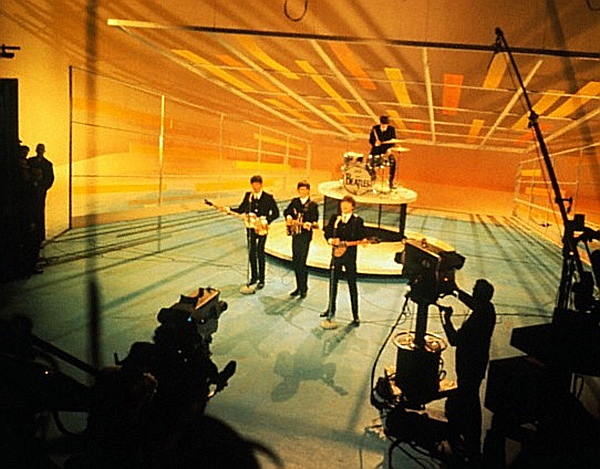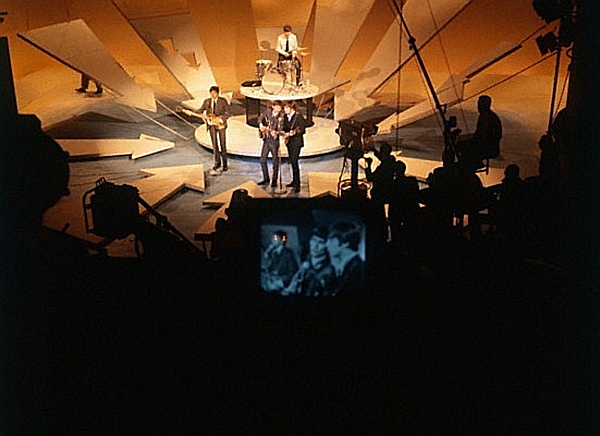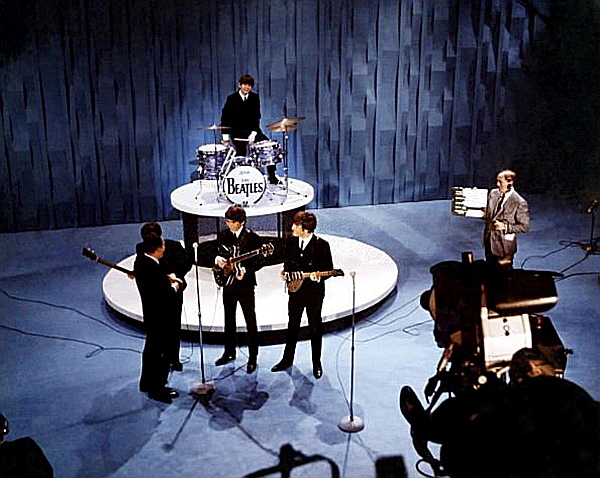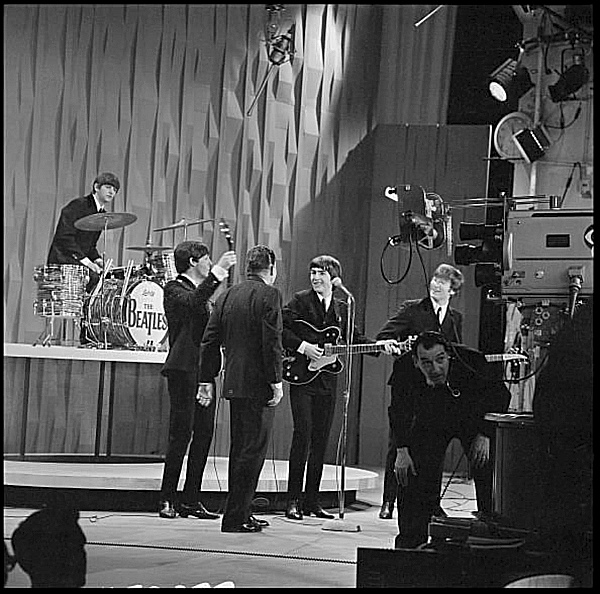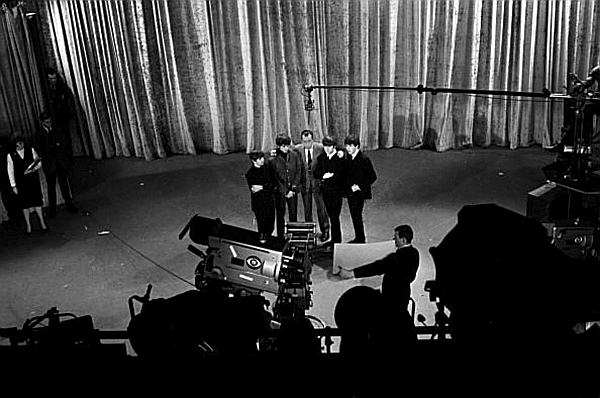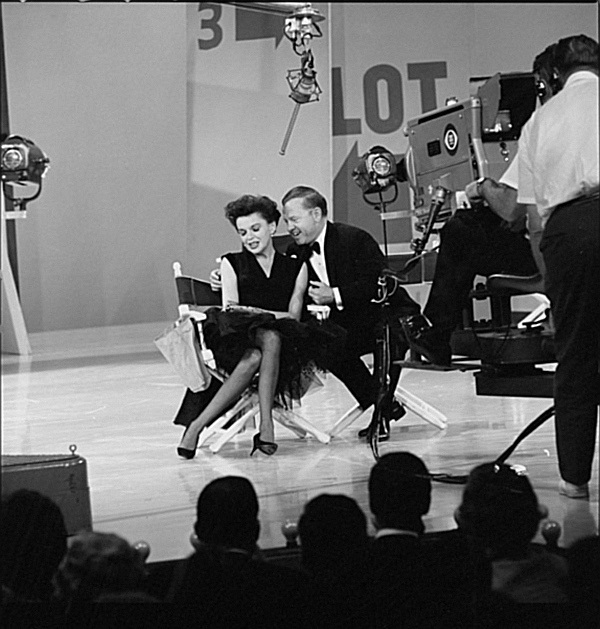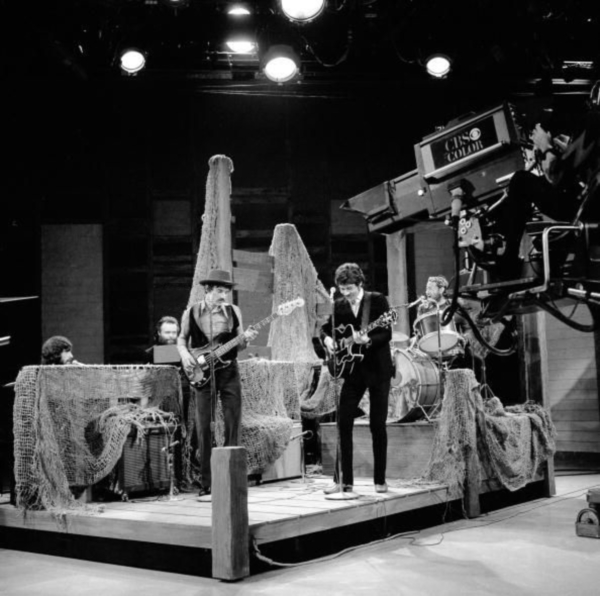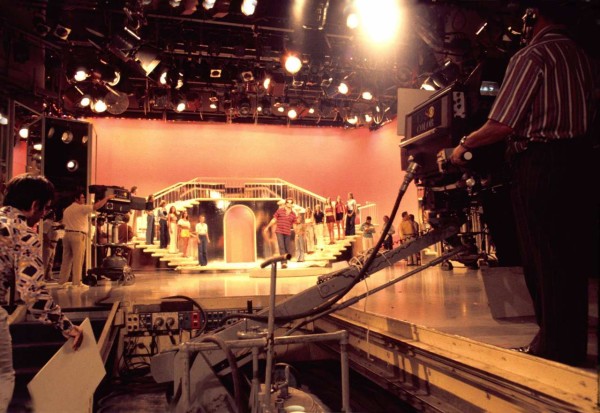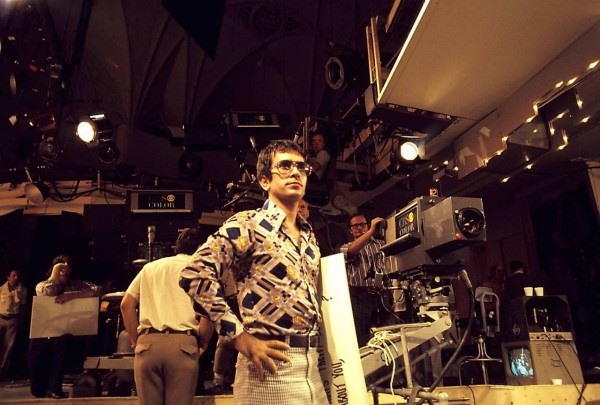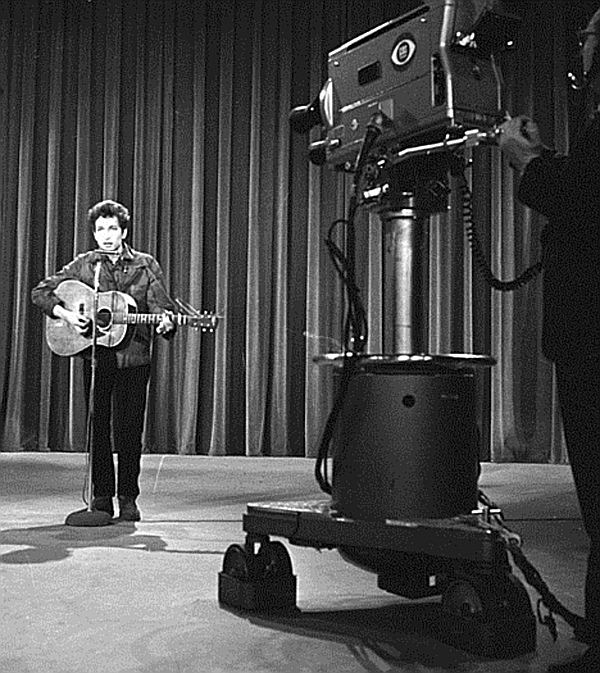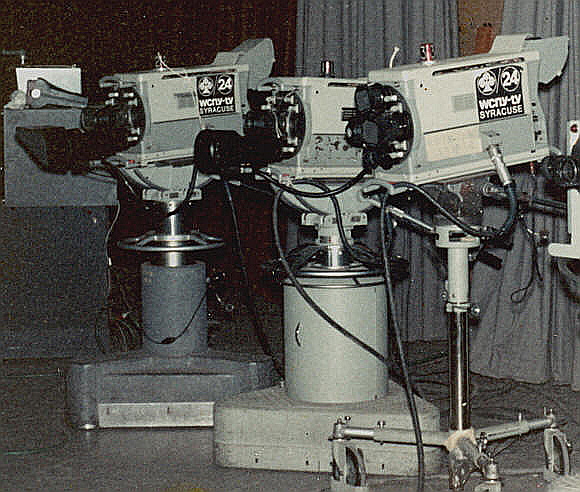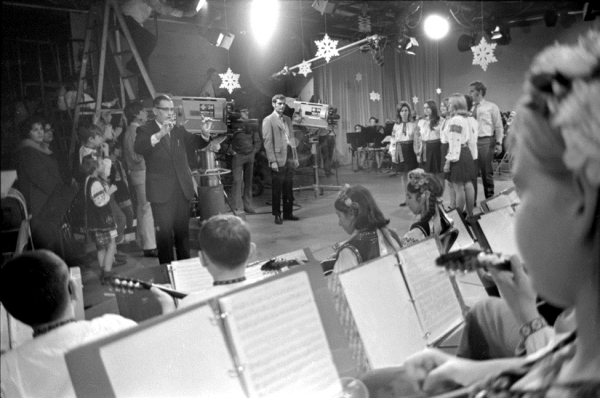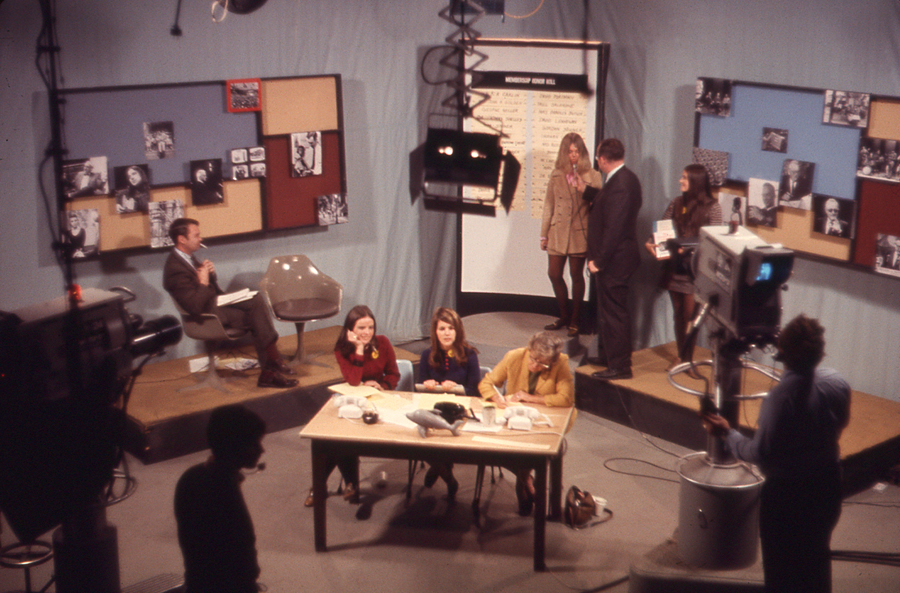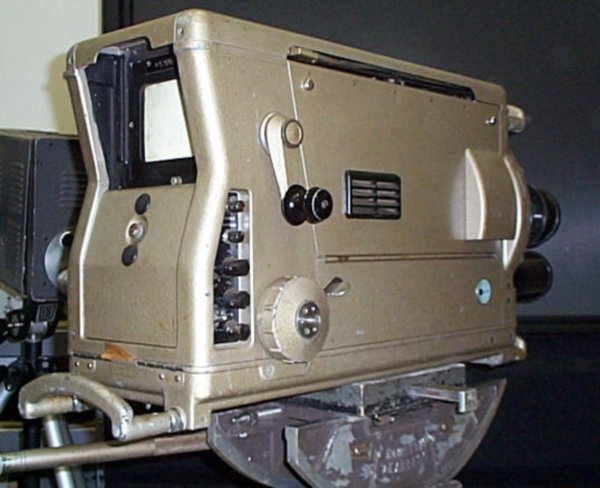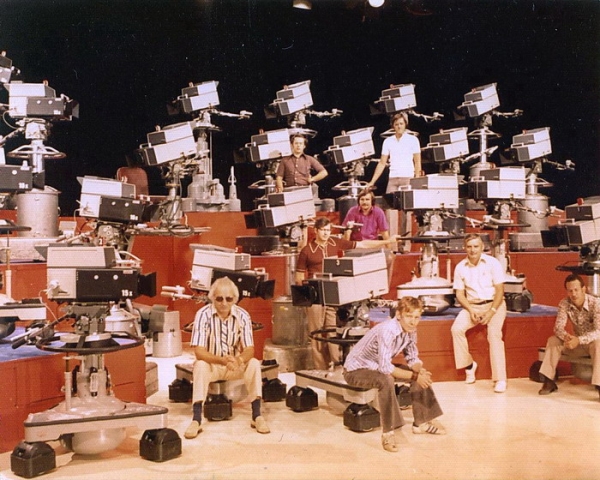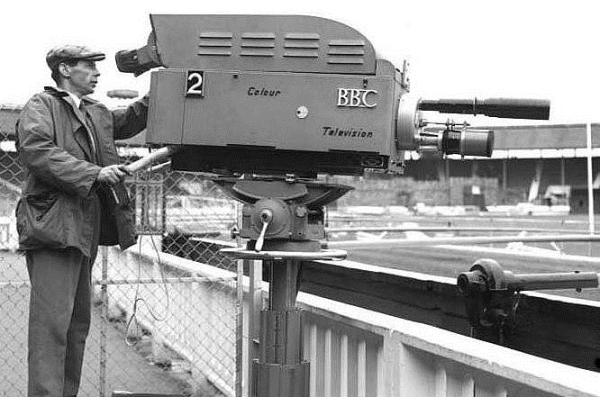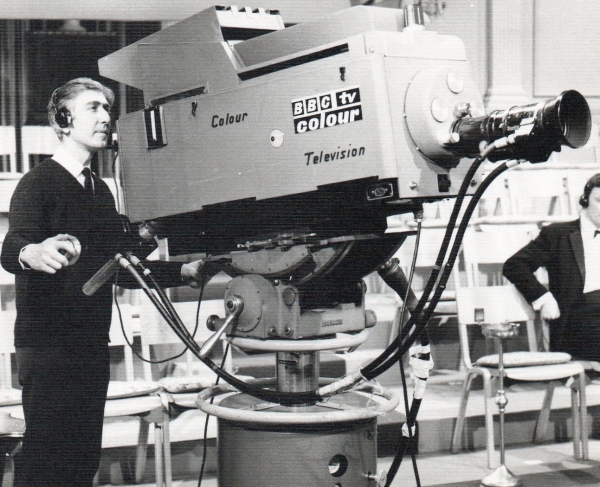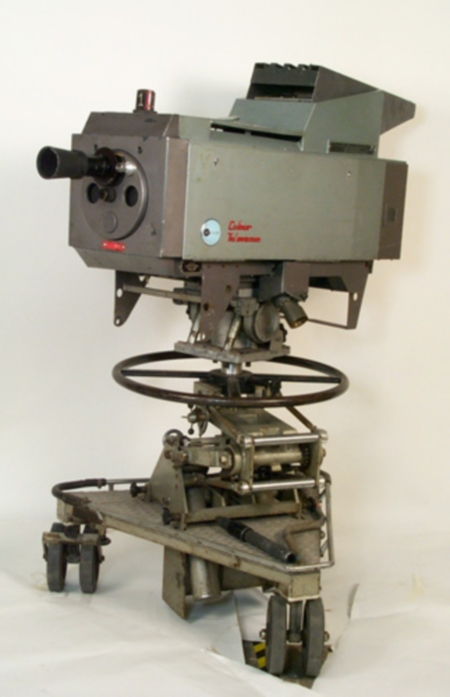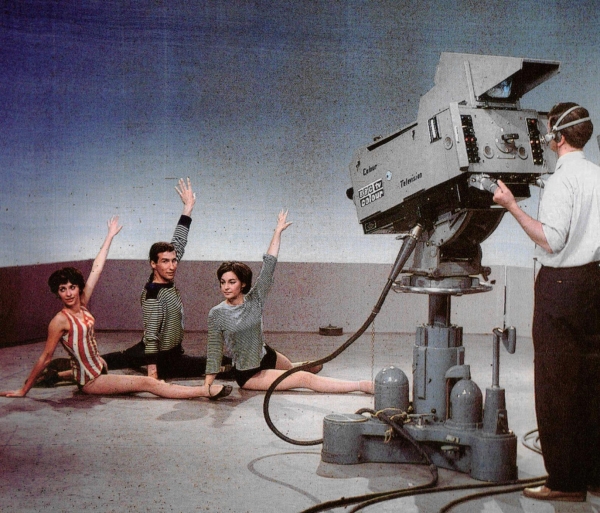- Home
- TV History
- Network Studios History
- Cameras
- Archives
- Viewseum
- About / Comments
Skip to content


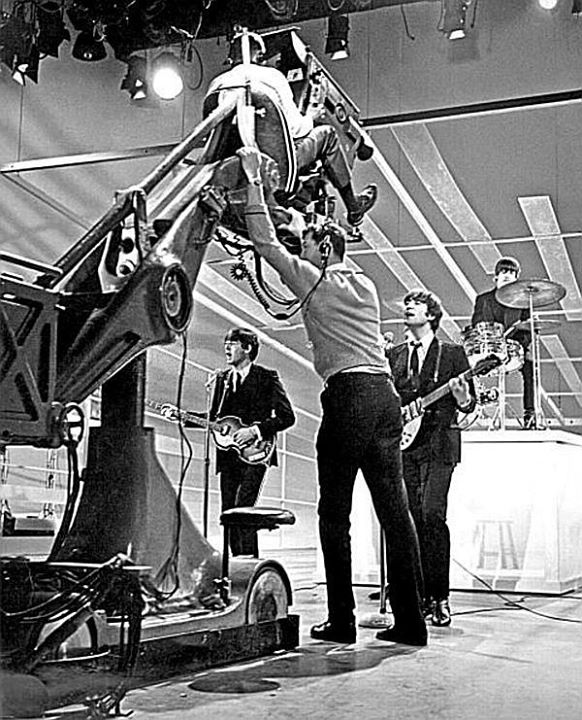

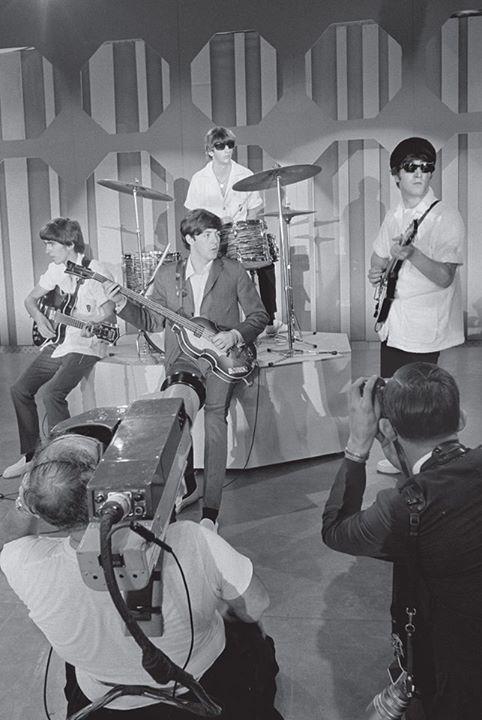

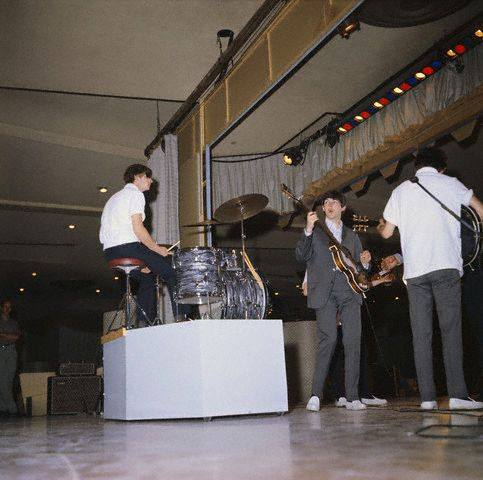

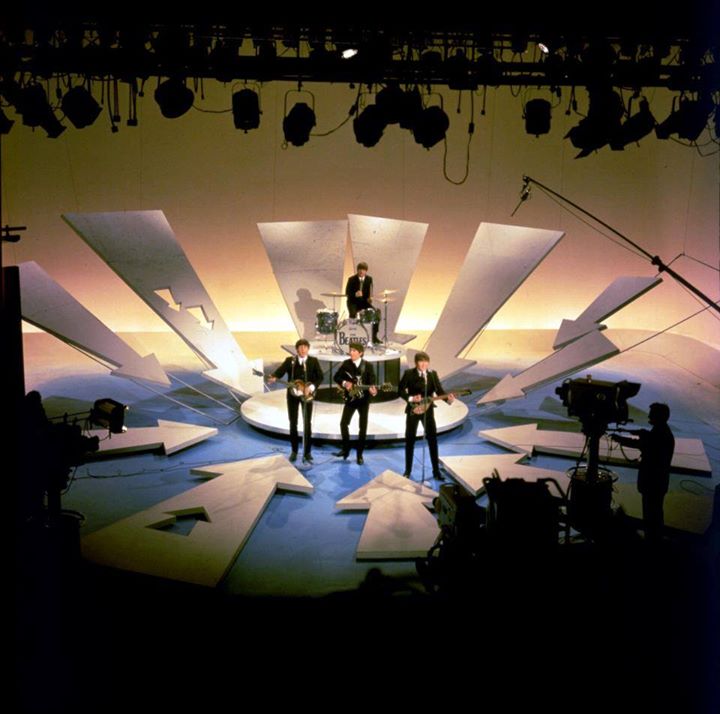

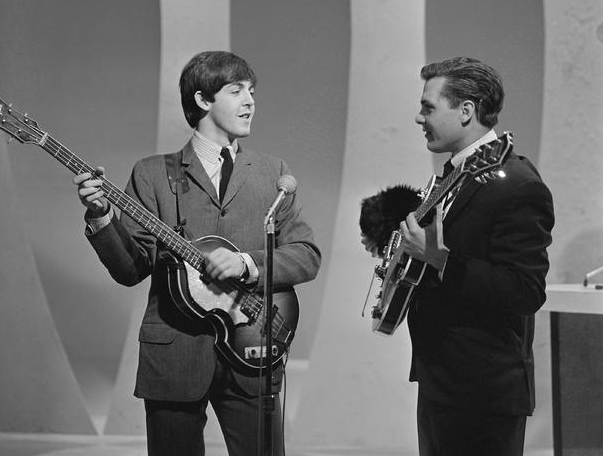





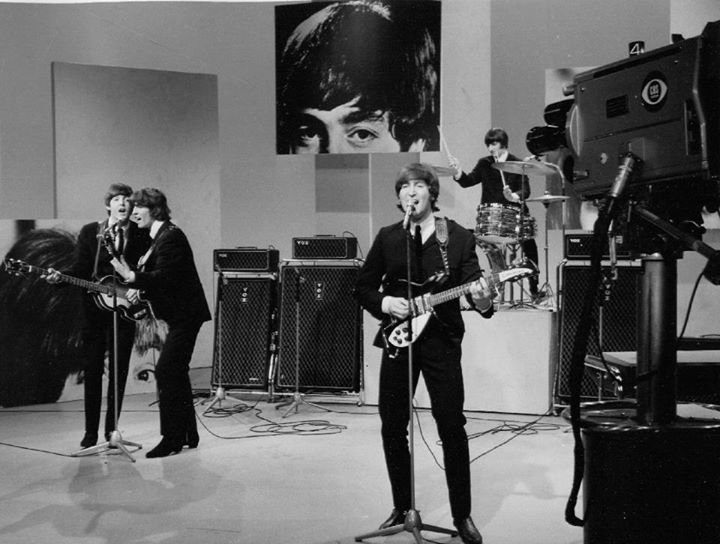

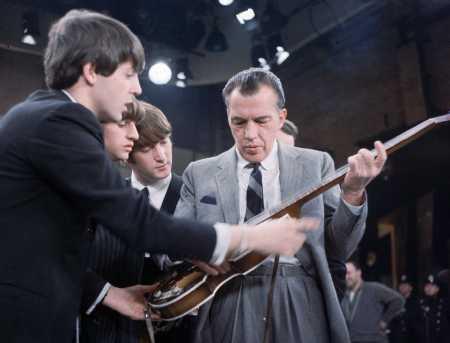



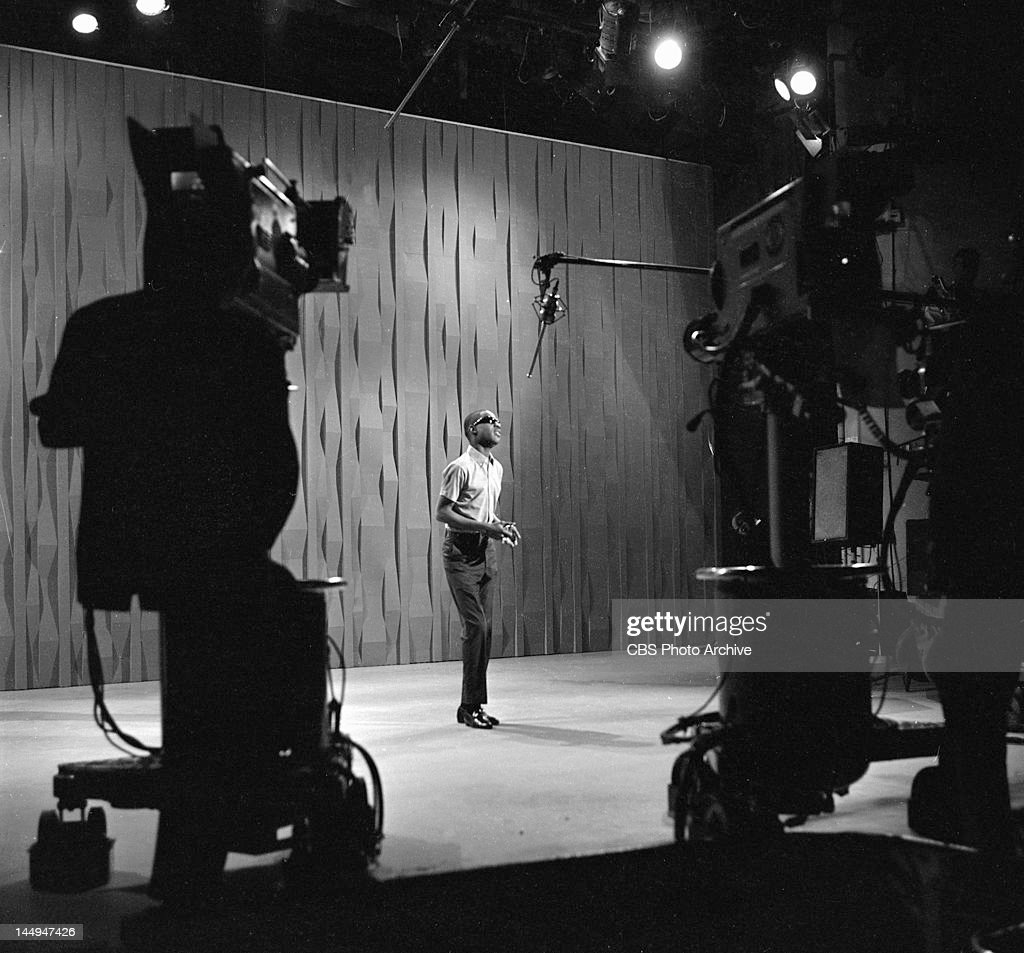



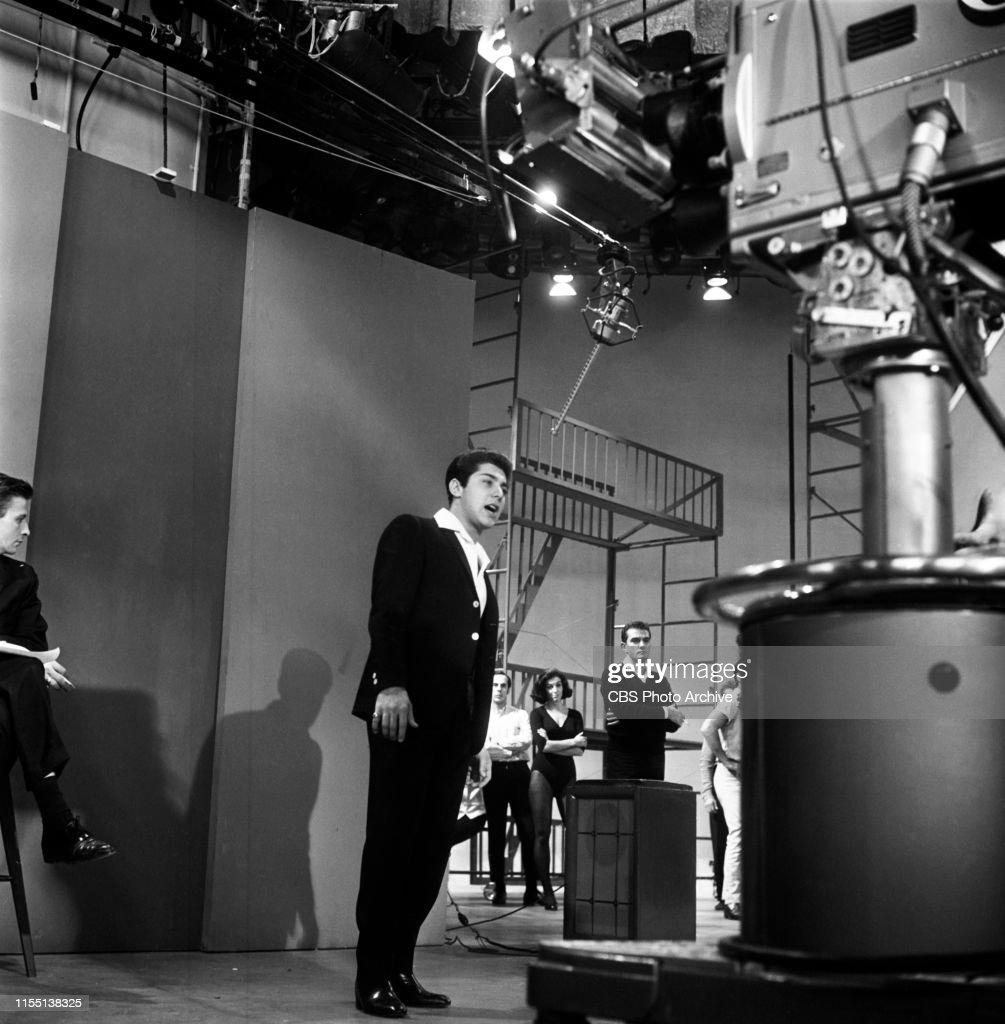
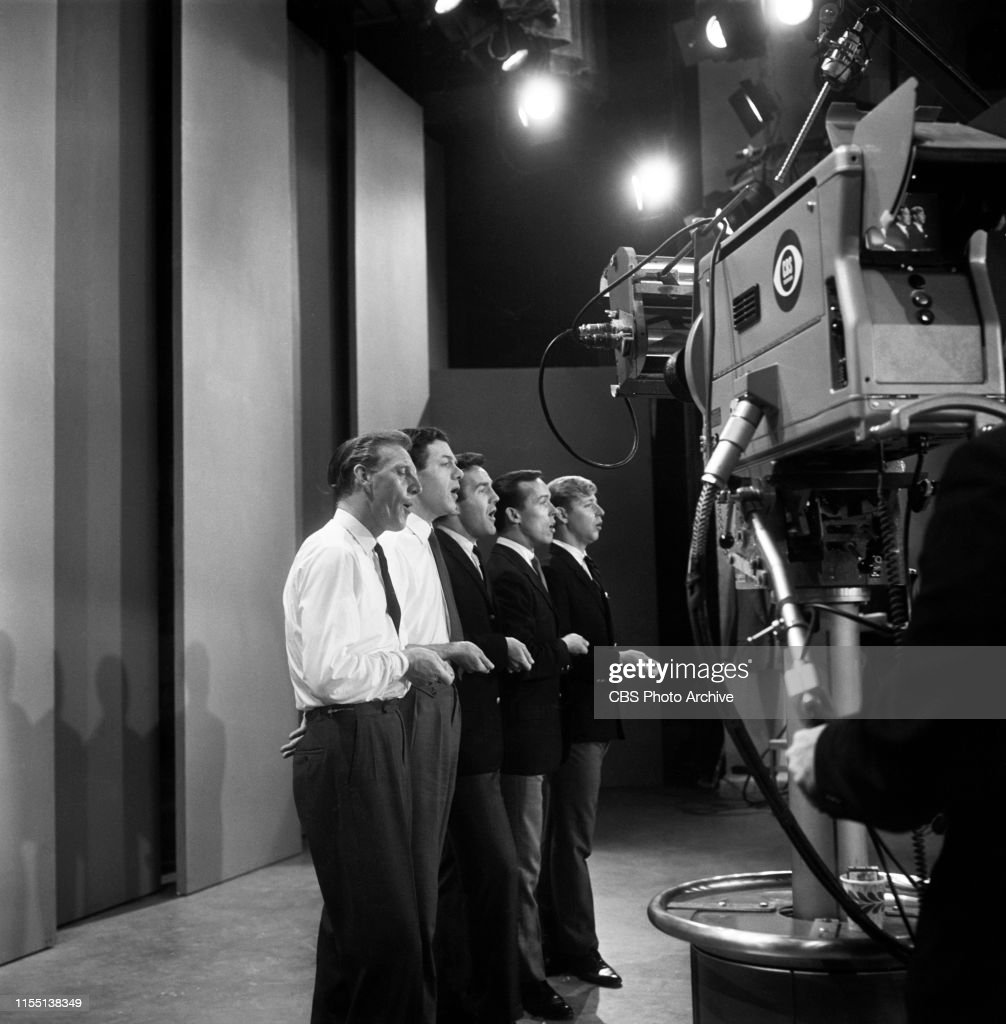
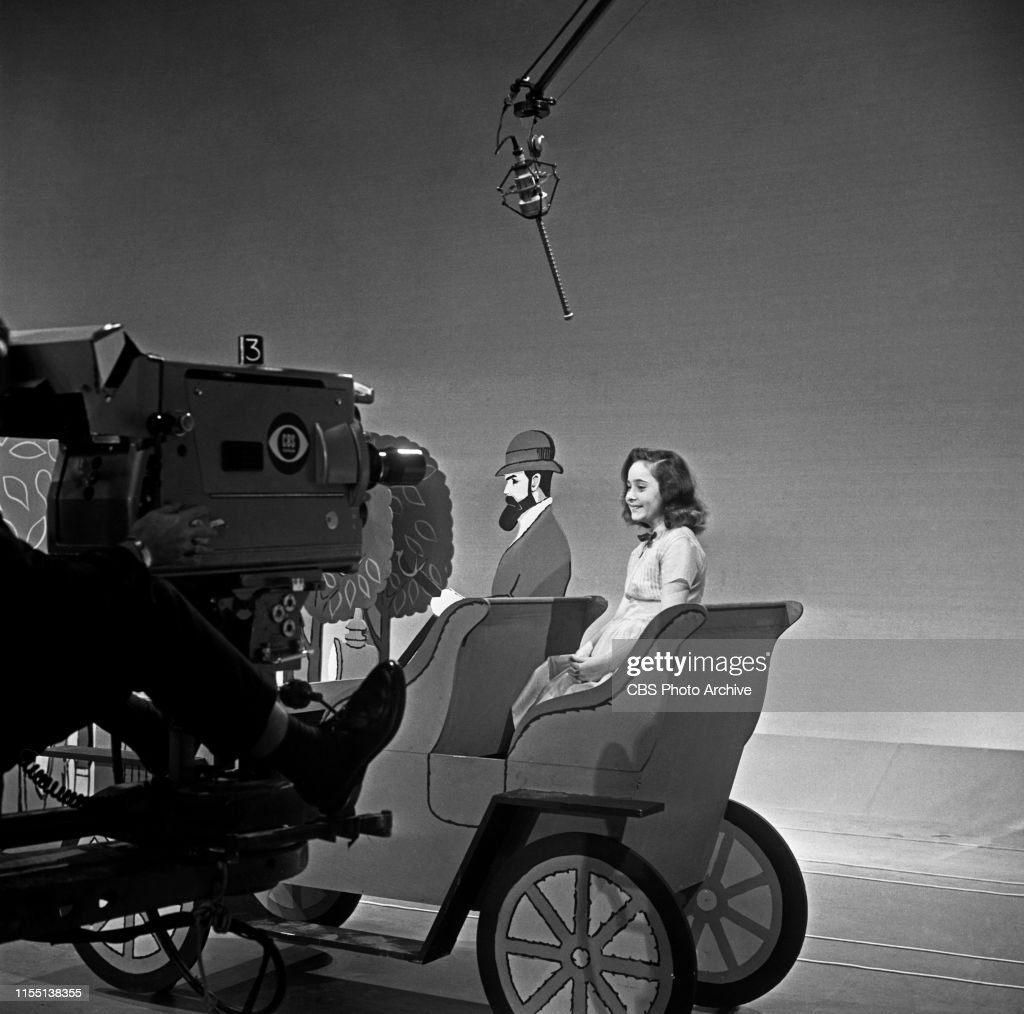
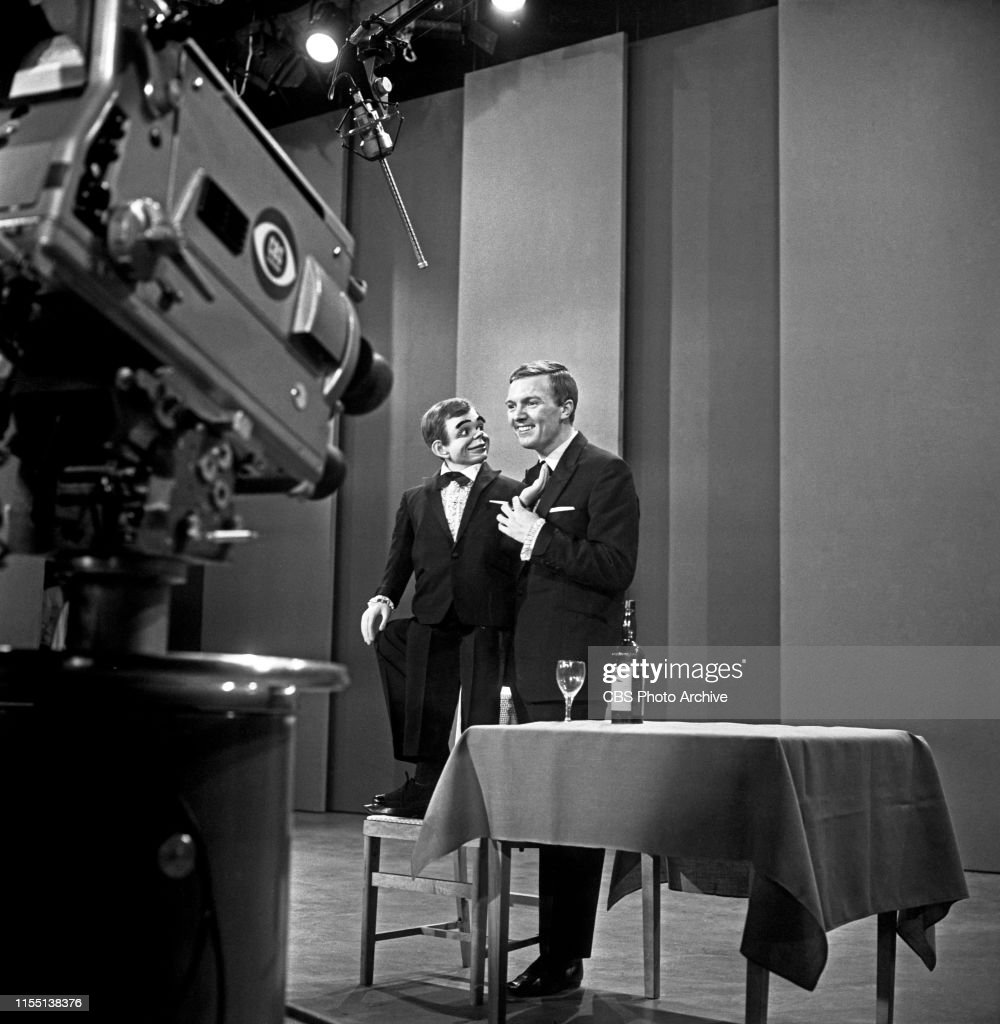


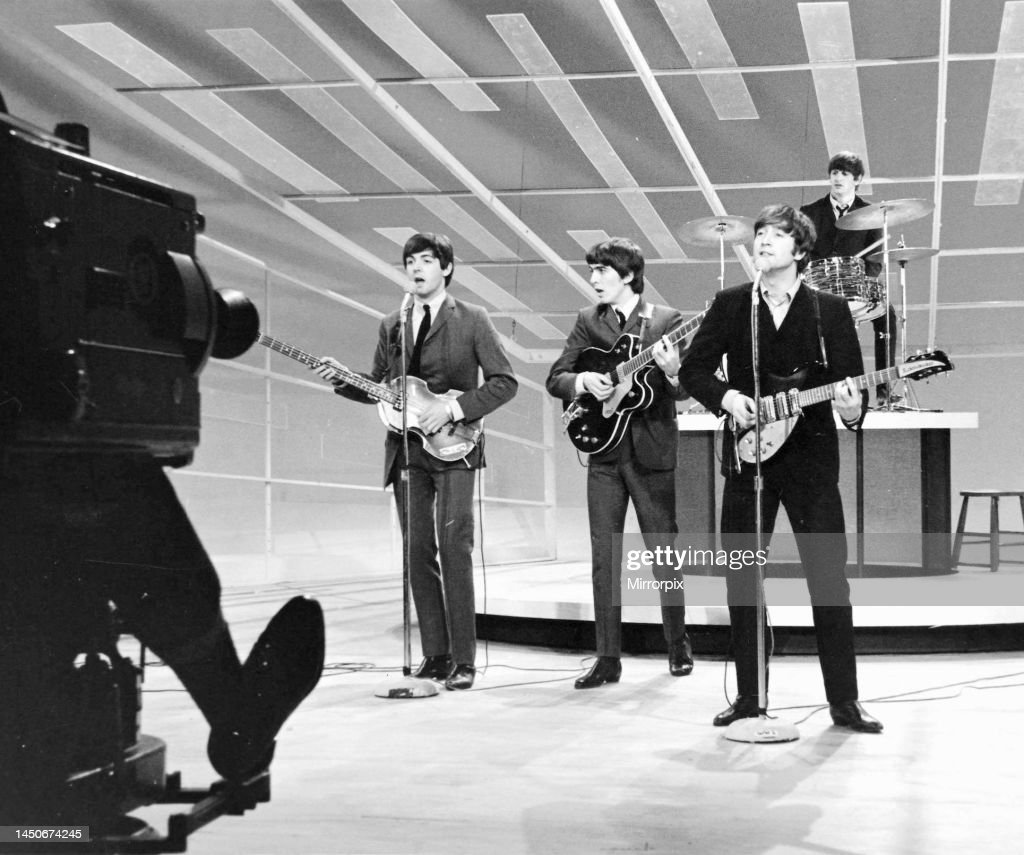

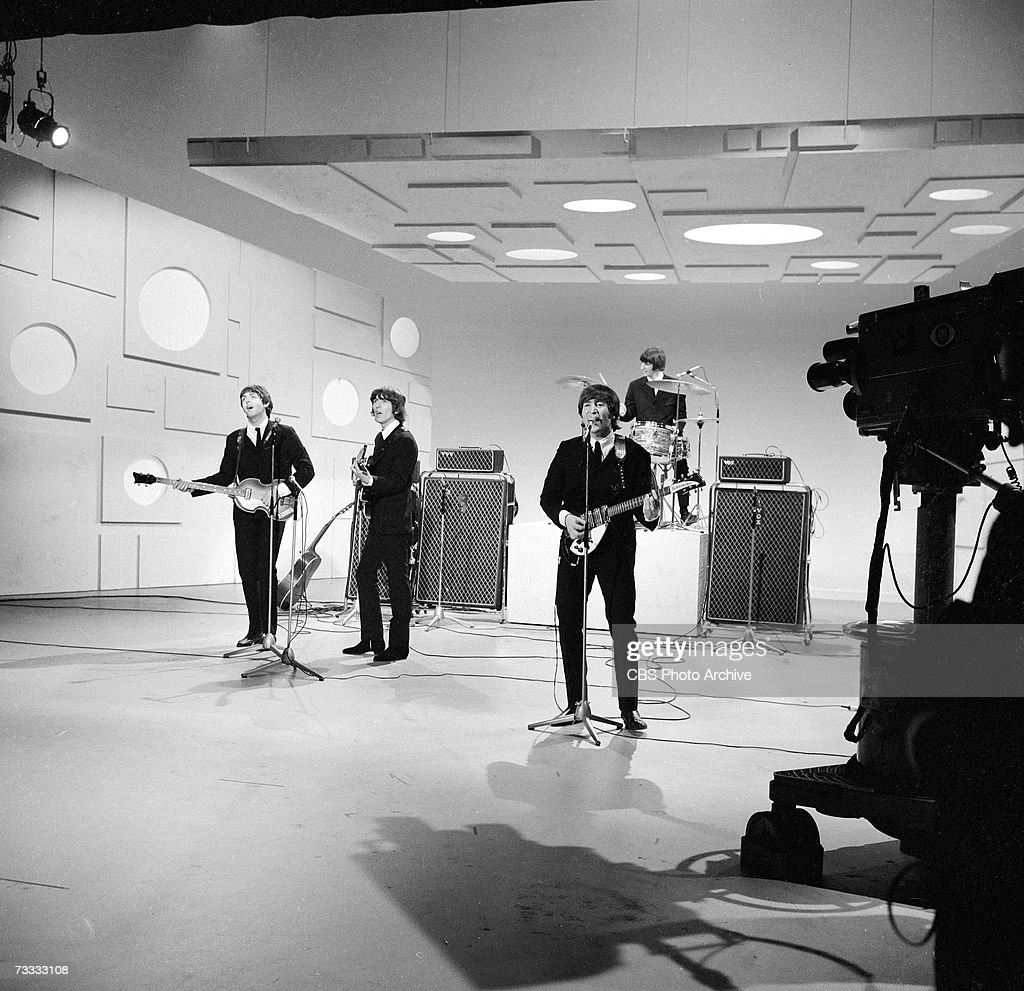
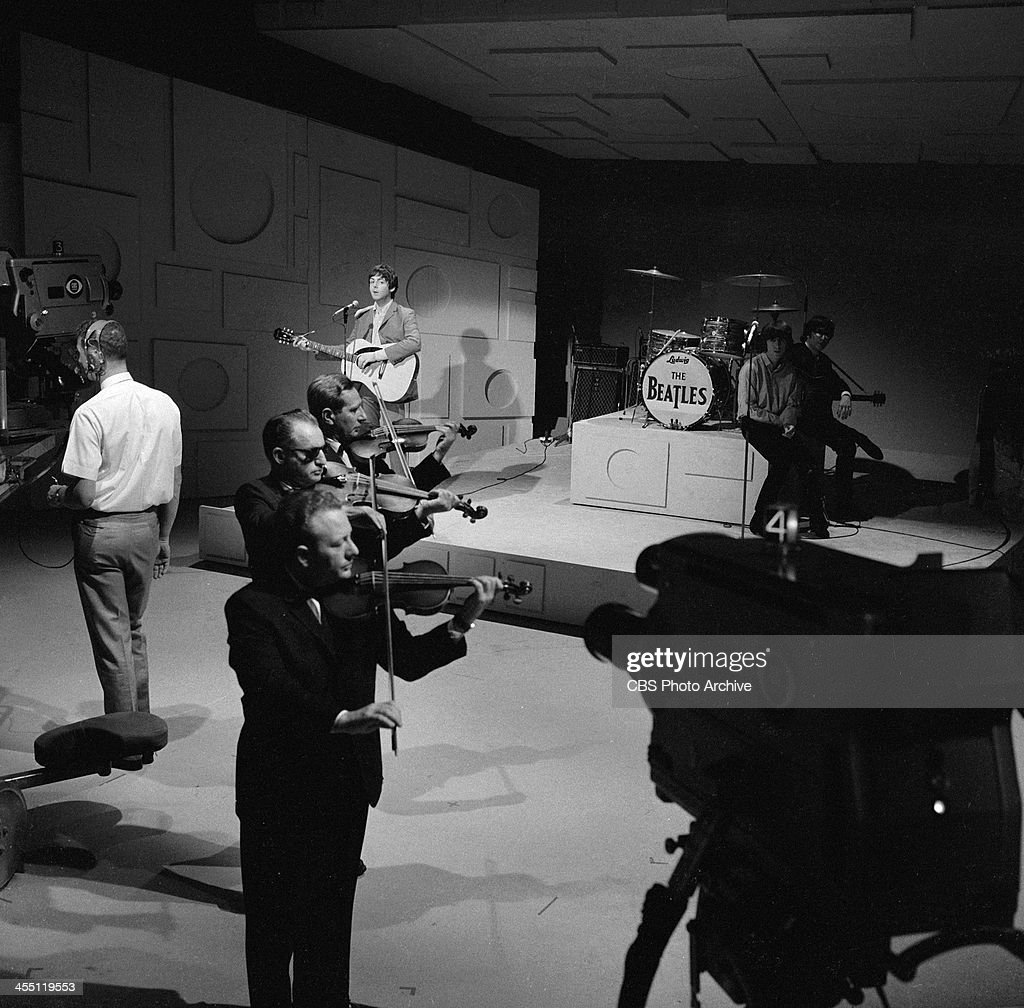
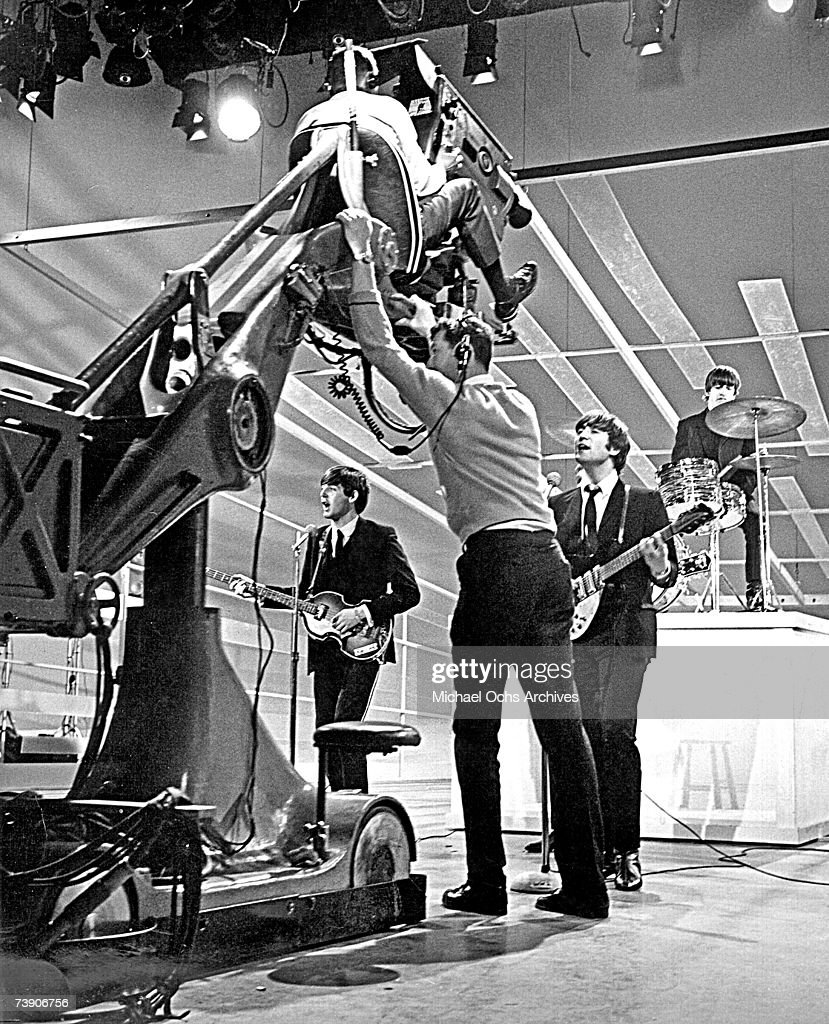
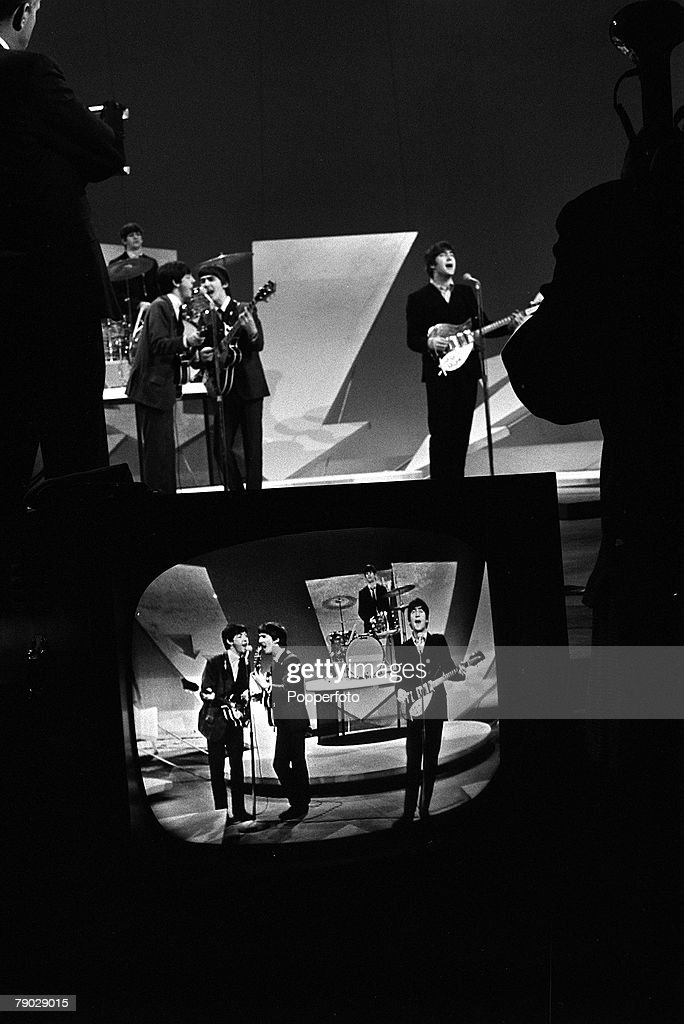

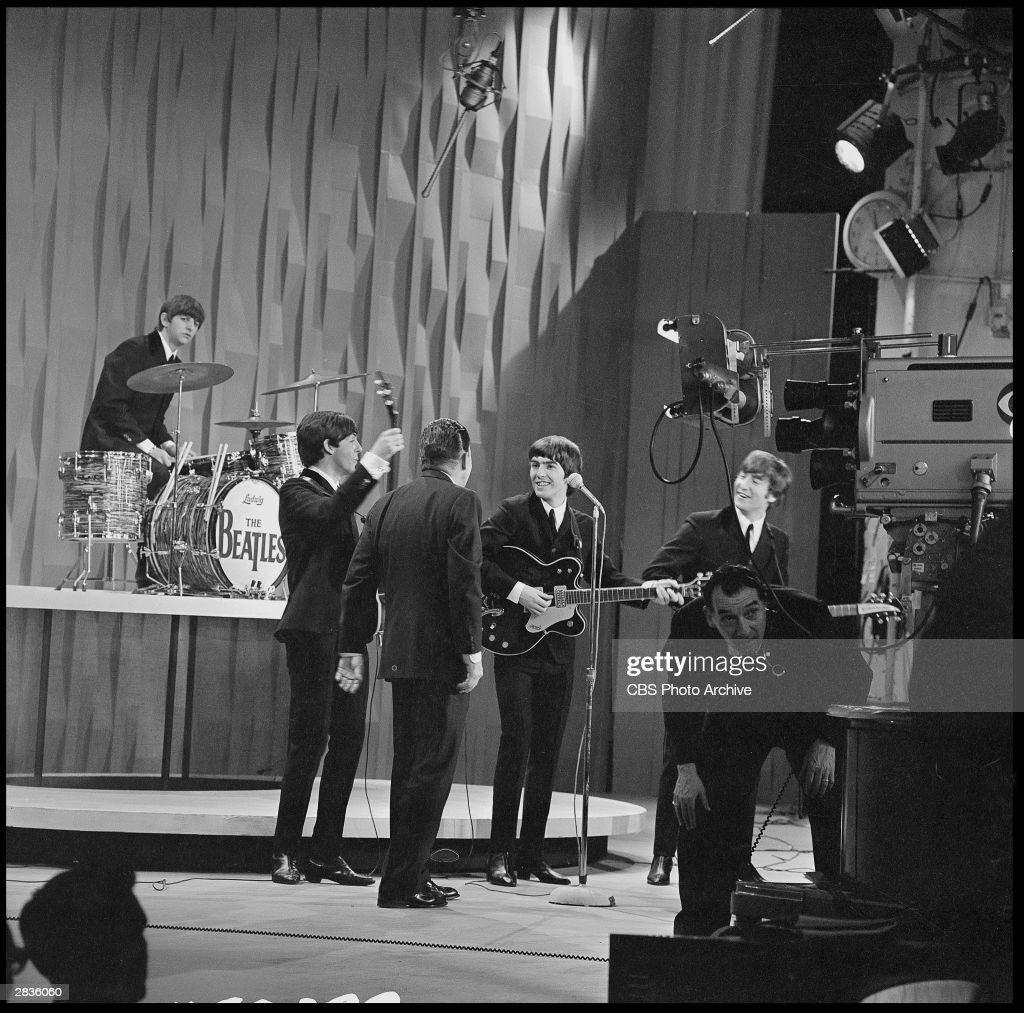
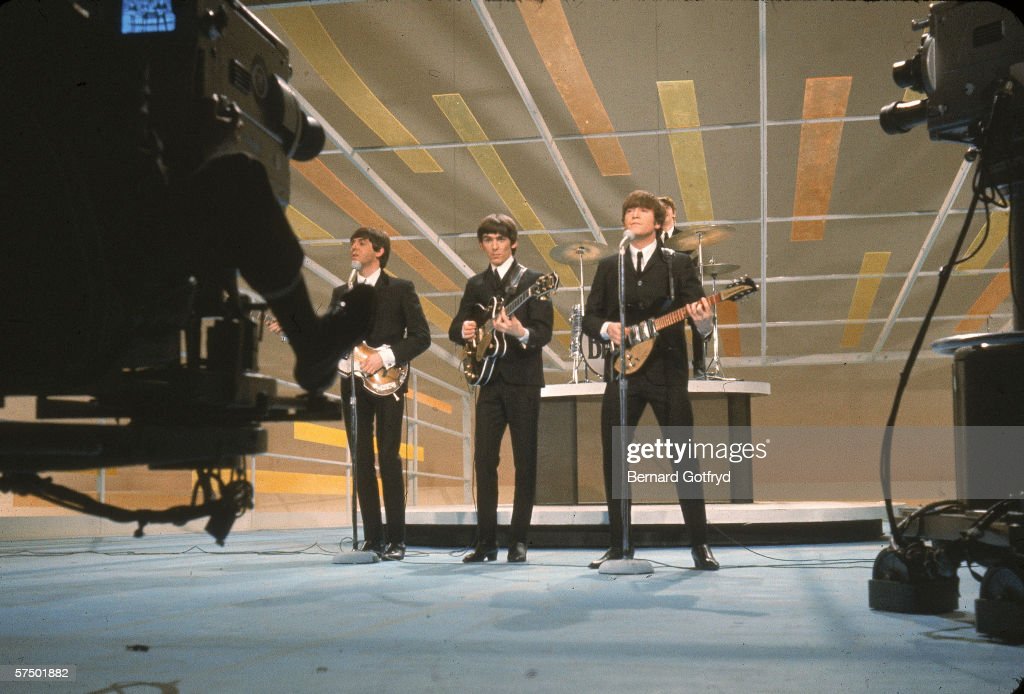
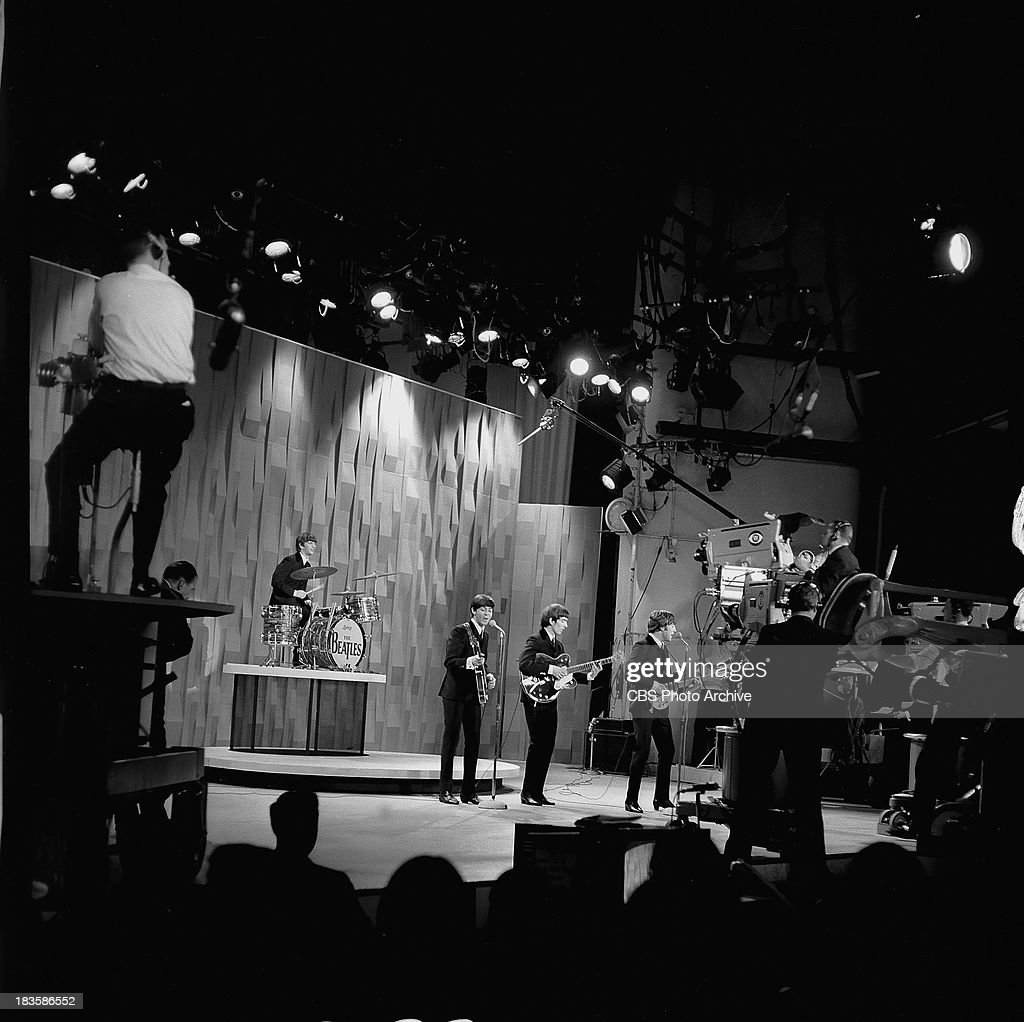

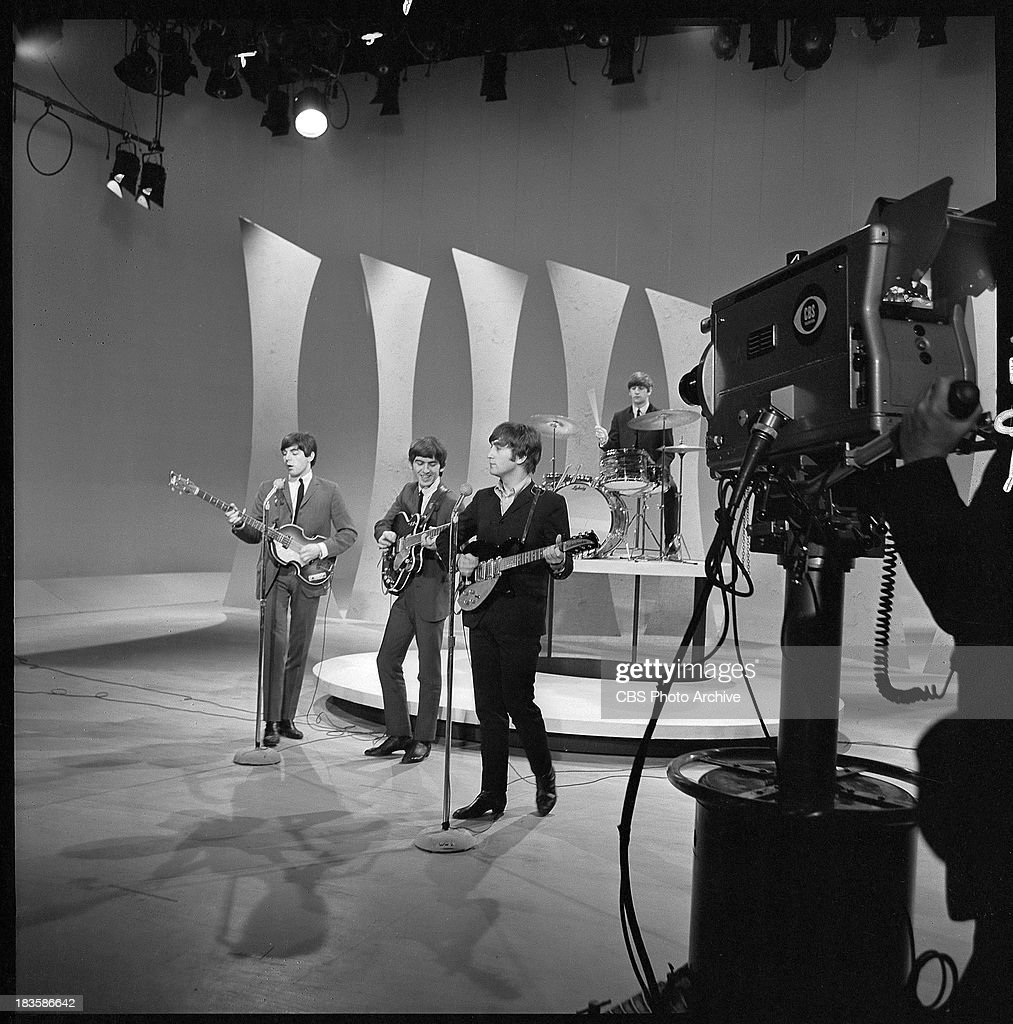
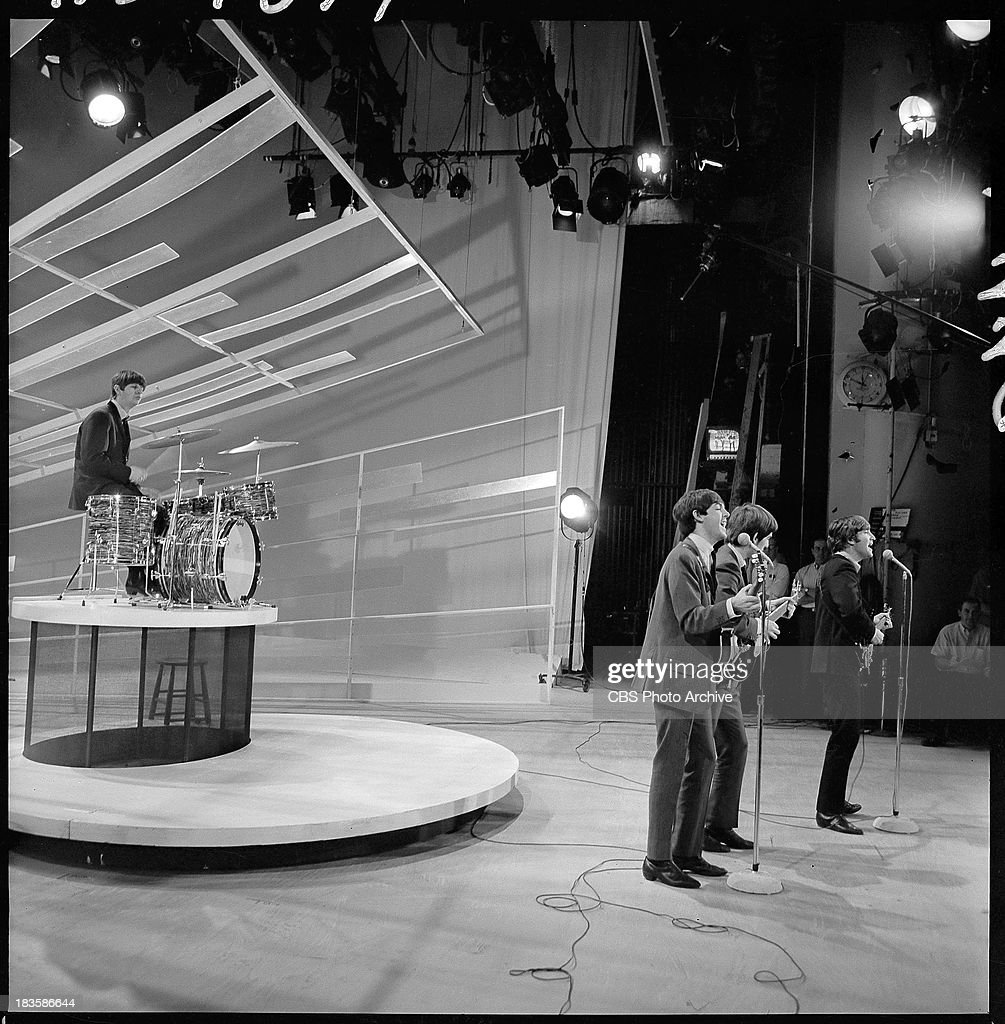
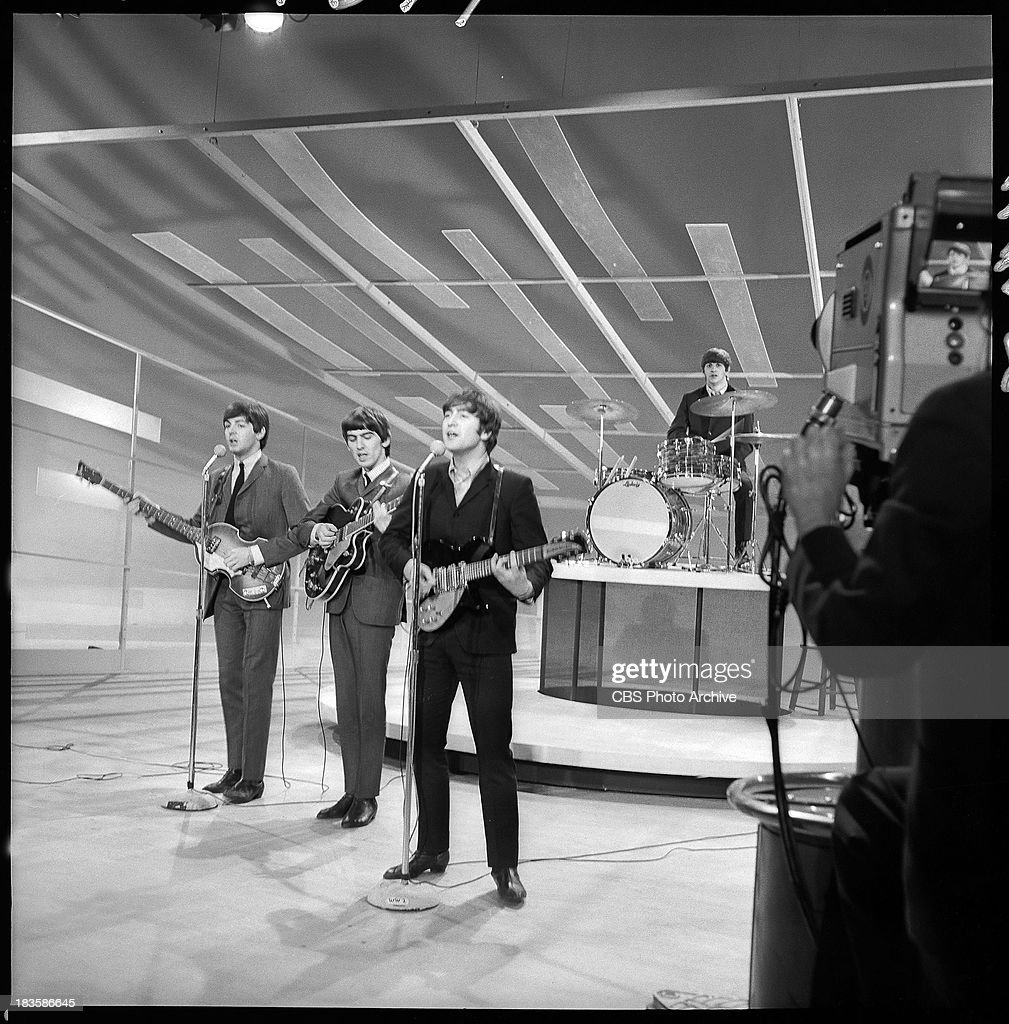


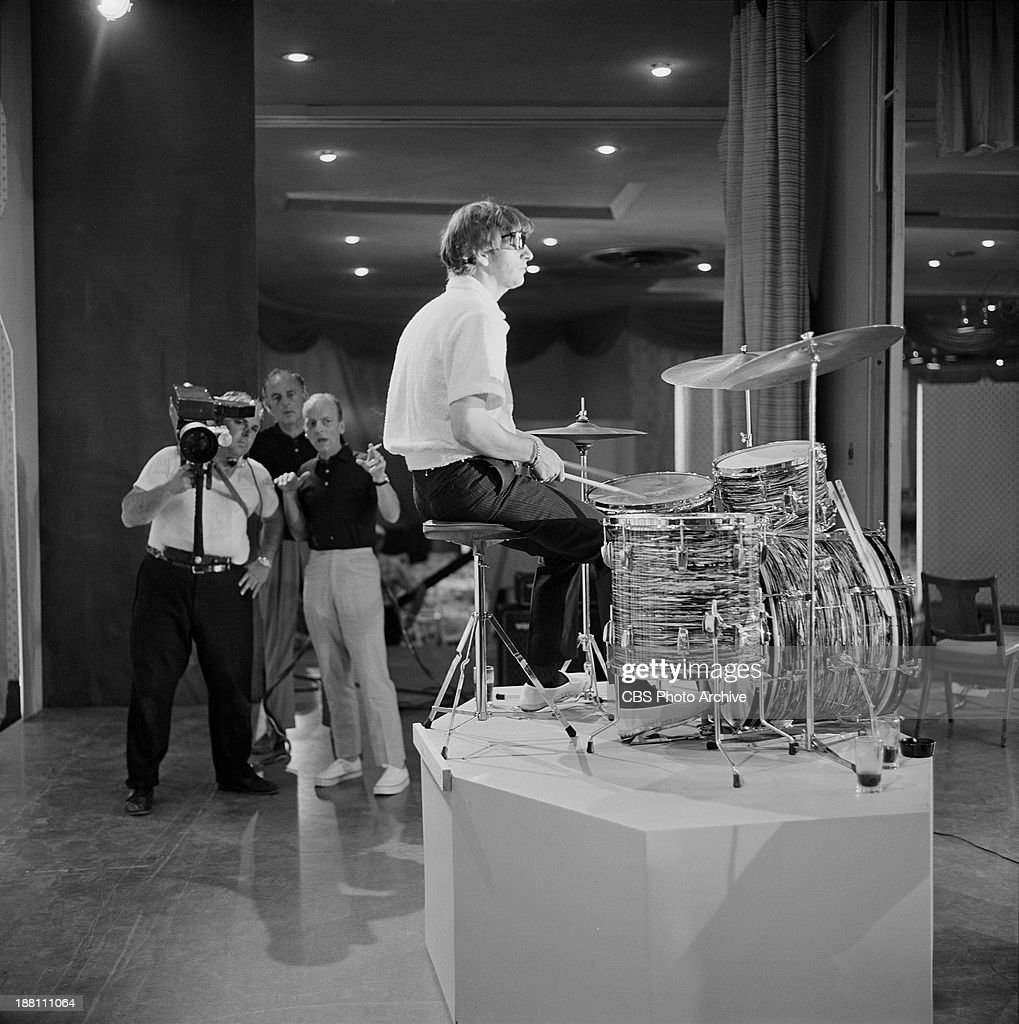

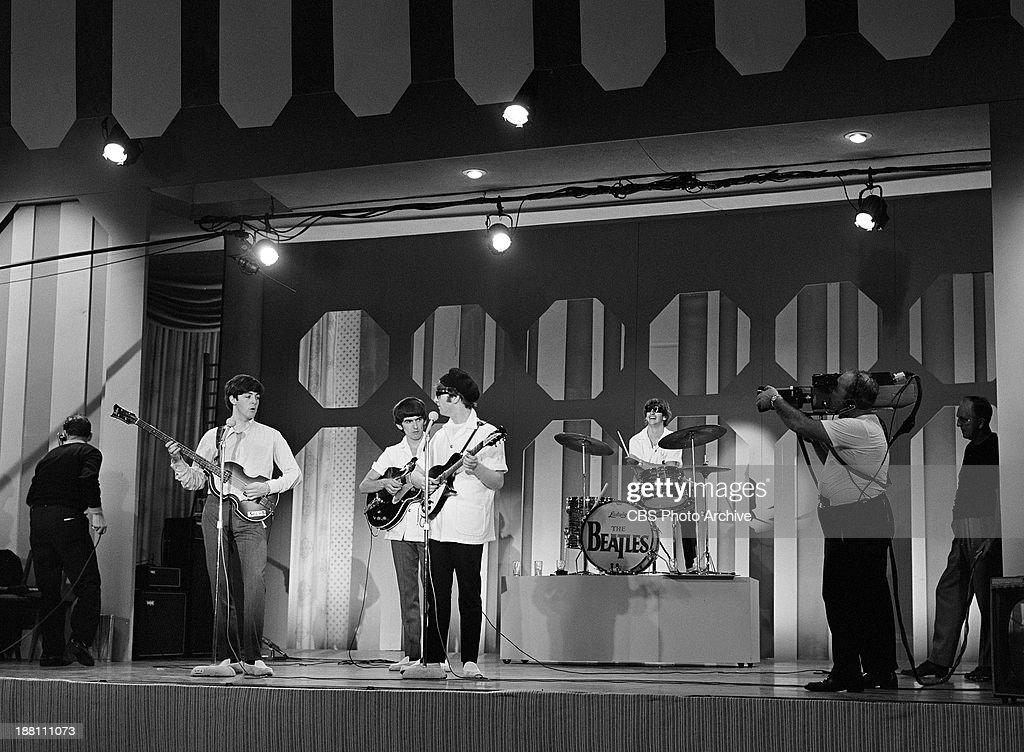
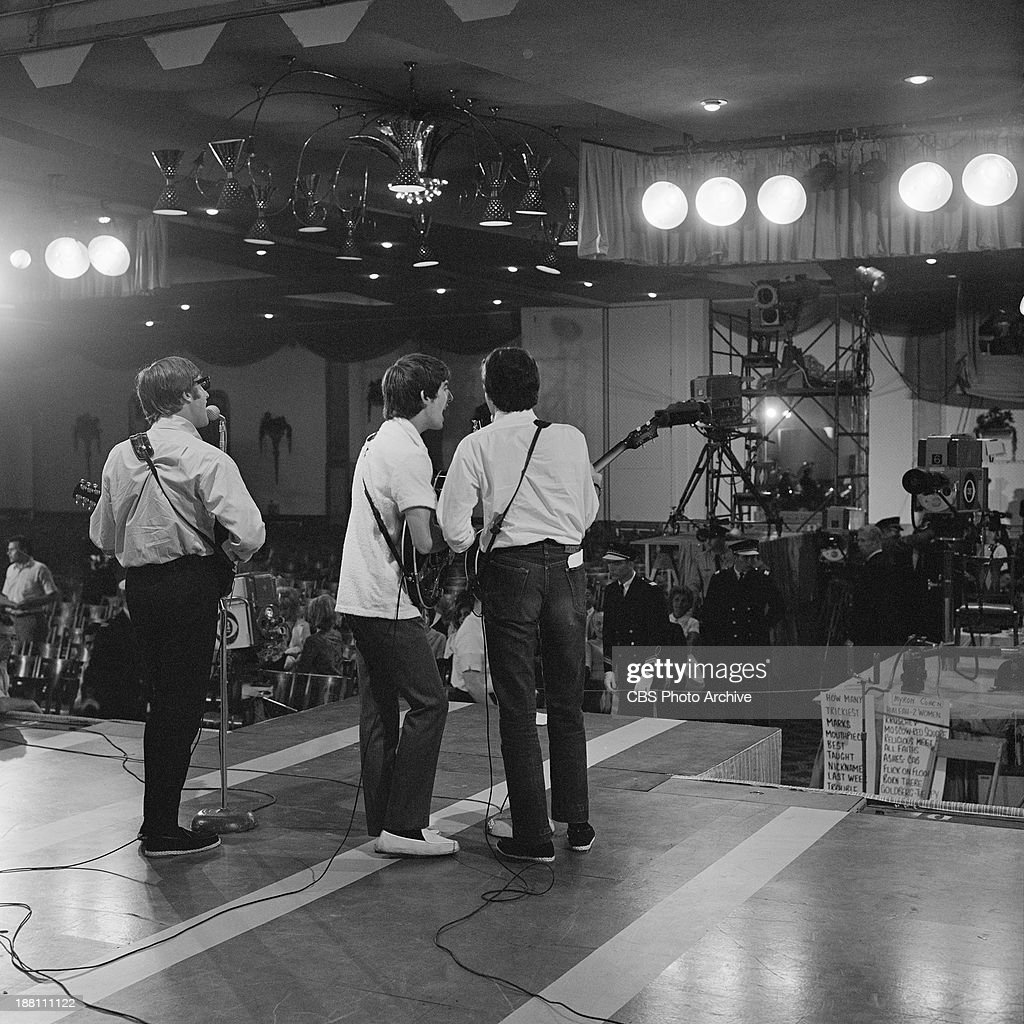
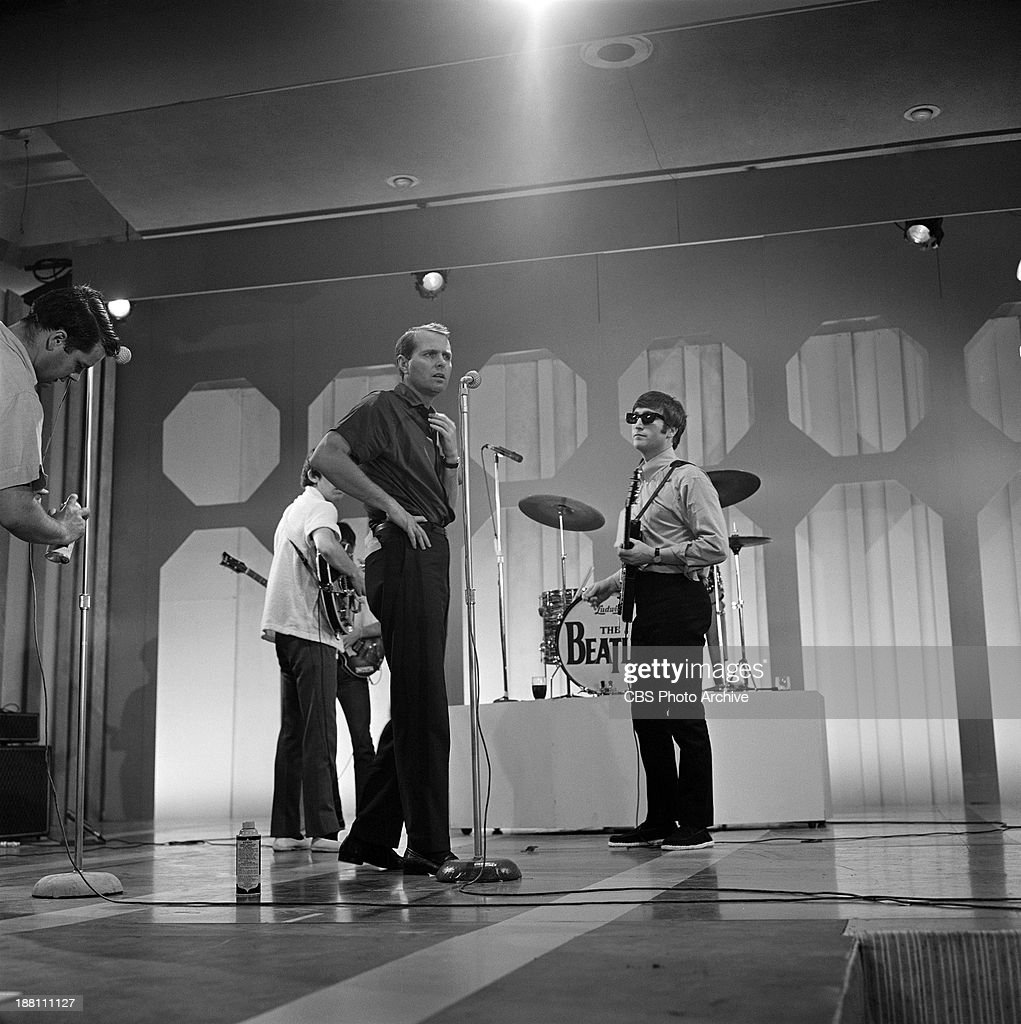
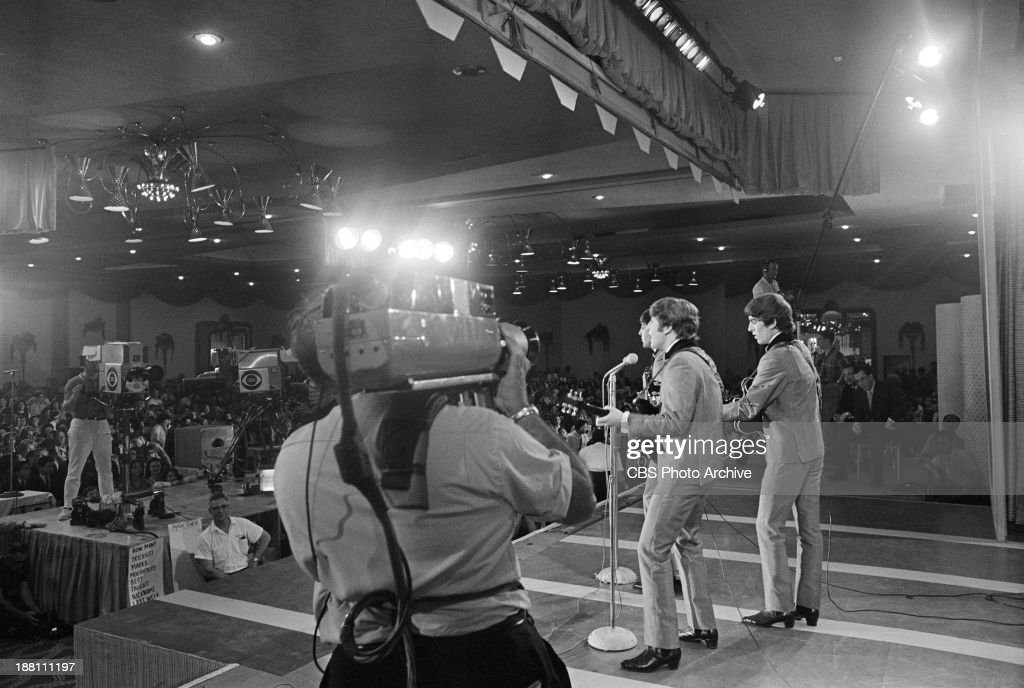
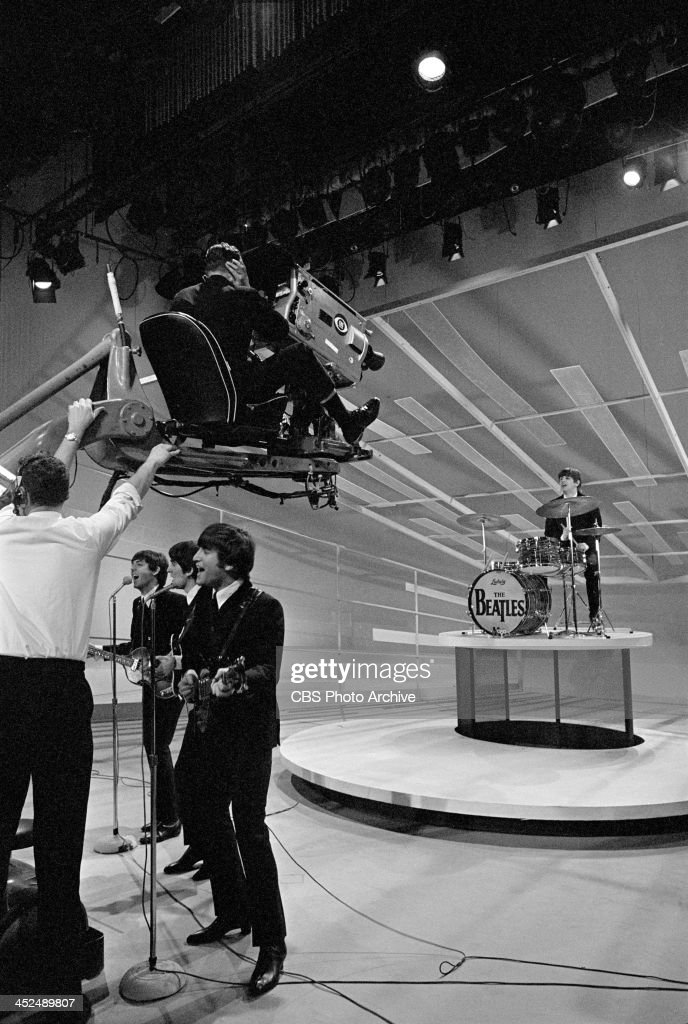
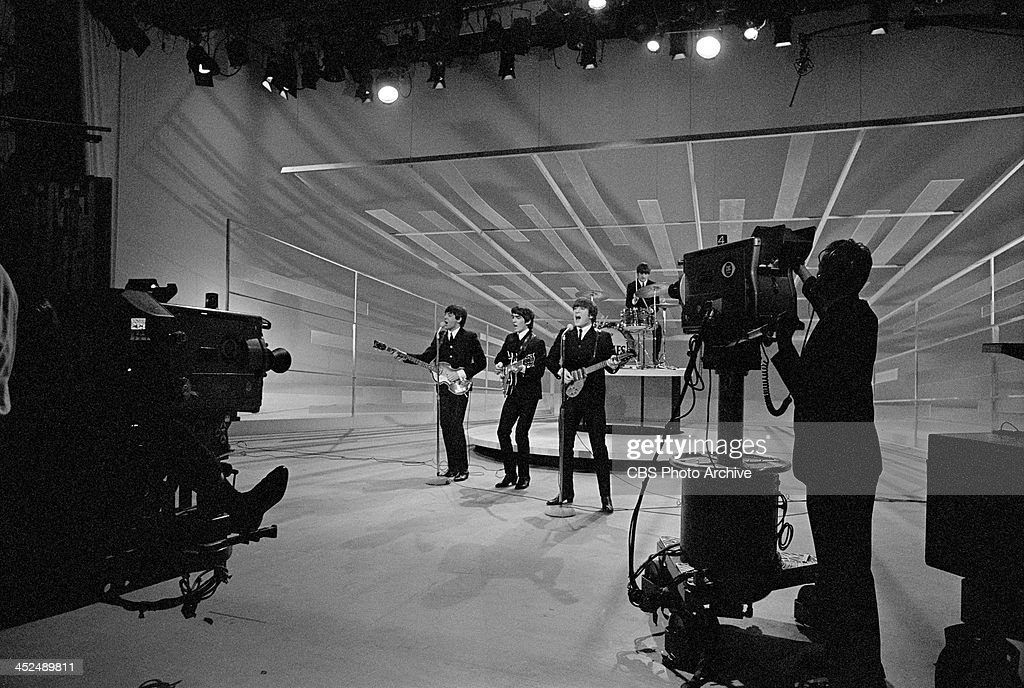
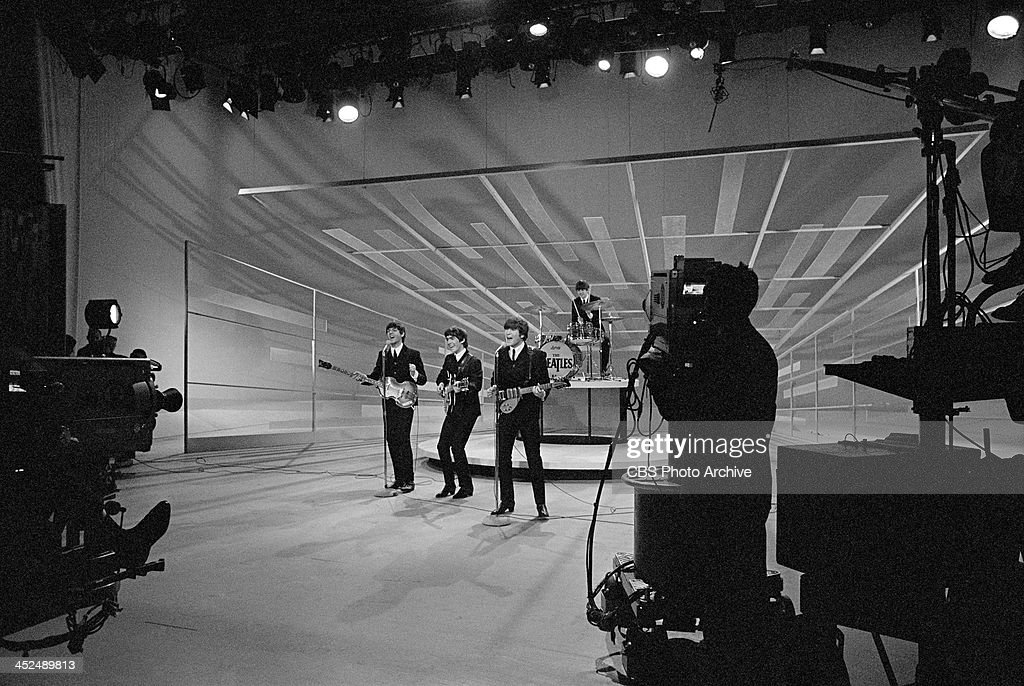

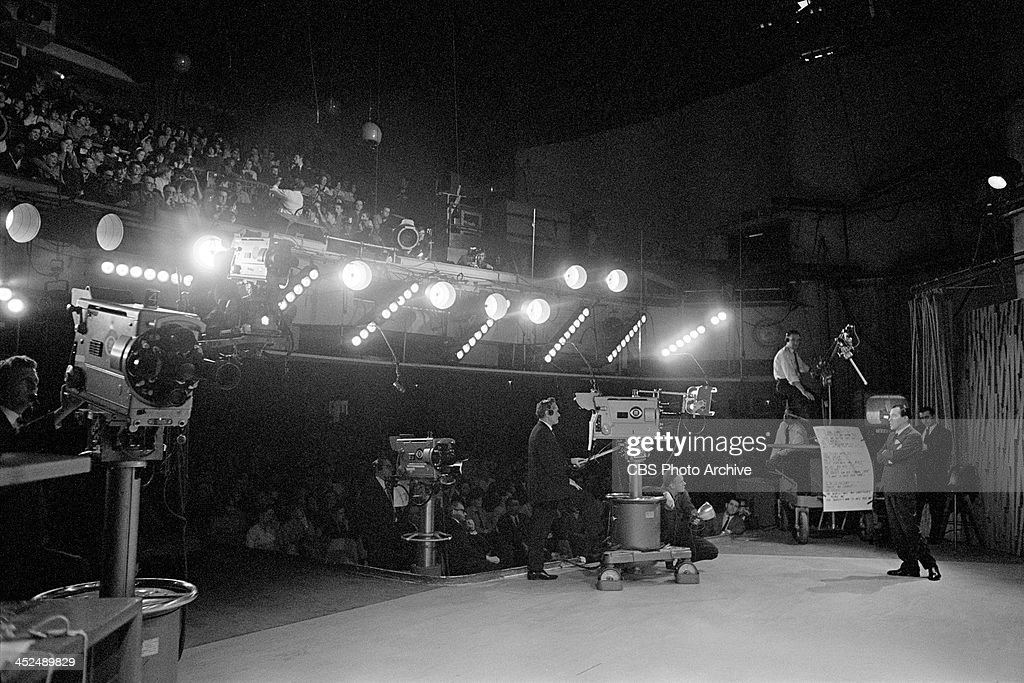

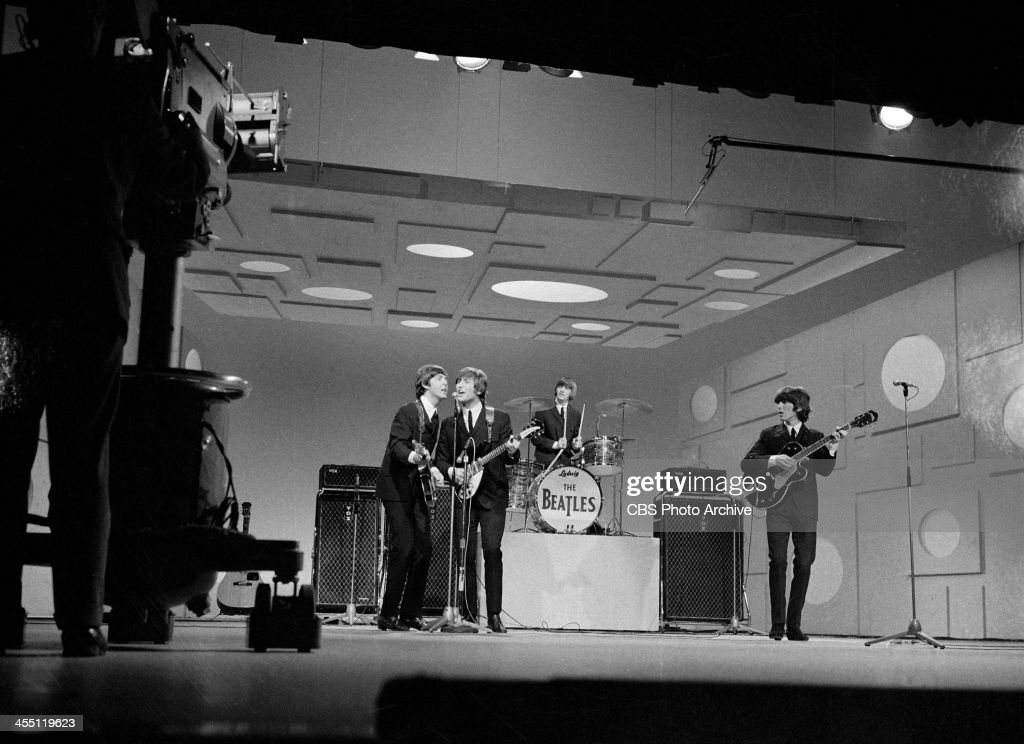
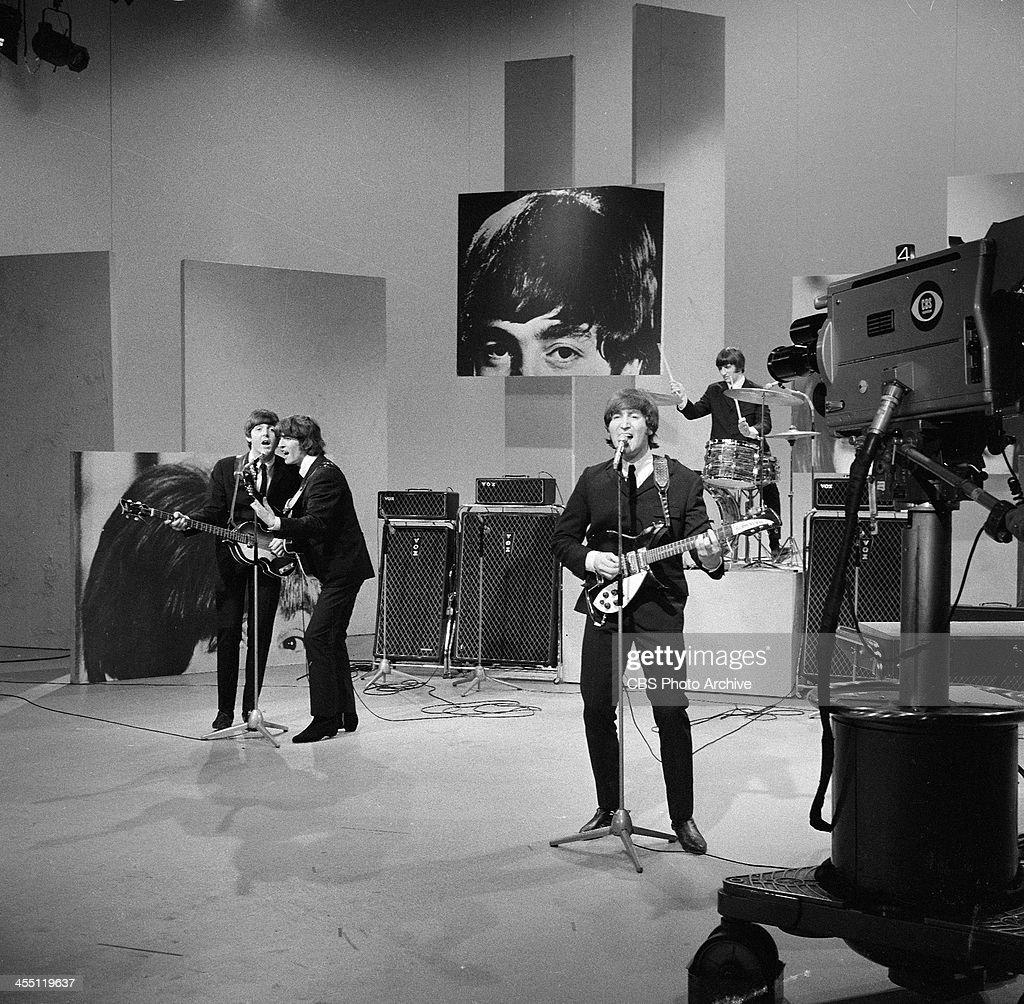
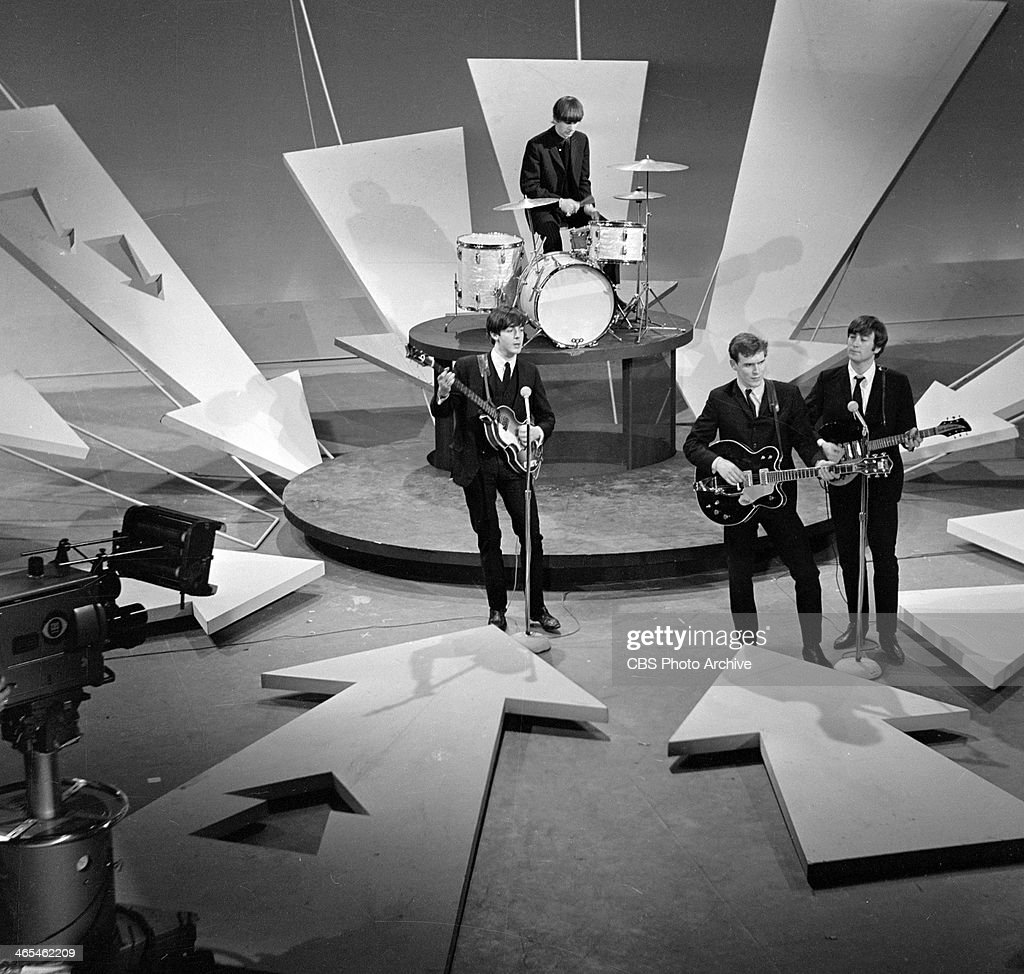
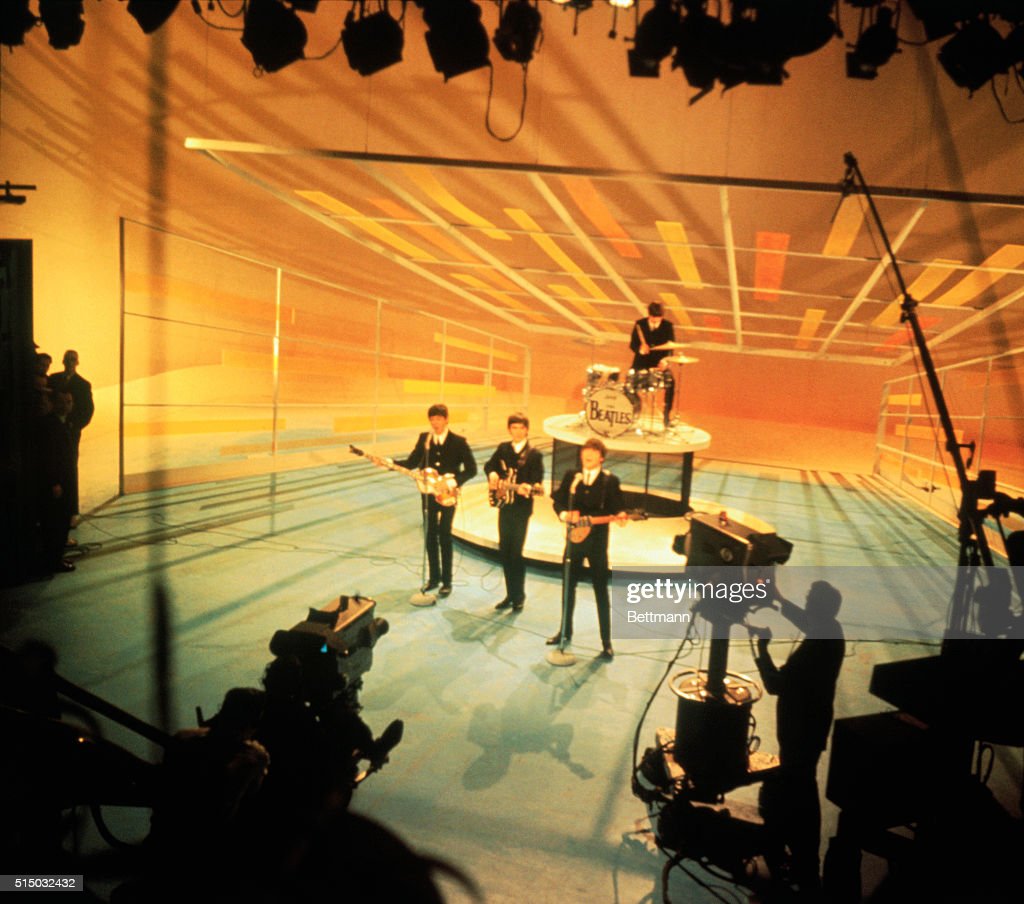
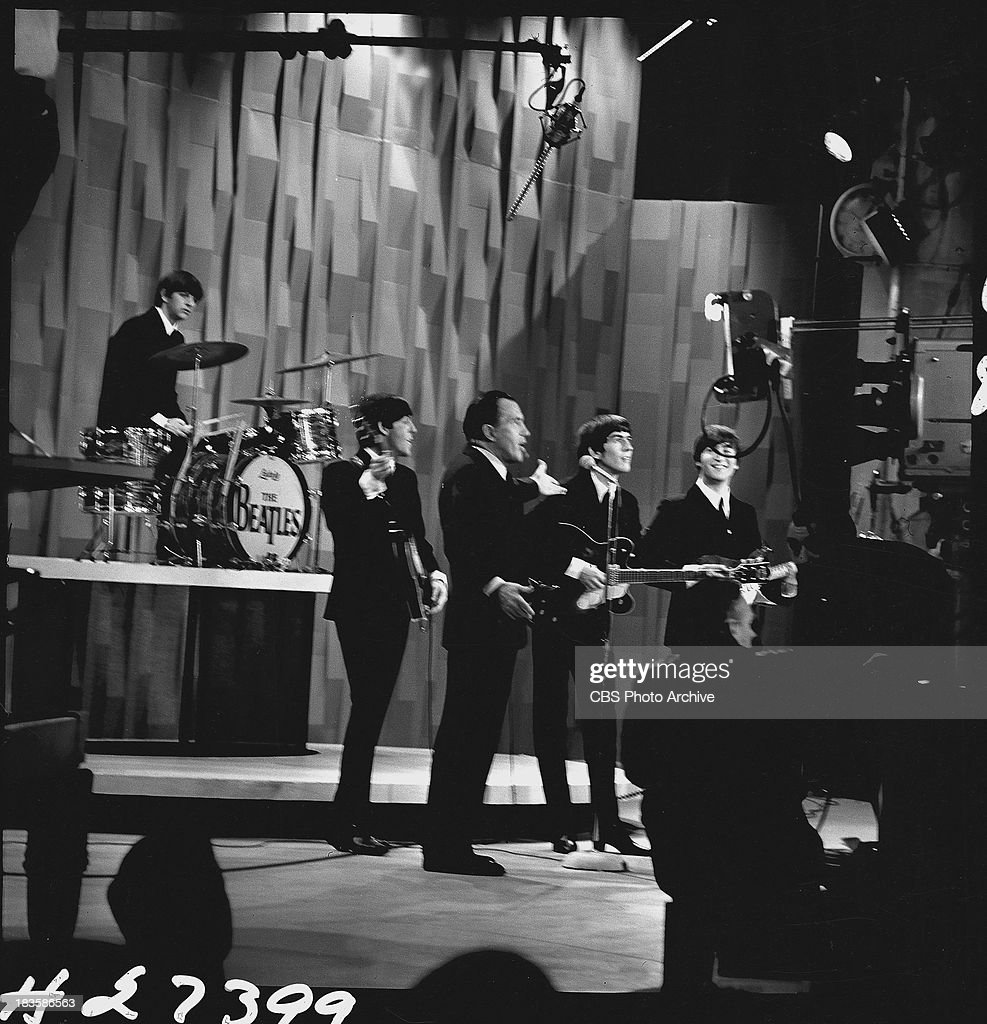
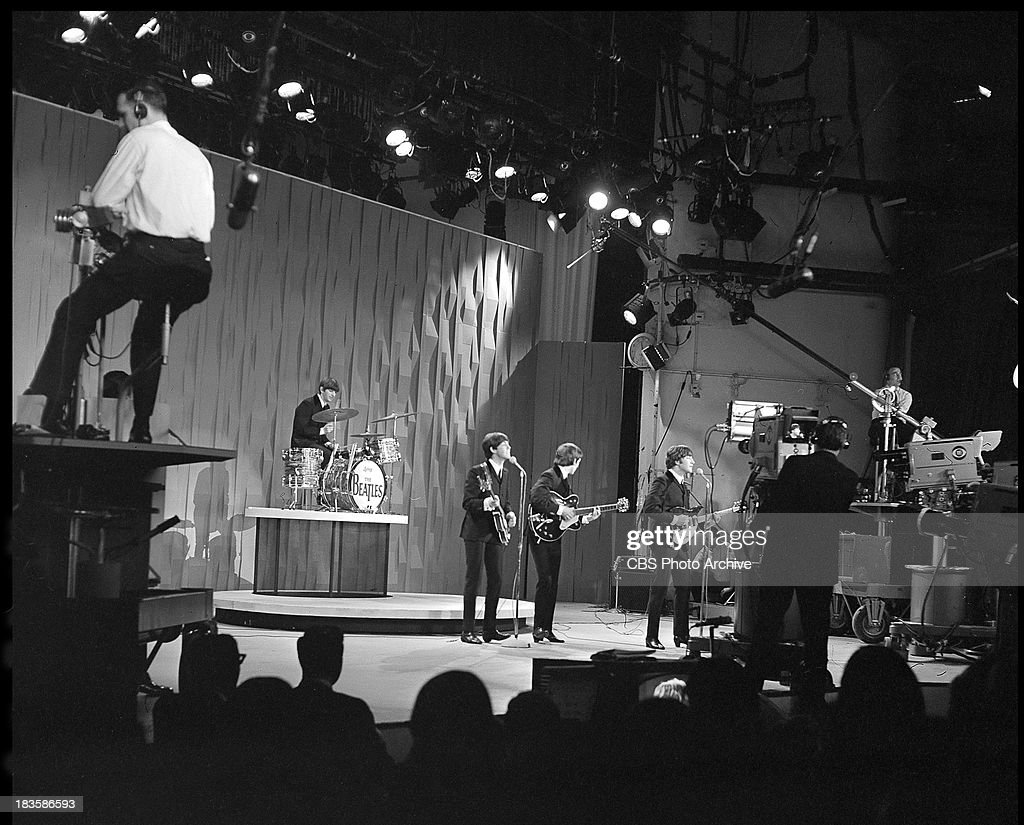
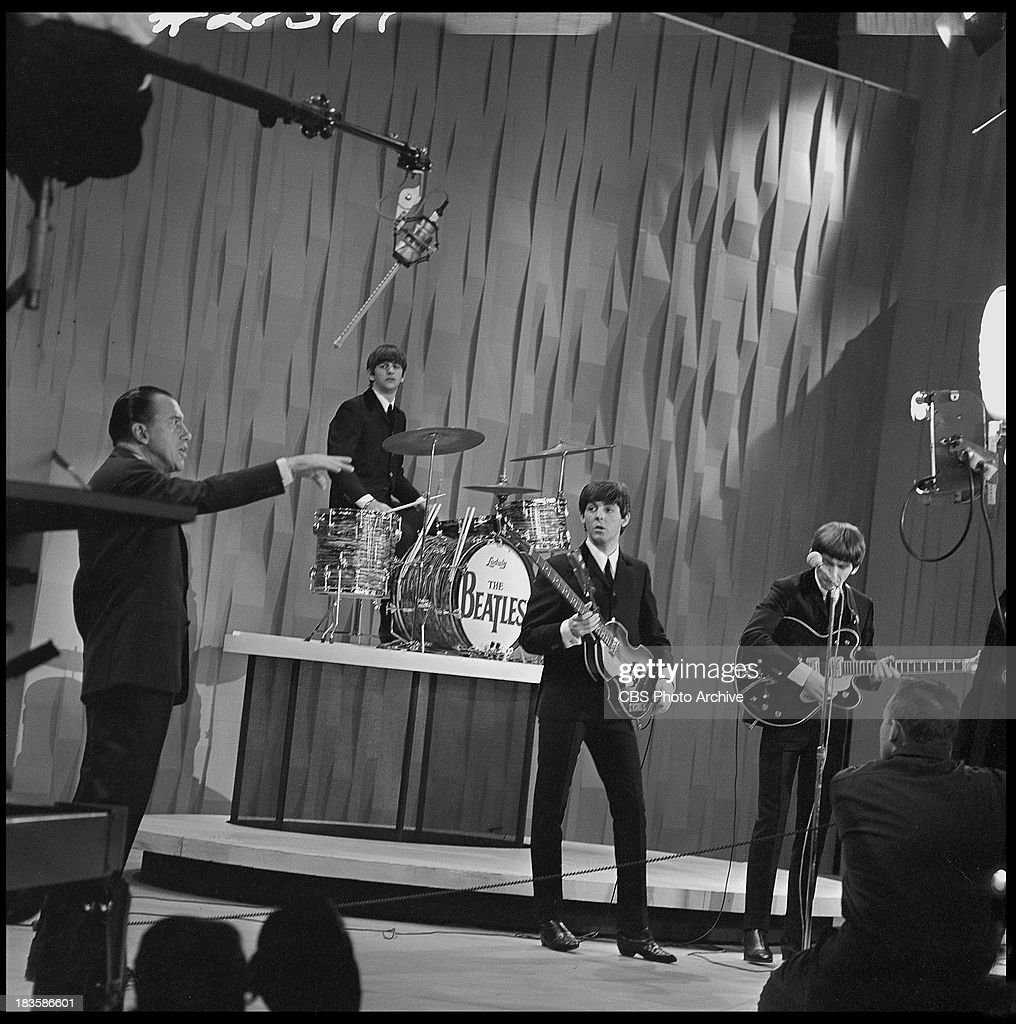
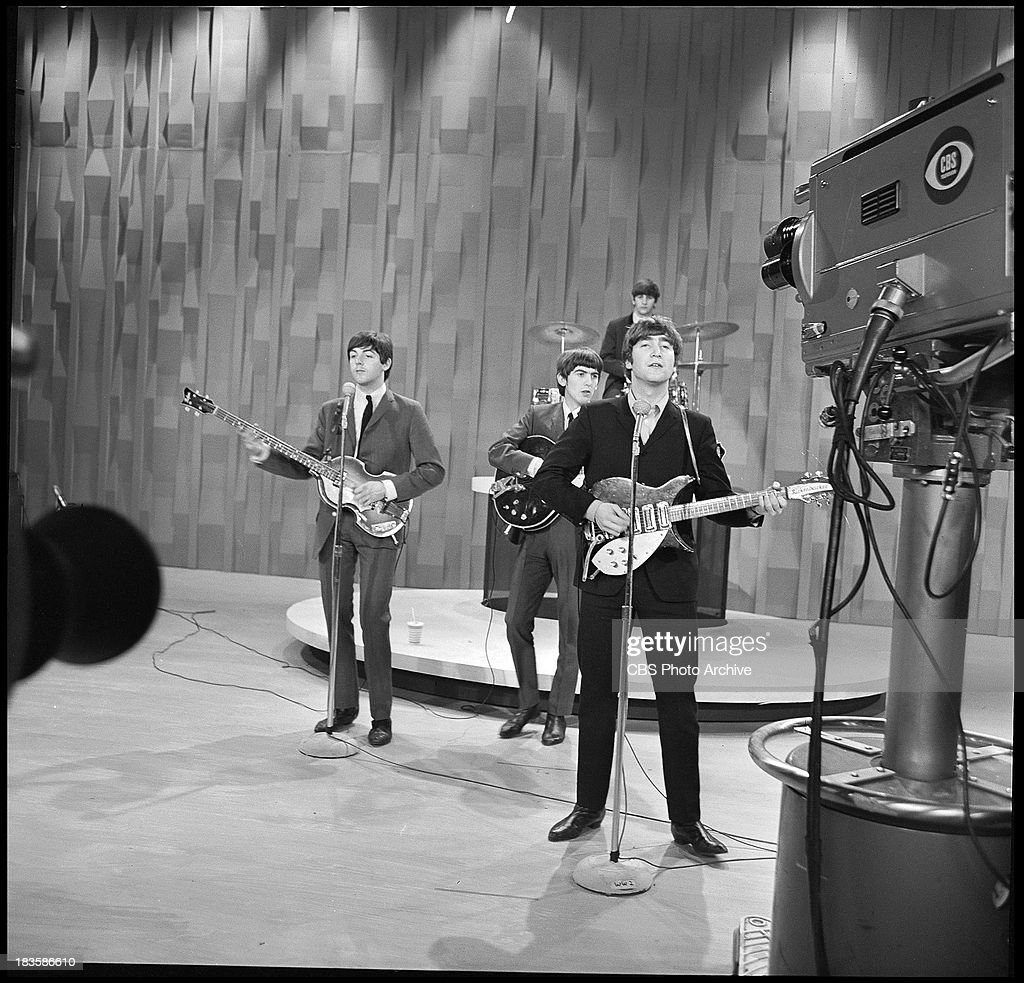

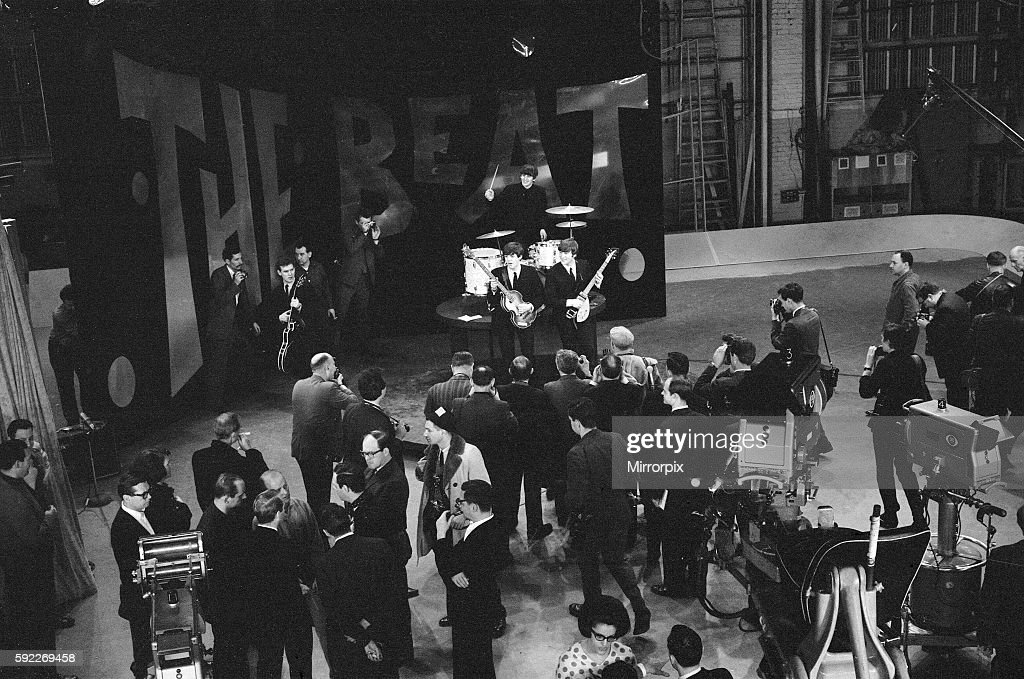


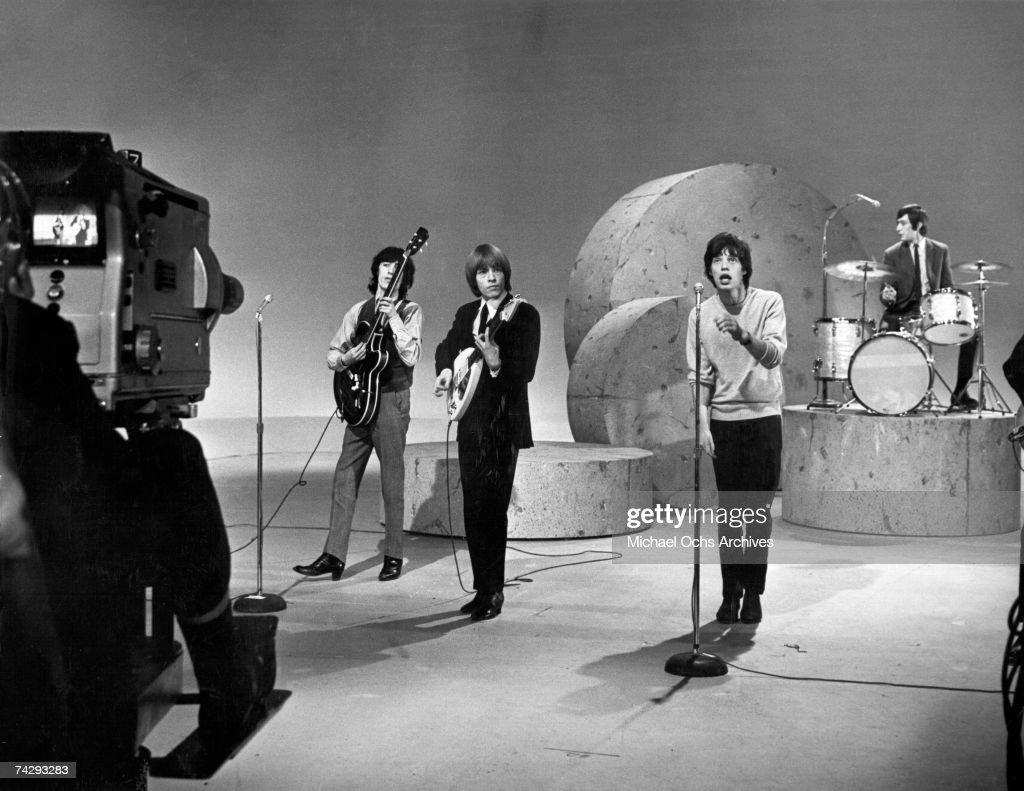
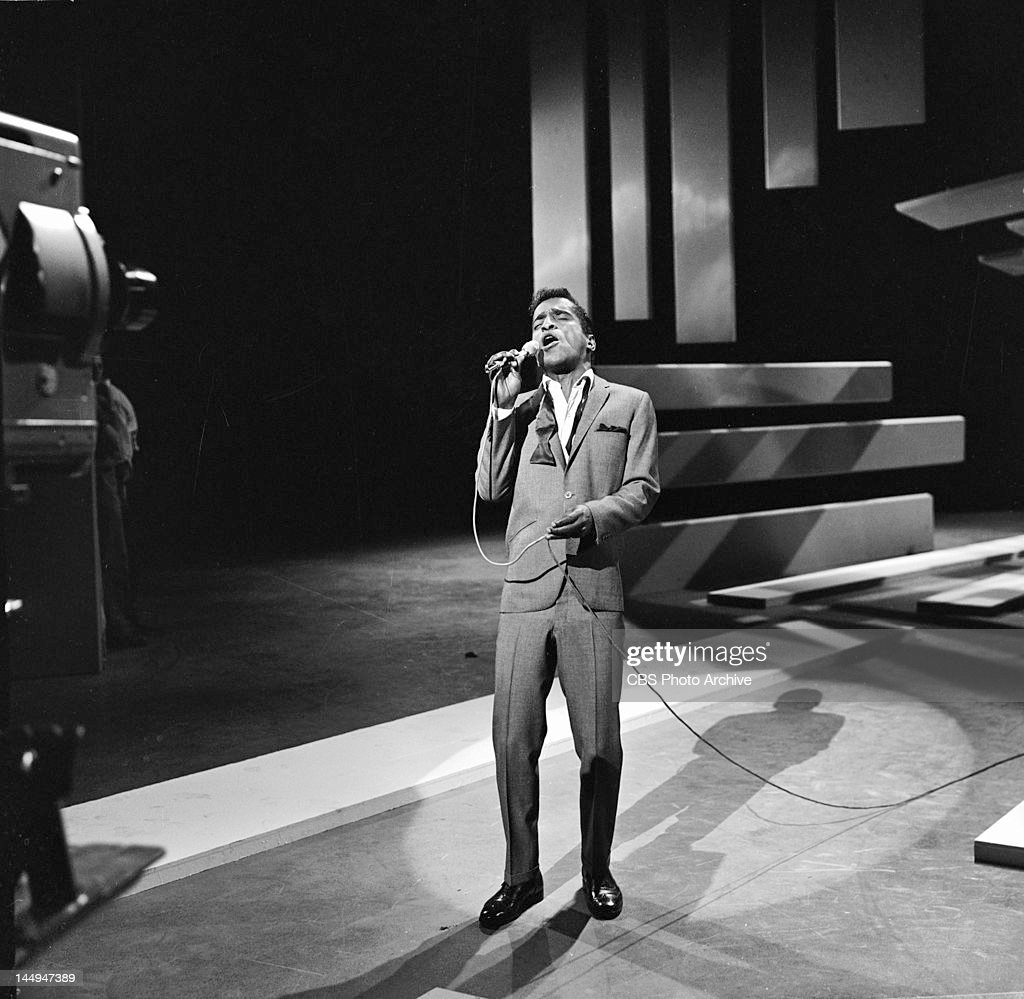
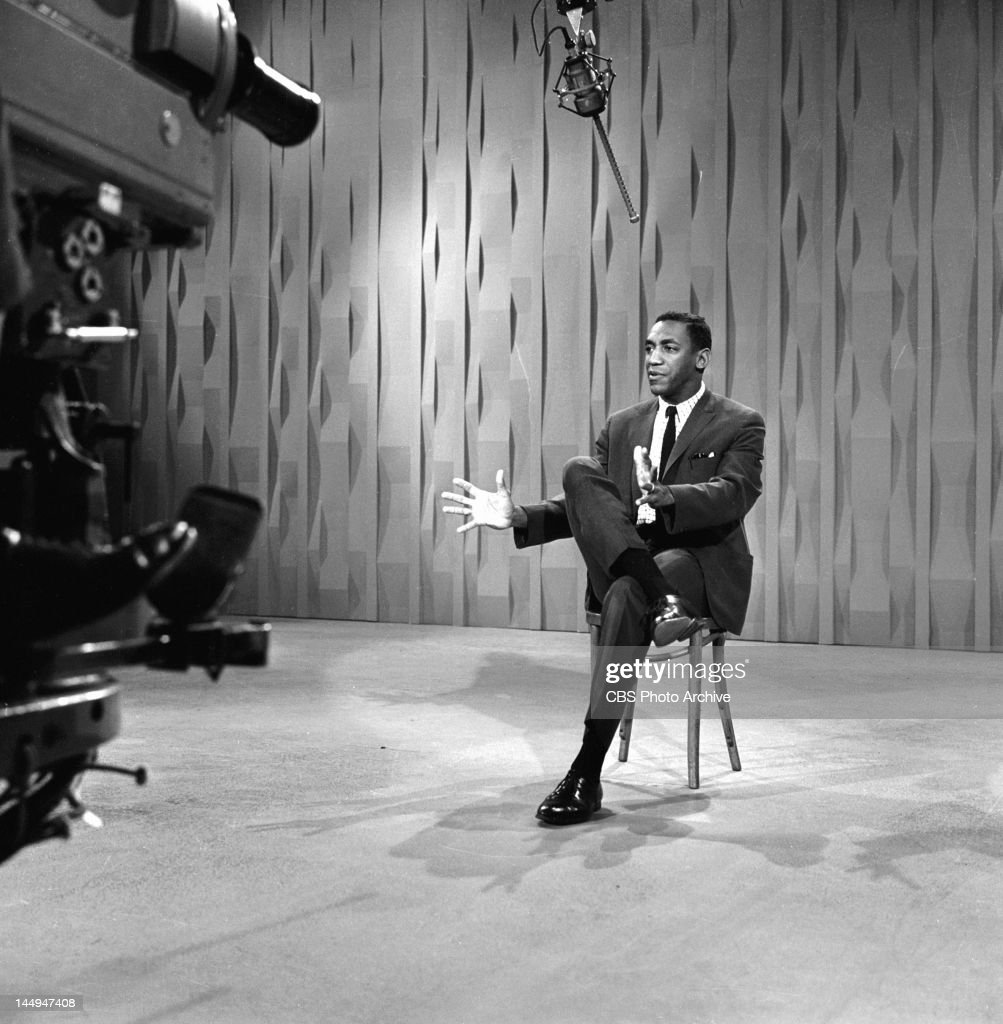
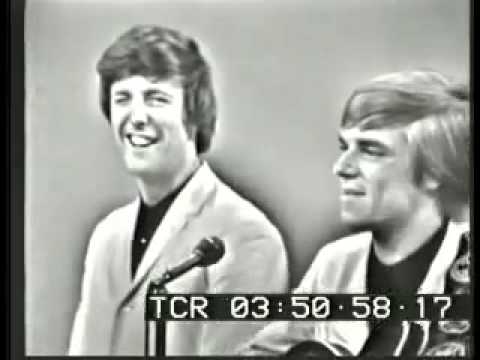
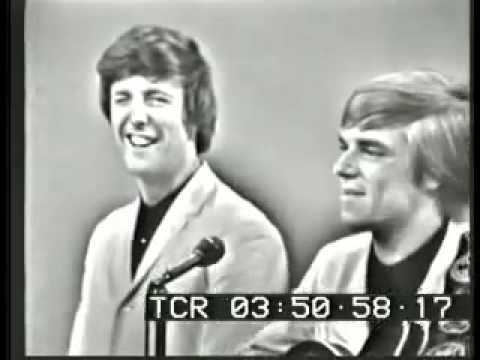
Source
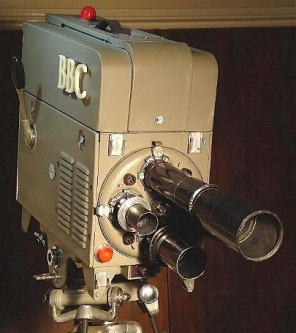
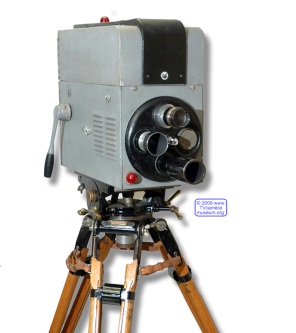
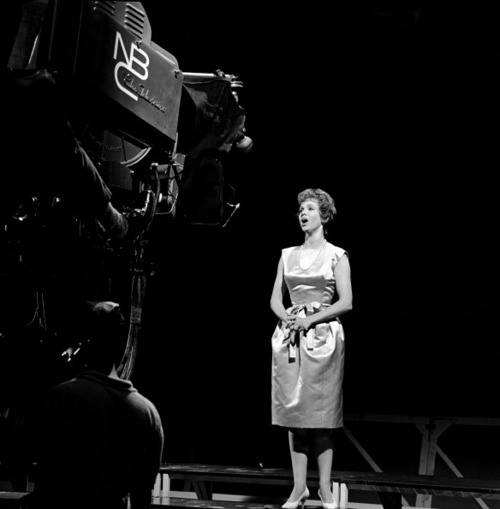

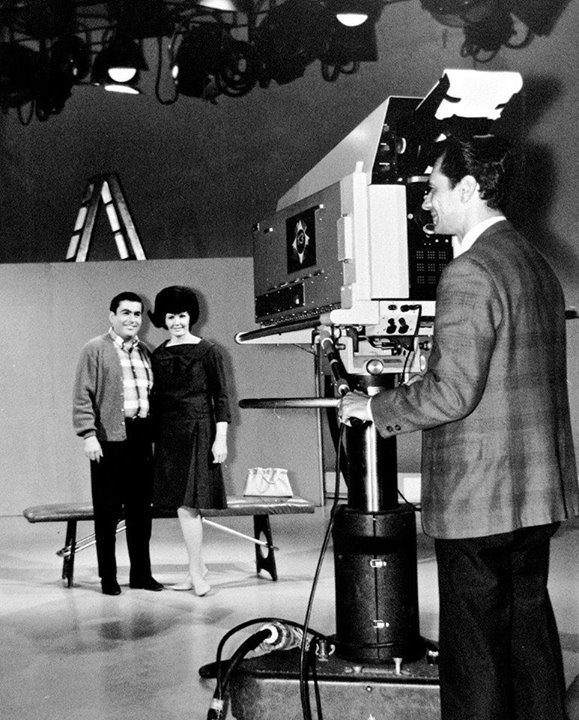

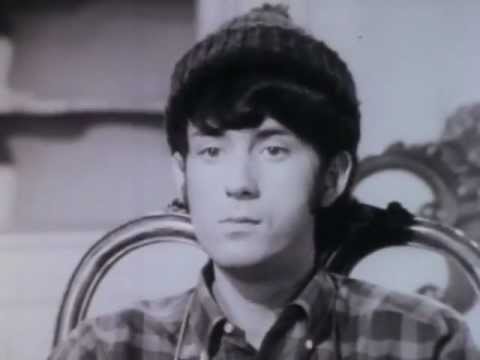

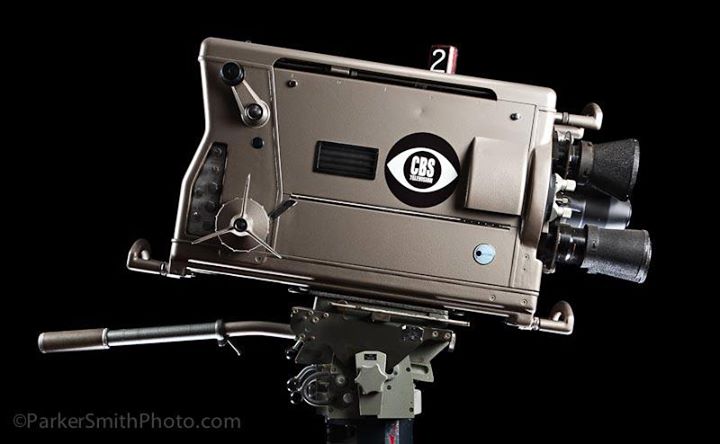

Search Results for: beatles
Beatles 50th Sullivan Anniversary Count Down…8 Days
On February 1, 2014
- TV History
Beatles 50th Sullivan Anniversary Count Down…8 Days
On February 9, 1964, The Beatles were not the only British singing stars to make their American television debut. As you’ll see in the screen shot from the same night, Davie Jones was there too, but not as The Monkey’s lead singer. He was playing the roll of the Artful Dodger in ‘Oliver’ which was a huge hit on Broadway. He had also played the part in London before the show came to the US. Posing backstage with The Beatles is his co star, Georgia Brown who played the roll of Nancy. When The Beatles hit the stage, Davie watched from the left side of the stage and later said to reporters, “I watched the Beatles from the side of the stage, I saw the girls going crazy, and I said to myself, this is it, I want a piece of that.” He got it too! I met him a few times and have to tell you, he is one of the nicest people you could ever meet. Rest In Peace Davie.
Beatles 50th Sullivan Anniversary Count Down…10 Days
On January 30, 2014
- TV History
Beatles 50th Sullivan Anniversary Count Down…10 Days
Up close and personal! Looking at how close the crane is in these shots is an interesting reminder that the Studio 50 stage is only 29 feet deep and 37 feet across with a very shallow stage right. There was a 10 foot crane ramp, but without the use of a zoom lens, you have to get in to get the close ups. As you will see in the next post, the Zoomar lens was used on the Sullivan show as early as the late 50s, but the Marconi Mark IV could not take the standard Zoomar because of the iris control motor in the center of the turret. I have heard that the first Mark IVs arrived at CBS in mid 1963. The only zoom lenses that would fit this, the RCA TK60 and the EMI 203 (all of which had iris motors on the turret) would be a huge Angenieux box lens and the Varitol III which NBC was using on many TK41s.
Beatles 50th Sullivan Anniversary Count Down…12 Days
On January 28, 2014
- TV History
Beatles 50th Sullivan Anniversary Count Down…12 Days
Here’s the HUGE SURPRISE I promised yesterday! Who knew that CBS had sent one of their early hand held video cameras to Miami to get shots for the February 16, 1964 ‘Ed Sullivan Show’? I just found this awesome photo a few days ago and it is the first time I have ever seen one of these cameras used on anything other than space shots. I’ve never even seen one of these prototype cameras in use at a sporting event. This photo was taken at the morning sound check which was followed by a dress rehearsal and finally that night’s show. This is one of about 6 cameras Ikegami built in a partnership with CBS Engineering around 1962. Unlike the RCA/NBC portables, I think this has an Image Orthicon tube and not a Vidicon.
Beatles 50th Sullivan Anniversary Count Down…13 Days
On January 27, 2014
- TV History
Beatles 50th Sullivan Anniversary Count Down…13 Days
Welcome to Miami Beach! The Beatles second live Sullivan show came from The Deauville Hotel on February 16, 1964. Having arrived a few days early, the band, among other things paid a visit to Cassius Clay, took a few dips in the ocean, and on Saturday had worked in a practice session for the next day’s show (right). On show day, The Beatles would be in the Deauville ballroom three times. The first visit (left and center) were for a sound check to get the levels right. The second time was for a late afternoon dress rehearsal of the whole show and the final time would be for the show, which almost got delayed because the security detail could not get them through the crowd fast enough as there was no “stage entrance”. There were six cameras (mostly TK30s) in the hall with two coming from WTVJ (center) and the rest coming from CBS including something special that we’ll see tomorrow.
Beatles 50th Sullivan Anniversary Count Down…15 Days
On January 26, 2014
- TV History
Beatles 50th Sullivan Anniversary Count Down…15 Days
Today, A Primer In: How to tell which performance is which.
With the anniversary approaching, you’ll see a lot of photos and clips and with this guide, you can tell which performance is which. The Beatles first appeared on Ed Sullivan these three consecutive Sunday nights…February 9, 16 and 23 1964. The February 16th show was done live from Miami, but all four of their other performances were done at CBS Studio 50 on February 9, with the first performances of the day taped for air on the 23rd. The Beatles appeared twice in each show and each time, the song set and stage set was different. Here are the Studio 50 stage sets in order of air dates. The first live performance set featured big arrows (at the top of this post) and the second live performance set featured hanging stripes (just below). The first appearance of the taped February 23 show was the only use of a blue flat wall set with a wedge facade, which was widely used on many Sullivan shows and matched his hosting corner backdrop. The final set of the February 23 show featured the free-standing art nouveau columns. Now you know!
Beatles 50th Sullivan Anniversary Count Down…16 Days
On January 25, 2014
- TV History
Beatles 50th Sullivan Anniversary Count Down…16 Days
Who is this man and why is he on stage with The Beatles? That answer in a moment, but first the scene must be set. It was only last year that I discovered that the Beatles third Sullivan appearance on February 23 was in fact, the first time they had ever played in America. That performance of two song sets with two different stage sets was taped in the early afternoon of February 9 before they performed two live sets with two different stage sets. But none of this almost happened! That day George Harrison had the flu and a fever of 103. Sullivan’s doctor was nursing him at the hotel while The Beatles road manager, Neal Aspernall stood in for George at the day’s first (closed to the public) dress rehearsal where the audio and camera blocking would be worked out. Just before the 3PM taping, Harrison arrived and and got a quick half song walk through just in time.
Beatles 50th Sullivan Anniversary Count Down…17 Days
On January 24, 2014
- TV History
Beatles 50th Sullivan Anniversary Count Down…17 Days
The photo on the left was taken from the control room during the dress rehearsal for the February 9 live show. Most of the screaming girl footage was shot during this very long rehearsal and inserted via videotape into the live broadcast. Remember, The Beatles had already taped the February 23 show earlier this same day and all the audio settings had been worked out in the days first rehearsal (closed to the public) and worked well in the taping at 3, BUT…during the lunch break (3:30 -4:30) someone in maintenance wiped off the grease pencil marks on the audio board! The day’s second dress rehearsal lasted well over an hour as The Beatles asked for playbacks of the first session to compare the sound. Candy Cushing and others that were there have told me that there was quite a bit of back and forth with the band as they worked out the audio problems. Sullivan also did some back and forth with the audience during the long lulls and this is when the famous shot of him in a Beatle wig was taken.
Beatles 50th Sullivan Anniversary Count Down…18 Days
On January 23, 2014
- TV History
Beatles 50th Sullivan Anniversary Count Down…18 Days
February 9, 1964 was The Beatles debut on American television but it was more than just a performance…it was a turning point for a country that was still in shock over the assassination of President Kennedy just a few short months before. We’ll count down till the celebration with photos and back stories that I hope you’ll share. In the photo below, we see Ed Sullivan conversing with the control room during rehearsal. There were actually four performances on February 9th….a 12 noon dress rehearsal and a 2 o’clock taping of two sets of songs that would air February 23rd. Then there was the 5 o’clock dress rehearsal for the 8 o’clock live show. There were three audiences that day as the noon rehearsal was closed. 50,000 ticket requests came in but only three audiences of 700 were able to be there live. Notice in this photo, Ed has a spare Q card lashed to the boom stand…he also reads from a paper toll teleprompter on the front of Camera 1, but just to make sure he doesn’t flub is intro, he had it put in two places. It was quite a day.
The Whole Story In Detail: Ed Sullivan and The Beatles!
On February 9, 2013
- TV History
The Whole Story In Detail: Ed Sullivan and The Beatles!
There are a number of stories regarding exactly how The Beatles came to appear on The Ed Sullivan Show. The most popular is that in 1963, while arriving at London’s Heathrow airport, Ed Sullivan and his wife Sylvia encountered thousands of youngsters waiting excitedly in the rain. When Sullivan asked what all the commotion was about, he was told that a British band named The Beatles was returning home from a tour in Sweden. When he got to his hotel room, Sullivan purportedly inquired about booking the group for his show.
However, it was not until later that year that The Beatles’ manager Brian Epstein reached an agreement with Ed Sullivan to bring the group to America to perform live for the first time on U.S. television. Following dinner at the Hotel Delmonico in New York City, a handshake between the two men sealed the deal for performances on three shows to air in 1964. In return, The Beatles would receive $10,000 for their three appearances and top billing. FYI, Elvis Presly got $50,000 for 3 appearances.
Prior to their debut on the Sullivan show, The Beatles’ record “I Want to Hold Your Hand” was leaked in advance of its planned US release to radio stations across the country. When attorneys for Capitol Records were unable to stop American DJs from spinning the tune, the record label relented and, on December 26, 1963, dropped the album ahead of schedule. The record sold 250,000 copies in the first three days. By January 10, 1964 it had sold over one million units and “I Want to Hold Your Hand” was the number one song on the Billboard charts by month’s end. In the weeks leading up to The Beatles’ performance on The Ed Sullivan Show, Beatlemania went viral. Radio stations played the band’s music nearly non-stop; teenaged fans sported “Beatle” wigs, and bumper stickers across the country warned, “The Beatles Are Coming.”
The Beatles touched down at New York’s Kennedy Airport on February 7th, 1964. They were met by a throng of reporters and a hoard of three thousand screaming fans. Upon disembarking the plane, The Beatles were whisked to a press conference hosted by Capitol Records in which they playfully answered questions from the media.
While The Beatles spent the next two days cooped up at The Plaza Hotel, fans did all they could to get closer to the band. Groups of teenagers set up camp outside The Plaza, some even posing as hotel guests in an attempt to see their favorite group. As the show approached, over 50,000 requests for seats came into CBS. However, The Ed Sullivan Show, which originated from CBS’s TV Studio 50, could only accommodate an audience of 700.
For weeks, celebrities were calling in to get tickets for their kids. Walter Cronkite and Jack Paar scored seats for their girls; composer Leonard Bernstein tried but failed; while Richard Nixon’s 15-year old daughter, Julie, became one of the lucky few to get a seat. Even Sullivan himself had trouble getting extra tickets. On his show the week before The Beatles’ debut, Ed asked his audience, “Coincidentally, if anyone has a ticket for The Beatles on our show next Sunday, could I please borrow it? We need it very badly.”
It should be remembered that while this hullabaloo was happening, there was still an air of gloom in America. Just 77 days prior to The Beatles’ appearance on Sullivan, President Kennedy had been assassinated. By now, the country was ready for some much needed diversion, and it came in the form of four young lads from Liverpool – their sound, their look, their energy and their charisma.
At 8 o’clock on February 9th 1964, America tuned in to CBS and The Ed Sullivan Show. But this night was different. 73 million people gathered in front their TV sets to see The Beatles’ first live performance on U.S. soil. The television rating was a record-setting 45.3, meaning that 45.3% of households with televisions were watching. That figure reflected a total of 23,240,000 American homes. The show garnered a 60 share, meaning 60% of the television’s turned on were tuned in to Ed Sullivan and The Beatles. Cumulatively, the four shows attracted an audience of a quarter of a BILLION people. In terms of percentage of America’s population, the first two shows remain the highest viewed regularly scheduled television programs of all time.
Ed opened the show by briefly mentioning a congratulatory telegram to The Beatles from Elvis and his manager, Colonel Tom Parker and then threw to advertisements for Aero Shave and Griffin Shoe Polish. After the brief commercial interruption, Ed began his memorable introduction:
“Now yesterday and today our theater’s been jammed with newspapermen and hundreds of photographers from all over the nation, and these veterans agreed with me that this city never has witnessed the excitement stirred by these youngsters from Liverpool who call themselves The Beatles. Now tonight, you’re gonna twice be entertained by them. Right now, and again in the second half of our show. Ladies and gentlemen, The Beatles! Let’s bring them on.”
At last, John, Paul, George and Ringo came onto the stage, opening with “All My Loving” to ear-splitting screeches from teenaged girls in the audience. The Beatles followed that hit with Paul McCartney taking the spotlight to sing, “Till There Was You.” During the song, a camera cut to each member of the band and introduced him to the audience by displaying his first name on screen. When the camera cut to John Lennon, the caption below his name also read “SORRY GIRLS, HE’S MARRIED.” ( this was mimicked in the movie That Think You Do). The Beatles then wrapped up the first set with “She Loves You,” and the show went to commercial. Upon return, magician Fred Kaps took the stage to perform a set of sleight-of-hand tricks.
Concerned that The Beatles’ shrieking fans would steal attention from the other acts that evening, Ed Sullivan admonished his audience, “If you don’t keep quiet, I’m going to send for a barber.”
As hard as Ed tried to protect them, the other acts that night suffered from the excitement surrounding The Beatles. Numbered among those performers were impressionist Frank Gorshin, acrobats Wells & the Four Fays, the comedy team of McCall & Brill and Broadway star Georgia Brown joined by the cast of “Oliver!”
The hour-long broadcast concluded with The Beatles singing two more of their hits, “I Saw Her Standing There” and “I Want to Hold Your Hand” to the delight of the fans in attendance and those watching at home.
The show was a huge television success. As hard as it is to imagine, over 40% of every man, woman and child living in America had watched The Beatles on Sullivan.
John Moffitt, then Assistant Director of The Ed Sullivan Show recalls, “Nobody realized the impact to come, how momentous it would be. We didn’t talk about making history. It was more like, ‘What are we going to do next week? Not only are we doing this again, we’re on location.’”
That’s because The Beatles’ second appearance on February 16th, 1964, was broadcast from The Deauville Hotel in Miami Beach, Florida. Moffitt remembers how fans took over the venue, and when it was time for The Beatles to perform, a teaming throng of teenagers blocked the group’s access to the ballroom. As security guards wedged a passageway through the crowd for The Beatles, the show was being broadcast to America. Unaware of the delay, Ed was about to introduce them. Moffitt recalls…
“Ed is saying ‘And now, here are—(a beat)—The Beatles right after this.’ And he went to a commercial. And during the commercial, finally at the end, The Beatles broke through, they came running up the aisle, they got hooked up, and I believe there was one microphone that didn’t get hooked up. But you couldn’t tell because all you could hear was the screaming.”
Audio difficulties aside, the boys plowed through “She Loves You,” “This Boy” and “All My Loving” for their first set, then turned the stage over to the comedy team of Allen and Rossi (“Hello, Dere”), singer/dancer Mitzi Gaynor, acrobats The Nerveless Knocks and monologist Myron Cohen.
The Beatles returned to close the show with performances of “I Saw Her Standing There,” “From Me to You” and “I Want to Hold Your Hand.” After they finished, Ed called them over and congratulated them, passing along word that legendary composer Richard Rodgers was one their “most rabid fans.”
Again, The Beatles on Sullivan proved a huge ratings success, nearly duplicating the record-setting performance of their first appearance. The second show also attracted 40% of the American population.
The Beatles third and—according to their contract—final performance on The Ed Sullivan Show was technically their first. The show was taped prior to their live February 9th debut, but saved for broadcast until February 23rd, 1964. On this show, The Beatles sang “Twist and Shout”, “Please Please Me” and “I Want to Hold Your Hand.” Other guests that night included stand-up comedian Dave Barry, Gordon and Sheila MacRae, and the legendary American jazz singer Cab Calloway.
On September 12th, 1965, The Fab Four returned to the Ed Sullivan stage one last time. They played “I Feel Fine,” “I’m Down,” “Act Naturally,” “Ticket to Ride,” “Yesterday,” and “Help!” This performance was taped in New York on August 14th, 1965, just one day before The Beatles kicked off their North American Tour with a concert at Shea Stadium that set the attendance record for an outdoor show at the time.
The final appearance of the Beatles on Ed Sullivan, like those in February 1964 aired in black and white. However, at the end of the evening, Sullivan broke the news that the following week, his show would start broadcasting in color. In fact, the show moved to Television City in Los Angeles for 6 weeks of color broadcasts while Studio 50 was being overhauled for color with new lighting and six, custom made Norelco PC71 cameras. The man CBS put in charge of the overhaul was Joseph Flaherty who spoke about that here last week.
These four historic Beatles performances on The Ed Sullivan Show featured 20 Beatles songs—seven of which became Number One hits. Their success on The Ed Sullivan Show paved the way for future rock ‘n’ roll groups dubbed the British Invasion, including The Rolling Stones, The Animals, The Dave Clark Five, Herman’s Hermits,The Searchers, Gerry and the Pacemakers, Peter and Gordon, etc.
The genius of The Beatles and the American institution that was The Ed Sullivan Show combined to create one of the most defining and indelible moments in the history of music, television and pop culture. It was a remarkable convergence that came at a special time in America, making an impact on the world that will never be duplicated.
Thanks to SOFA Entertainment for much of the information above. The company is owned by Andrew Solt, who in 1990 purchased the complete video library and all rights to The Ed Sullivan Show. The site, linked below, has the best historical information on the show and the theater I have found so far. Many thanks to Mr. Solt for preserving these historical treasures for generations to come!
http://www.edsullivan.com/
Beatles Prelude: A Few SURPRISES!
On February 8, 2013
- TV History
Beatles Prelude: A Few SURPRISES!
In 1964, today February 8th, would have been Saturday. The first Beatles rehearsal for Ed Sullivan began at 1:30 PM Saturday afternoon at Studio 50. Here is a rundown of the day and a few BIG SURPRISES!
Surprise 1…The Beatles ‘THIRD’ appearance was actually their FIRST appearance! The Sunday afternoon dress rehearsal (2/8/64) was taped with a different audience than the ‘debut’s show, and was played back as the third consecutive week of the Beatles live on Sullivan. The play back date was February 23rd.
Surprise 2…George Harrison almost didn’t make it! He had strep throat and a fever of 104. He was not at the Saturday rehearsals. That’s why you only see John, Paul and Ringo in the shot with Ed examining Paul’s Hofner bass guitar.
Here’s what happened at Studio 50, 49 years ago today…
In the morning a press conference was held in the Baroque Room at New York’s Plaza Hotel, where The Beatles were staying. Following this John Lennon, Paul McCartney and Ringo Starr went for a walk and photo opportunity in Central Park, where their every move was followed by around 400 female fans.
George Harrison was suffering from a streptococcal sore throat, and so remained in the Plaza. He was joined there by his sister Louise Caldwell, who lived in Illinois.
The doctor said he couldn’t do The Ed Sullivan Show because he had a temperature of 104! But they pumped him with everything. He was thinking about getting a nurse to administer the medicine, every hour on the hour. Then the doctor suddenly realized that George’s sister was there and he said to her, ‘Would you see to it? It’s probably just as well that you’re here because I don’t think there’s a single female in the city that isn’t crazy about The Beatles! You’re probably the only one who could function around him normally’.
At 1.30 PM, The Beatles – minus George – traveled by limousine to the CBS studios on Broadway for the first of several rehearsals for their debut appearance on The Ed Sullivan Show. During the journey their cars were charged by fans, and mounted police were forced to intervene to keep order. Ten mounted police guarded the studio along with 52 officers while The Beatles were inside. Their first duty was to join AFTRA and the musicians’ union.
For the rehearsals, road manager Neil Aspinall stood in for George, as did production assistant Vince Calandra, while the director rehearsed the camera positions for the following day’s show. It’s a good thing there were several camera rehearsals…during the show, none of the cameramen could hear the director in their headphones! The screaming fans were just too loud.
Afterwards The Beatles asked to see a playback of their rehearsal, which no other musical act had previously asked for. In the evening Lennon, McCartney and Starr went to the famous ’21’ restaurant with George Martin and executives from Capitol Records. The Beatles ate chops while their music industry companions had pheasant.


Behind The Scenes of THE ED SULLIVAN SHOW…Part 4 (of 7)
On September 20, 2023
- Archives
The Marconi Mark IV Era: This is the largest section as it features the era of the Marconi Mark IV black and white cameras and The Beatles and begins in 1960. The BIG difference was the picture clarity as this new camera used a 4 1/2 inch Image Orthicon tube, where as all cameras before this used a 3 inch Image Orthicon. CBS coverd the 1960 elections with new Marconi Mark IVs at their old Grand Cenetral studos so I’m sure Studio 50 had them soon after.
Midway down, there are about 5 or 6 photos from The Beatles Miami performance which are included to show the first ever use of a hand held camera for entertainment purposes (as opposed to news or sports), and the hand held was a special development project between CBS and Ikegami. The big cameras in Miami are RCA TK30s which belong to CBS Miami affiliate WTVJ.
NOTICE THE VERY FIRST BEATLES PHOTO (10th one down)…IT WAS TAKEN DURING REHEARSAL WHEN GEORGE HARRISON WAS SICK AND TOUR MANAGER NEIL ASPINALL WAS STANDING IN FOR GEORGE, WHO RECOVERED IN TIME FOR THE TAPING.
These historical images are from the CBS Photo Archives available through Getty Images and are presented here to assist researchers and television historians in identifying the television equipment in use over the decades and is offered here in a purely educational/instructional forum.

NEW YORK – MAY 3: A young Stevie Wonder during rehearsals for THE ED SULLIVAN SHOW. Image dated May 3, 1964. (Photo by CBS via Getty Images)

NEW YORK – OCTOBER 7: Paul Anka performs on “The Ed Sullivan Show,” a CBS television variety program. Broadcast Sunday, October 7, 1962. (Photo by CBS via Getty Images)

NEW YORK – OCTOBER 7: Peter Duchin and his orchestra perform on “The Ed Sullivan Show,” a CBS television variety program. Broadcast Sunday, October 7, 1962. (Photo by CBS via Getty Images)

NEW YORK – OCTOBER 7: Paul Anka performs on “The Ed Sullivan Show,” a CBS television variety program. Broadcast Sunday, October 7, 1962. (Photo by CBS via Getty Images)

NEW YORK – OCTOBER 7: Paul Anka performs on “The Ed Sullivan Show,” a CBS television variety program. Broadcast Sunday, October 7, 1962. (Photo by CBS via Getty Images)

NEW YORK – OCTOBER 7: (Pictured left to right) Denny Willis and his Hunting Quartet perform on “The Ed Sullivan Show,” a CBS television variety program. Broadcast Sunday, October 7, 1962. (Photo by CBS via Getty Images)

NEW YORK – OCTOBER 7: Yolanda White performs on “The Ed Sullivan Show,” a CBS television variety program. Broadcast Sunday, October 7, 1962. (Photo by CBS via Getty Images)

NEW YORK – OCTOBER 7: Ventriloquist Dennis Spicer and his smooth-talking dummy James Green perform on “The Ed Sullivan Show,” a CBS television variety program. Broadcast Sunday, October 7, 1962. (Photo by CBS via Getty Images)

NEW YORK – OCTOBER 7: Paul Anka performs on “The Ed Sullivan Show,” a CBS television variety program. Broadcast Sunday, October 7, 1962. (Photo by CBS via Getty Images)

NEW YORK – FEBRUARY 8: The Beatles at rehearsal the day before their first appearance on THE ED SULLIVAN SHOW. From left: Paul McCartney, Neil Aspinall (standing in for a sick George Harrison), John Lennon and Ringo Starr on the drums. Image dated February 8, 1964. (Photo by CBS via Getty Images)

The Beatles rehearse their appearance on the Ed Sullivan Show. 8th February 1964. (Photo by Daily Mirror/Daily Mirror/Mirrorpix via Getty Images)

Camera rehearsals for the Beatles first appearance on ‘The Ed Sullivan Show’, CBS Studio 50, New York City. 9th February 1964. (Photo by Daily Mirror/Daily Mirror/Mirrorpix via Getty Images)

Members of the British rock band The Beatles, (left to right) Paul McCartney, George Harrison (1943 – 2001), Ringo Starr, and John Lennon (1940 – 1980), sing into microphones as they play their instruments at the taping of a segment for ‘Toast of the Town,’ the CBS variety program hosted by Ed Sullivan, New York, August 14, 1965. The segment aired as part of Sullivan’s 19th season opener on September 12, 1965. (Photo by CBS Photo Archive/Getty Images)

NEW YORK – AUGUST 14: The Beatles at rehearsal for their final performance on THE ED SULLIVAN SHOW. Image dated August 14, 1965. Paul McCartney playing with violins while George Harrison and John Lennon watch from the side. (Photo by CBS via Getty Images)

NEW YORK – FEBRUARY 9: Bassist Paul McCartney, guitarist John Lennon and Drummer Ringo Starr of the rock and roll band “The Beatles” prepare for their performance on “The Ed Sullivan Show” on February 9, 1964 in New York City, New York. (Photo by Michael Ochs Archives/Getty Images)

10th February 1964, New York, USA, British pop group The Beatles play live on The Ed Sullivan Show (Photo by Popperfoto via Getty Images/Getty Images)

NEW YORK – FEBRUARY 9: THE ED SULLIVAN SHOW featuring The Beatles, performed on Sunday, February 9, 1964, from CBS’s Studio 50 in New York City. Show host Ed Sullivan reviewing the teleprompter notes. (Photo by CBS via Getty Images)
SPECIAL NOTE ON THE PHOTO ABOVE: Meet Sullivan Associate Producer, Jacques Andre
On Sunday nights, between 8 and 9 PM, Jacques was the “middle man” on ‘The Ed Sullivan Show’. During the week, he worked for producer Bob Precht, but on show night, he stood with Ed at the side of the stage keeping the show’s running time and was the hub between the control room, stage manager Eddie Brinkmann and Sullivan. Although quite capable, he would always feel the need throw up before each show.
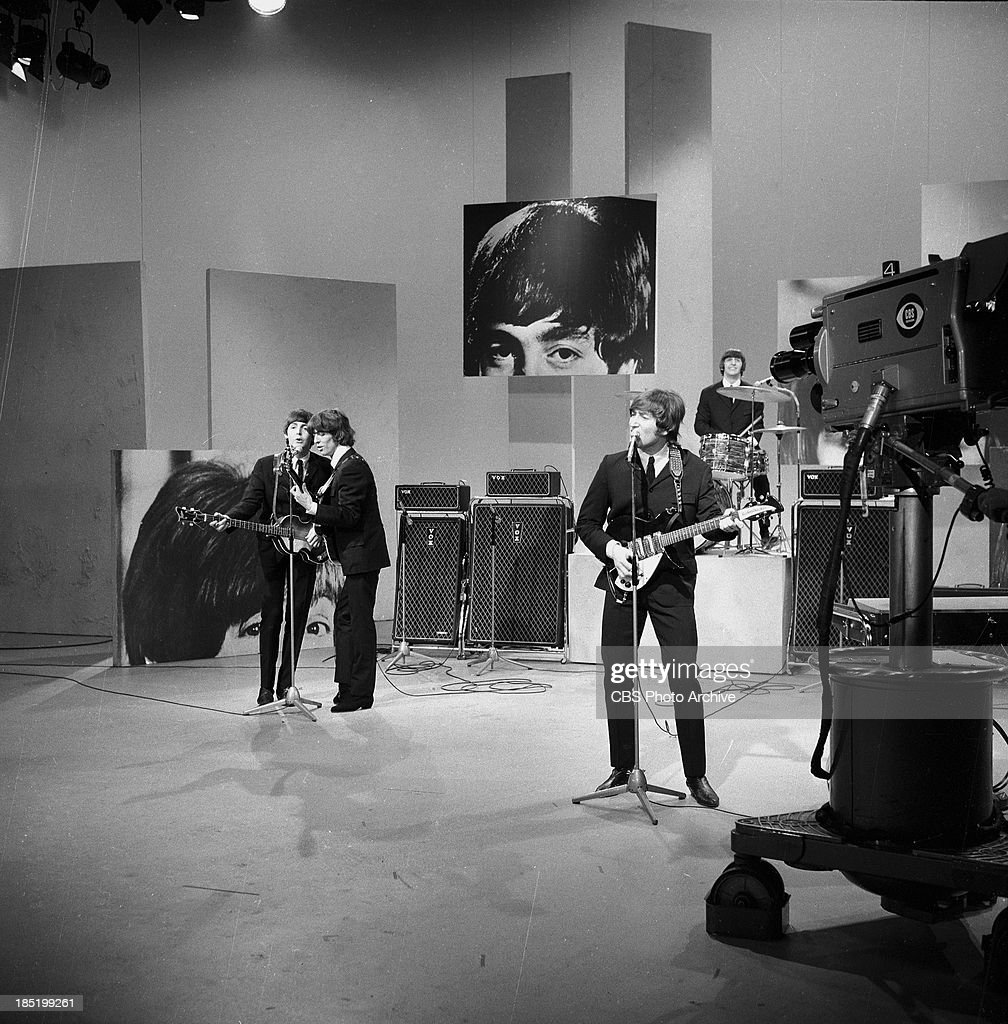
NEW YORK – AUGUST 14: The Beatles third appearance on The Ed Sullivan Show. Image dated August 14, 1965. From left: Paul McCartney, George Harrison, John Lennon, Ringo Starr. (Photo by CBS via Getty Images)

T’The Ed Sullivan Show’ featuring The Beatles, performed on Sunday, February 9, 1964, from CBS’s Studio 50 in New York City. Band members (from left) Ringo Starr (drummer), Paul McCartney, show host: Ed Sullivan, George Harrison and John Lennon. (Photo by CBS Photo Archive/Getty Images)

British pop and rock music group the Beatles perform on the television variety program, ‘The Ed Sullivan Show,’ New York, New York, February 9, 1964. From left, Paul McCartney, George Harrison (1943 – 2001), and John Lennon (1940 – 1980). Drummer Ringo Starr is obscured behind Lennon. (Photo by Bernard Gotfryd/Getty Images)

NEW YORK – FEBRUARY 9: THE ED SULLIVAN SHOW featuring The Beatles, performing on Sunday, February 9, 1964, from CBS’s Studio 50 in New York City. Band members (from left) Ringo Starr (drummer), Paul McCartney, George Harrison and John Lennon. (Photo by CBS via Getty Images)

NEW YORK – FEBRUARY 9: THE ED SULLIVAN SHOW featuring The Beatles, performing on Sunday, February 9, 1964, from CBS’s Studio 50 in New York City. Band members (from left) Ringo Starr (drummer), Paul McCartney, George Harrison and John Lennon. (Photo by CBS via Getty Images)

NEW YORK – FEBRUARY 9: THE ED SULLIVAN SHOW featuring The Beatles, performing on Sunday, February 9, 1964, from CBS’s Studio 50 in New York City. Band members (from left), Paul McCartney, George Harrison, John Lennon and Ringo Starr (drummer). (Photo by CBS via Getty Images)

NEW YORK – FEBRUARY 9: THE ED SULLIVAN SHOW featuring The Beatles, performing on Sunday, February 9, 1964, from CBS’s Studio 50 in New York City. Band members (from left) Ringo Starr (drummer), Paul McCartney, George Harrison and John Lennon. (Photo by CBS via Getty Images)

NEW YORK – FEBRUARY 9: THE ED SULLIVAN SHOW featuring The Beatles, performing on Sunday, February 9, 1964, from CBS’s Studio 50 in New York City. Band members (from left), Paul McCartney, George Harrison, John Lennon and Ringo Starr (drummer). (Photo by CBS via Getty Images)

NEW YORK – FEBRUARY 9: THE ED SULLIVAN SHOW featuring The Beatles, performing on Sunday, February 9, 1964, from CBS’s Studio 50 in New York City. 3 of the 4 band members (from left), Paul McCartney, George Harrison and John Lennon. (Photo by CBS via Getty Images)

MIAMI BEACH – FEBRUARY 16: THE ED SULLIVAN SHOW. Deauville Hotel, Miami Beach, Florida. The Beatles’ second appearance. From left: Paul McCartney, George Harrison, John Lennon and Ringo Starr. Image dated February, 16, 1964. (Photo by CBS via Getty Images)

NEW YORK – FEBRUARY 16: The Beatles rehearse at the Deauville Hotel, Miami Beach, Florida for THE ED SULLIVAN SHOW. Pictured is drummer, Ringo Starr. Image dated February 16, 1964. (Photo by CBS via Getty Images)

NEW YORK – FEBRUARY 16: The Beatles rehearse at the Deauville Hotel, Miami Beach, Florida for THE ED SULLIVAN SHOW. From left: Paul McCartney, George Harrison, John Lennon, and Ringo Starr. Image dated February 16, 1964. (Photo by CBS via Getty Images)

NEW YORK – FEBRUARY 16: The Beatles rehearse at the Deauville Hotel, Miami Beach, Florida for THE ED SULLIVAN SHOW. From left: Paul McCartney, George Harrison, John Lennon, and Ringo Starr. Image dated February 16, 1964. (Photo by CBS via Getty Images)

NEW YORK – FEBRUARY 16: The Beatles rehearse at the Deauville Hotel, Miami Beach, Florida for THE ED SULLIVAN SHOW. From left: John Lennon, George Harrison, Paul McCartney. Image dated February 16, 1964. (Photo by CBS via Getty Images)

NEW YORK – FEBRUARY 16: The Beatles rehearse at the Deauville Hotel, Miami Beach, Florida for THE ED SULLIVAN SHOW. From left: Producer, Bob Precht and John Lennon. Image dated February 16, 1964. (Photo by CBS via Getty Images)

NEW YORK – FEBRUARY 16: The Beatles perform in the Deauville Hotel, Miami Beach, Florida for THE ED SULLIVAN SHOW. From left: John Lennon, Paul McCartney and George Harrison. Image dated February 16, 1964. (Photo by CBS via Getty Images)

NEW YORK – FEBRUARY 9: The Beatles perform during their first appearance on THE ED SULLIVAN SHOW, February 9, 1964. Paul McCartney, George Harrison, John Lennon and Ringo Starr are shown. (Photo by CBS via Getty Images)

NEW YORK – FEBRUARY 9: The Beatles perform during their first appearance on THE ED SULLIVAN SHOW, February 9, 1964. Paul McCartney, George Harrison, John Lennon and Ringo Starr are shown. (Photo by CBS via Getty Images)

NEW YORK – FEBRUARY 9: The Beatles perform during their first appearance on THE ED SULLIVAN SHOW, February 9, 1964. Paul McCartney, George Harrison, John Lennon and Ringo Starr are shown. (Photo by CBS via Getty Images)

NEW YORK – FEBRUARY 9: The Beatles perform during their first appearance on THE ED SULLIVAN SHOW, February 9, 1964. Paul McCartney, George Harrison, John Lennon and Ringo Starr are shown. (Photo by CBS via Getty Images)

NEW YORK – FEBRUARY 9: Ed Sullivan speaking into the camera on THE ED SULLIVAN SHOW. Image dated February 9, 1964. (Photo by CBS via Getty Images)

NEW YORK – AUGUST 14: The Beatles final performance on THE ED SULLIVAN SHOW. Image dated August 14, 1965. Paul McCartney, Ed Sullivan and John Lennon. (Photo by CBS via Getty Images)

NEW YORK – AUGUST 14: The Beatles final performance on THE ED SULLIVAN SHOW. Image dated August 14, 1965. From left: Paul McCartney, George Harrison, Ringo Starr, John Lennon. (Photo by CBS via Getty Images)

NEW YORK – AUGUST 14: The Beatles final performance on THE ED SULLIVAN SHOW. Image dated August 14, 1965. From left: Paul McCartney, George Harrison, John Lennon, Ringo Starr. (Photo by CBS via Getty Images)

NEW YORK – FEBRUARY 8: The Beatles at rehearsal the day before their first appearance on THE ED SULLIVAN SHOW. From left in front: Paul McCartney, Neil Aspinall (standing in for a sick George Harrison), John Lennon and Ringo Starr on the drums. Image dated February 8, 1964. (Photo by CBS via Getty Images)

The Beatles during a performance taping for the Ed Sullivan Show in 1964.

NEW YORK – FEBRUARY 9: THE ED SULLIVAN SHOW featuring The Beatles, performed on Sunday, February 9, 1964, from CBS’s Studio 50 in New York City. Band members (from left) Ringo Starr (drummer), Paul McCartney, show host: Ed Sullivan, George Harrison and John Lennon. (Photo by CBS via Getty Images)

NEW YORK – FEBRUARY 9: THE ED SULLIVAN SHOW featuring The Beatles, performing on Sunday, February 9, 1964, from CBS’s Studio 50 in New York City. Band members (from left) Ringo Starr (drummer), Paul McCartney, George Harrison and John Lennon. (Photo by CBS via Getty Images)

NEW YORK – FEBRUARY 9: THE ED SULLIVAN SHOW featuring The Beatles, performing on Sunday, February 9, 1964, from CBS’s Studio 50 in New York City. Show host: Ed Sulliavn at far left. Three of the four band members (from left) Ringo Starr (drummer), Paul McCartney and George Harrison. (Photo by CBS via Getty Images)

NEW YORK – FEBRUARY 9: THE ED SULLIVAN SHOW featuring The Beatles, performing on Sunday, February 9, 1964, from CBS’s Studio 50 in New York City. Band members (from left): Paul McCartney, George Harrison, Ringo Starr (drummer) and John Lennon. (Photo by CBS via Getty Images)

NEW YORK – FEBRUARY 9: THE ED SULLIVAN SHOW featuring The Beatles, performing on Sunday, February 9, 1964, from CBS’s Studio 50 in New York City. Band members (from left) Ringo Starr (drummer), Paul McCartney, George Harrison and John Lennon. (Photo by CBS via Getty Images)

British pop group The Beatles rehearsing for their performance on the Ed Sullivan television programme during the band’s visit to the United States. 9th February 1964. (Photo by Daily Mirror/Mirrorpix/Mirrorpix via Getty Images)

NEW YORK – 1964: Al Jardine, Carl Wilson, Dennis Wilson, Brian Wilson and Mike Love of the rock and roll band “The Beach Boys” perform the song “I Get Around” onstage on “The Ed Sullivan Show” in front of vintage hot rod cars 1964 in New York City, New York. (Photo by Michael Ochs Archives/Getty Images)

NEW YORK – 1965: The Dave Clark Five perform on the Ed Sullivan TV show in 1965 in New York City, New York. (L-R) Ed Sullivan, Denis ‘Denny’ Payton, Rick Huxley, Dave Clark, Mike Smith, Lenny Davidson. (Photo by Michael Ochs Archive/Getty Images)

NEW YORK – OCTOBER 25: Rock and roll band “The Rolling Stones” perform on the Ed Sullivan Show on October 25, 1964 in New York City, New York. (L-R) Bill Wyman, Brian Jones, Mick Jagger, Charlie Watts, Keith Richards. (Photo by Michael Ochs Archives/Getty Images)

NEW YORK – NOVEMBER 15: Sammy Davis, Jr. performs on THE ED SULLIVAN SHOW. Image dated November 15, 1964. (Photo by CBS via Getty Images)

NEW YORK – MAY 31: Bill Cosby performs on THE ED SULLIVAN SHOW. Image dated May 31, 1964. (Photo by CBS via Getty Images)


Television’s First Recorded Lip Sync Melt Down…An Epic Fail …
On March 8, 2017
- TV History
Television’s First Recorded Lip Sync Melt Down…An Epic Fail
Aside from showing you The Dave Clark 5’s epic Sullivan audio fail, I’ll also share some inside information I got yesterday from Sullivan’s long time audio man, Art Shine, who was hired immediately after this.
Now THIS is EMBARRASSING! Just two weeks after The Beatles had made their third debut appearance on “The Ed Sullivan Show”, the second wave of The British Invasion arrived on this day, March 8, 1964, when when The Dave Clark 5 hit the stage at CBS Studio 50.
In all, The DC 5 made 18 appearances on the Sullivan show and this major embarrassment to all happened on June 20, 1965.
Even though Dick Clark’s “American Bandstand”, Lloyd Thaxton’s show and countless local dance shows had been on the air live for years with the guest acts lip syncing, that I am aware of, this is the first time a major act was caught “cheating”. (Flash back to new year’s eve and the Mariah Carey incident.)
According to Art Shine, very few acts lip-synced their songs on Sullivan, and Ed always preferred live performances, but occasional it was allowed, especially with rock acts.
Art said The DC5 always did this, because they didn’t trust TV audio men to get the vocal mix right. The only thing they wanted live mics on was the drum kit, and you can hear that here, especially on the crash cymbal hits.
At the time, Sullivan’s audio man was Bob Miller, who had just done the three Beatles shows with only a few minor audio hiccups. All of those Beatles performances were sung and performed live, and the biggest problem was micing the three guitar amps hidden behind Ringo’s riser.
Given this :34 second lag, and where the song starts, the audio man seems to have hit the play button (taped tracks only, never a record) but had a patch panel problem.
As I mentioned above, Art Shine was hired as the Sullivan show’s chief audio man immediately after the June 1965 incident, but replacing Mr. Miller had been in the works for a while.
Why? Because times were changing and so was the line up of acts on Sullivan. There was a move to bring more bands to the show and they needed an engineer with a recording studio background who was more attuned to a band’s needs.
With his background at Decca Records, and CBS Radio, Art Shine was just the guy. He knew how to talk to musicians and singers and how to make them sound their best, which took some of the pressure off their performance anxiety. Art was good at making their live sound, the same as their recorded sound, which is very important.
Art’s touch with the masters like Frank Sinatra, Tony Bennett and Bing Crosby was just a important as his savvy with The Rolling Stones sound and The Mama’s And Papa’s and Fifth Dimension’s live vocal mixes.
Art reported to work on the Sullivan show at Television City in Los Angeles where the show had moved for a few months while Studio 50 was being equipped for color. Audio upgrades were done there too before the move back to New York.
After Art came to the show, the production team had come to the conclusion that prerecording background music and backing vocal arrangements would be a better idea than having it all happen in live rehearsals and performances. Again, Art’s background as a Decca engineer helped and doing it in a recording studio would add a more intimate sound than they could get at Studio 50, plus free up the orchestra space for seats.
All of the prerecords were done at Media Sound Studios on West 57th Street. Ray Bloch’s Orchestra provided the musicians for all the sessions and singers (like Dionne Warwick listed there) would hire their backup vocalists. By the way, the autograph is to Sullivan’s long time stage manager, Eddie Brinkmann, from Duke Ellington. Enjoy and share! -Bobby Ellerbee
Source
Marconi Mark IV
On October 30, 2016
My Marconi Mark IV
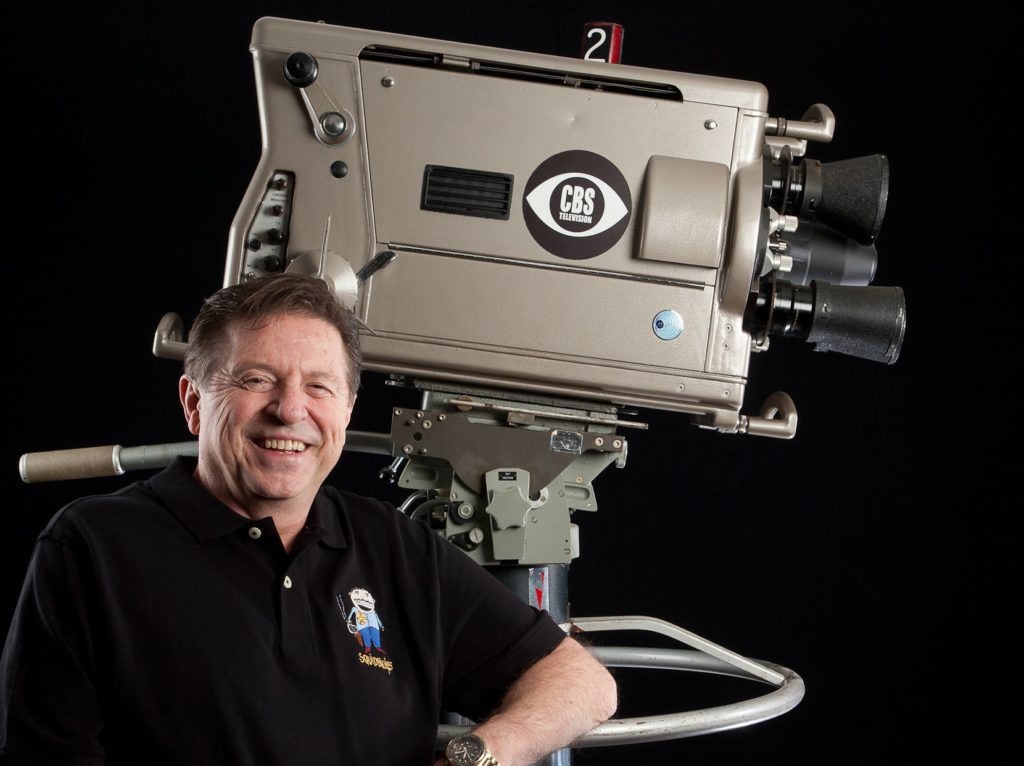

At last! After 49 years of wanting one, I finally have one. One of my favorite sayings is “better late than never.” It sure applies in this case.
This camera is one of only a half dozen that have survived in North America.

In April 2011, I was able to add this beautiful Mark IV to my collection. To me, it is the alpha and the omega…the beginning and the end. This elegant creation is what first stirred my interest in television cameras. Now that I have one, I consider its addition the perfect “last dance” in collecting. I have all I have ever wanted and more.

When I was in the sixth grade in Atlanta, our art teacher taught us a dance similar to a square dance. We were pretty good at it and were invited to tape it as part of a show for teachers around the state. We went to the studios of WGTV, Georgia’s public television station, on a crisp fall morning, and when we began to dance, my heart started to dance too. As we performed perfectly for the cameras, I could not take my eyes off the two Mark IVs they had there. I remember it like it was yesterday. I was struck by how the turret was larger than the camera’s slim body and the way they glided effortlessly up and down and back and forth. I also liked that cool-looking vent on the right side (cameraman’s right) near the front that has the same curve as the turret.

I had actually been on WSB’s ‘The Clubhouse Gang’ twice at around age seven and again around age nine. As you can see below, they had TK10s. Those had already interested me, but it wasn’t until I saw the Mark IVs really move around that I was hooked. The WSB cameras didn’t move much.

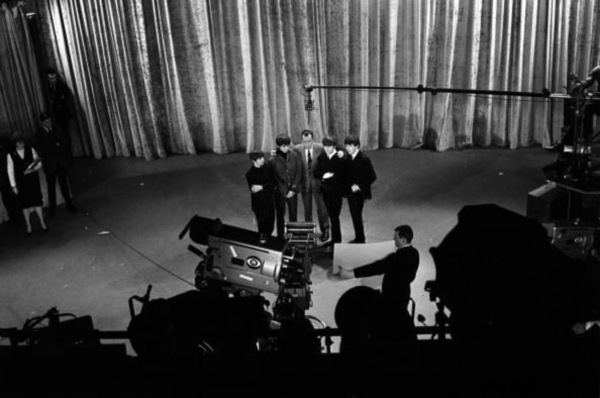
As is my way of doing things, I have dressed this camera to memorialize the six Marconi Mark IV cameras that brought us the Beatles on The Ed Sullivan Show from CBS Studio 50. If you have not already, please see the Marconi page in the Cameras section, and the story of the Beatles cameras in the Gallery.
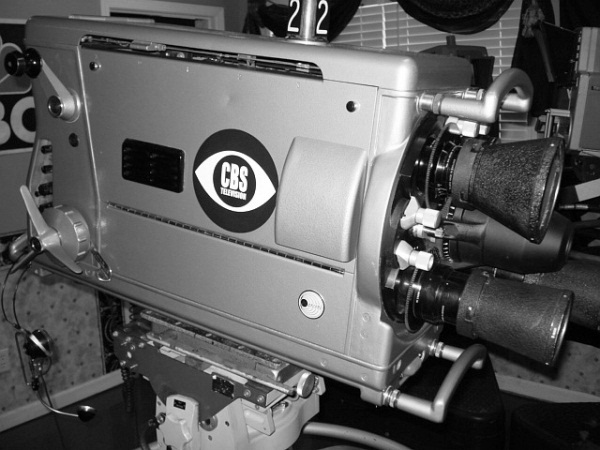
The Mark IVs came out in 1958 and were a huge success worldwide.

Marconi Mark II

Marconi Mark I
The Mark I came out in 1948. It was followed in 1950 by the beautiful Mark ll. Both had 3″ IO tubes and looked almost like a TK10. The Mark lll came in 1953 and looked like a box, but did have a tiltable viewfinder which may have been a first, and it was the first Marconi to offer an optional 4 1/2 inch IO. The rapid succession of models, just a couple of years apart, ended with the Mark IV and its great performance, as it was 1965 before Marconi’s next camera.
Although the Mark IV was in worldwide use, the camera I own is one of only four left in the US. It was owned by WWLP in Springfield, Mass. Europe’s top collector and television historian Dicky Howett and I have been comparing notes, and it seems there are only about 18 left worldwide. Dicky’s Golden Age Television Recreations, one of Europe’s top prop houses, has six Mark lVs, There are two in Australia, two in New Zealand, and in the UK museums, including the BBC, there are perhaps four more.
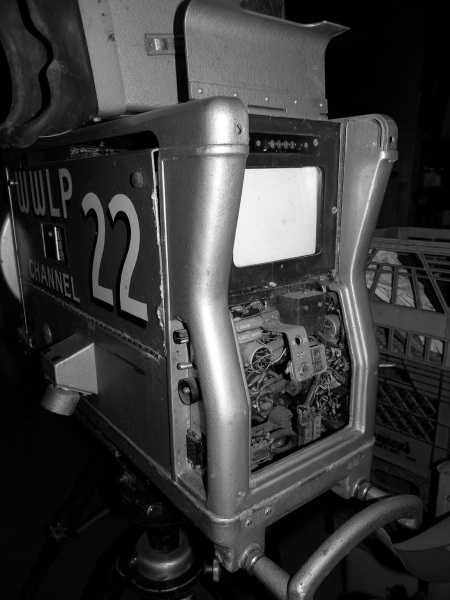
As you can see above, she was in pretty rough shape when she got here. The camera was missing the back panel and had some pretty good dings and scratches, but did have the viewfinder hood. I knew this was going to take a lot of work, but I found a great ally in restoring her. Many thanks to Brad Akin and Paul Senn at Akin Ford for taking on a tough but interesting project. While I was finding a fabricator for the back panel, Paul was ordering the special Hammertone paint from England and creating new side vents. Looks just like a new one. My friend Ellis Walden helped in many ways, too. Thank you all!


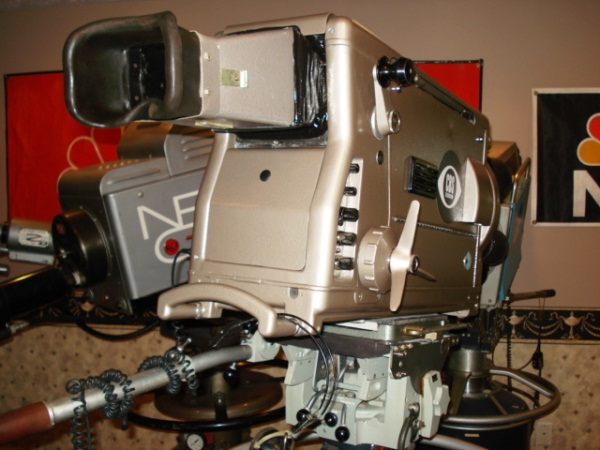
Below is a data sheet from another UK friend, Brian Summers, and his great website Museum of the Broadcast Television Camera. It gives us a lot of interesting details on the Mark IV not found anywhere else.
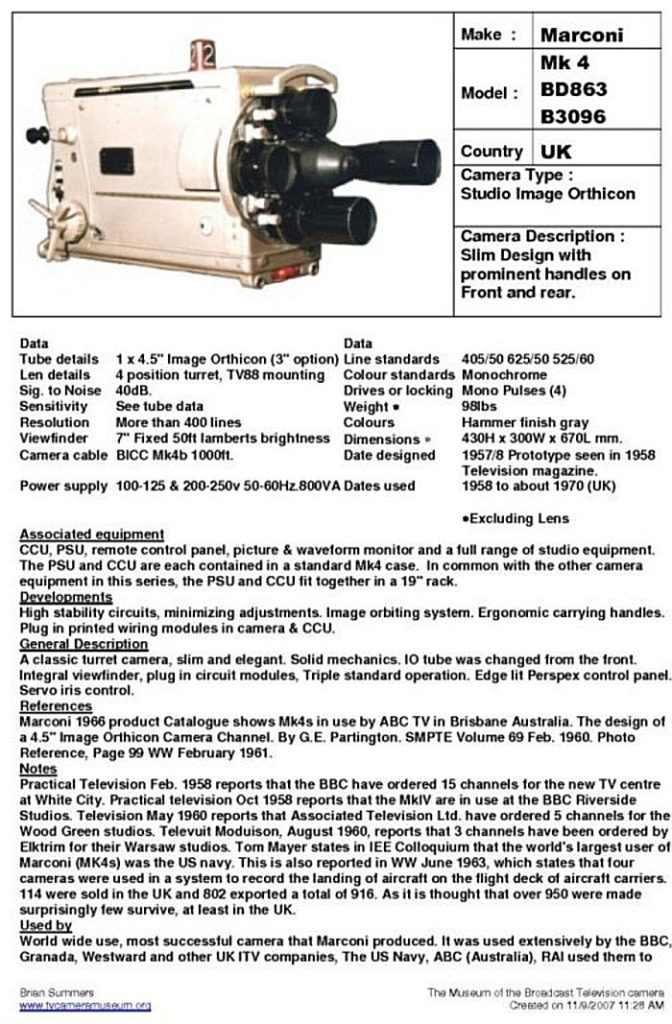
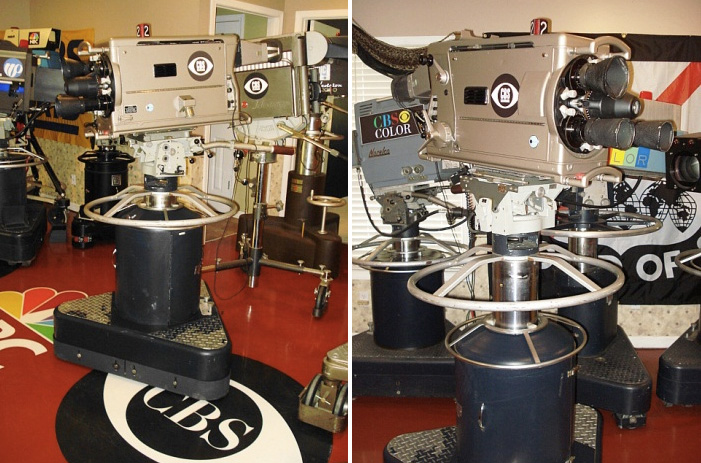
A 1958 Dress Rehearsal, At “The Ed Sullivan Show”
On September 3, 2016
- TV History
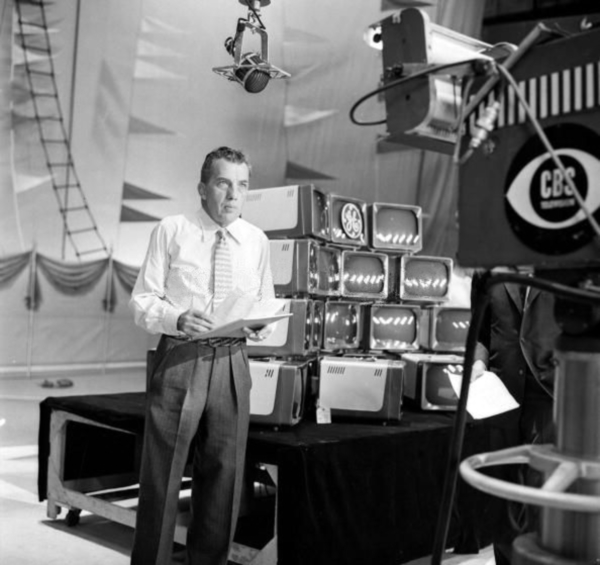
Before all the live shots below were made on a Sunday night in December of 1958, there was a rehearsal. Here, from earlier in the day, is Ed checking the script of his live GE spot against the script on a paper roll teleprompter mounted on a TK30.
Photo courtesy Life Magazine.
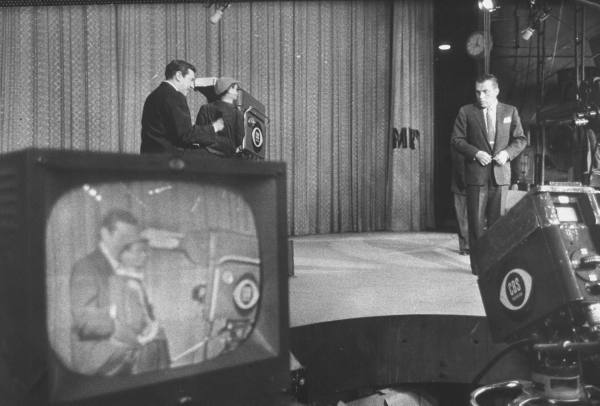
Above is ventriloquist Rickey Layne live on The Ed Sullivan Show. Interestingly, one of CBS’s new TK 11/31s is being used as a prop. Too bad it has a homemade cardboard “helper” on the viewfinder hood. In my humble opinion, the best viewfinder hood style ever developed came on the TK60s, 42s and 44s; it was nice and deep, but the bottom was open and made it easy to see the viewfinder…but, I digress. Notice a TK30 in the foreground for stage level shots.
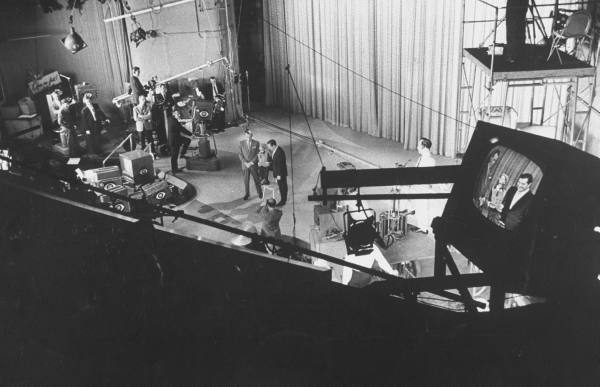
Look closely and you can count six cameras in this picture. The picture just below helps confirm models. There are two TK30s and four TK11/31s on the stage Studio 50. Two TK11/31s are in the upper right, and in the group of three shooting Ed, there’s an 11/31 on the crane, an 11/31 on the camera ramp and a TK30 on the audience floor just below the monitor. There is a TK30 stage right as well, as can be seen below. This facility has had an incredible history and if you want to know all about it, just keep reading this page…it’s all below.

This great shot from the back of the theatre shows a couple of the new TK11/31s together. One is on a Houston Fearless crane and one is on a pedestal, with one of the TK30s in the wings and one on the floor for a stage level shot (just under the crane cameraman’s seat). There are two more TK11/31s on stage left, ready for live spots, as you can see area for commercials on the far left. One of those cameras on stage left is probably only used for shooting title cards.
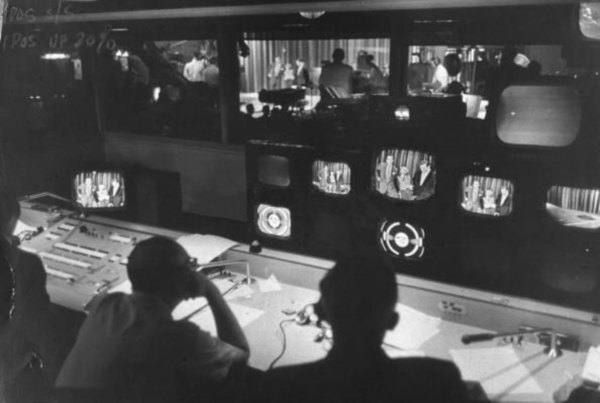
Here is a great shot from the control room.
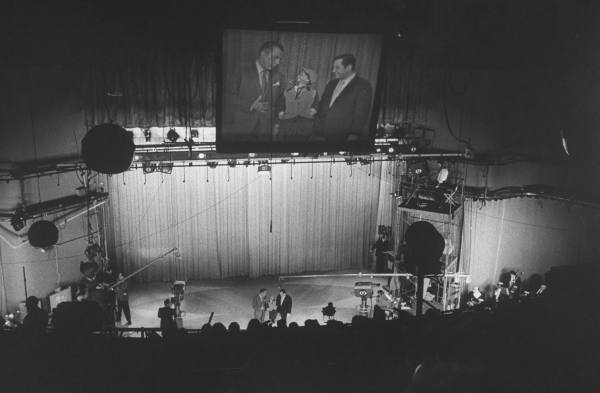
The pictures above and this one from the balcony give us a really great view of how the stage was laid out, and this shows how the balcony audience got to see the show. The round black object in the right foreground is the head of an RCA front screen video projection unit. In the right hand corner, just above the balcony’s rim, you can see a few members of the Ray Bloch Orchestra. On that same side, under the balcony and at the end of the orchestra section, is the audio booth where Art Shine made every singer and band shine for the entire 23-year run of The Ed Sullivan Show. Art also worked the Jackie Gleason program and the Dorsey Brothers’ Stage Show that originated here on Saturday nights.
Below is a history of the show and below that, a history of this still vibrant television landmark. Both are from the official Ed Sullivan web site. It is excellent and brimming with details of every aspect of the show. You can go there by clicking here.
HISTORY OF THE ED SULLIVAN SHOW
The Ed Sullivan Show aired from 1948 until 1971 and changed the landscape of American television. Sullivan’s stage was home to iconic performances by groundbreaking artists from rock ‘n’ roll, comedy, novelty, pop music, politics, sports, opera and more.
There were historic rock ‘n’ roll performances by The Beatles, Elvis Presley, Rolling Stones and The Doors; sensational Motown acts by The Jackson 5, Supremes and Temptations; hilarious stand-up comedy acts by Richard Pryor, Rodney Dangerfield, George Carlin and Carol Burnett; unforgettable Broadway performances by the stars of musicals like My Fair Lady and West Side Story. This list of who stepped on The Ed Sullivan Show stage goes on and on.
You might be wondering – how did The Ed Sullivan Show become the home to the top talent and historical performances of its era?
Often, talk show hosts are charming and competent on camera, yet maybe not the most business-savvy off-screen. Ed Sullivan was just the opposite-pasty in the bright lights, shifty in his stance, and notorious for bungling introductions and monologues.
Ironically, that high discomfort factor helped develop the cult of Ed. There was just something novel about an awkward host, and like a fender bender on the side of the highway, people just couldn’t avert their gaze.
Off camera, Sullivan was a brilliant tracker and arranger of talent. A variety show always has variety, but nothing was as eclectic as the mish-mash that Sullivan put together, from puppet shows to opera, the show had it all.
There were countless acts and performers who made their debuts-or their most famous TV outings-on his show. Ed Sullivan had his finger right on the pulse of what was hot and intriguing in the way of talent, even if he himself didn’t have a discernable pulse onstage. Ed knew how to book ’em better than anyone.
In 1948, CBS hired Sullivan to host its first variety show endeavor, a new format that combined vaudeville with television and was nicknamed “vaudeo.” The show was called The Toast of the Town.
For his inaugural program, Sullivan assembled Dean Martin and Jerry Lewis, Rodgers and Hammerstein, a pianist, a ballerina, a troupe of crooning firemen and a boxing referee whose next gig was the Joe Louis-Jersey Joe Wolcott match. If you wanted to see the phrase “something for everyone” incarnate, there it was.
The critics were rough on Sullivan-they lambasted him for his wooden hosting style and the scattershot tone of his guest menageries. But the show did well anyway.
In 1955, its name changed to The Ed Sullivan Show, and the following year, it broke all of TV’s single night ratings counts when a young Elvis Presley swiveled that famous pelvis on Sullivan’s stage.
June Taylor provided her six dancing “Toastettes,” Ray Bloch led his orchestra, and Sullivan was a Sunday night institution soon enough. Producer Marlo Lewis decided during rehearsals how long each act would last, what order the acts would appear in, and what, out of each performer’s cache of material, should be performed.
A sampling of the people who made their American TV debuts on Sullivan’s show includes: Bob Hope, Lena Horne, Martin and Lewis, Dinah Shore, Albert Schweitzer, Irving Berlin, Fred Astaire and Jane Powell, Eddie Fisher, and most famously, The Beatles.
Most Americans got their first exposure to The Beatles from the historic Ed Sullivan Show broadcast on February 9, 1964. That episode remains one of the most highly watched single shows in TV history. Following which, the “Beatlemania” phenomenon commenced, and the floodgates for other British bands coming to America were opened.
Since hip, cutting-edge musical acts were clearly treating him right, Sullivan responded by booking The Rolling Stones, The Doors, Janis Joplin, Marvin Gaye and Bob Dylan, though Dylan jumped ship when the network wouldn’t let him sing “Talkin’ John Birch Society Blues,” a song about an over-zealous Communist seeker. Not that this was Sullivan’s only problem with emerging rockers: The Stones were banned (temporarily, it turned out) after their rowdy first appearance, and the show’s director asked The Doors to leave out the line “girl we couldn’t get much higher” from “Light My Fire” (they agreed, sang it anyway, and likewise got banned).
Sullivan’s celebrity guests sat in the audience, not backstage in a fancily-catered green room, and sometimes when the acts were introduced, they came right from the audience to the stage. Once in a while, with no prior planning, he’d invite them back up for additional performance.
His interplay with mechanical Italian mouse Topo Gigio, and Senor Wences and his talking box (“S-all right? S-all right!”) showed a soft side on camera, but once again, since the man was a dichotomy, don’t ever think he was all softie.
The Ed Sullivan Show was the quintessential variety show. Whether it was Broadway for the parents, rock ‘n’ roll for the teenagers or Topo Gigio for the kids, the show had something for everyone. From 1948 to 1971, The Ed Sullivan Show was special in that it brought people and families together every Sunday evening. The Ed Sullivan Show was the longest-running variety show in TV history, and an undisputed institution. Towards the end of that long run, with the country divided by Vietnam and shifting value systems, Sullivan’s catchall format didn’t cross the demographic lines like it used to. Time slot rivals The Walt Disney Show and The F.B.I. were gaining momentum, and CBS, eager for youth-oriented programming and fearful that Sullivan was a vestige of older generations, canceled the show.
No matter. Guts and diversity like that, which goes for the show and the man, tend to stick around in a person’s (and a country’s) consciousness.
The Studio 50/Ed Sullivan Theater history and Time Line
The Ed Sullivan Theater is located at 1697-1699 Broadway between West 53rd and West 54th, in Manhattan, New York. The theater is a 13-story brick building that was designed by architect Herbert Krapp and built by Arthur Hammerstein. Arthur Hammerstein named the theater in honor of his father, Oscar Hammerstein.
Hammerstein’s Theater opened its doors on November 30, 1927 with a three-hour musical play called “The Golden Dawn.” One of the stars of the show that evening was Archie Leach, who later became better known as the famous actor Cary Grant.
In 1931, Arthur Hammerstein, who was facing financial troubles, lost ownership of the building. Over the next five years the theater underwent numerous name changes until in 1935, when CBS secured a long-term contract on the building and began using the theater for radio broadcasts. In 1950, with the growing popularity of a new medium, CBS converted the theater into a television studio named CBS-TV Studio 50.
Ed Sullivan, who had been hosting his variety show “Toast of the Town” out of CBS’s Maxine Elliott Theater (also known as CBS Studio 51), moved into Studio 50 in 1953. The studio went on to become the home of The Ed Sullivan Show for the rest of the variety show’s 23-year run.
On December 10, 1967, to mark The Ed Sullivan Show‘s 20th year, the studio was named The Ed Sullivan Theater in honor of the great host. Like its namesake, The Ed Sullivan Theater has withstood the test of time and to this day remains the studio’s name.
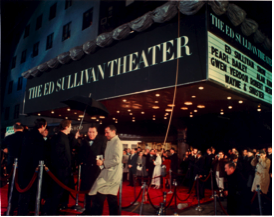
A Timeline of The Ed Sullivan Theater
- 1925-1927 – Arthur Hammerstein builds Hammerstein’s Theater in honor of his father, Oscar Hammerstein I.
- November 30, 1927 – Hammerstein’s Theater opens its doors with a three-hour musical play called The Golden Dawn featuring Archie Leach, who later became known as Cary Grant.
- 1931 – Hammerstein’s Theater is renamed Manhattan Theater.
- 1934 – Manhattan Theater is renamed Billy Rose’s Music Hall and becomes a nightclub.
- 1936 – Billy Rose’s Music Hall is renamed the WPA Theater.
- 1936 – CBS takes over the theater and converts it to a radio theater using various names, including Radio Theater #3 and CBS Radio Playhouse.
- 1950 – With the advent of television, the theater is converted to a television studio named Studio 50.
- 1953 – Studio 50 becomes the home of The Ed Sullivan Show.
- 1960s – Studio 50 also becomes the home of The Merv Griffin Show, To Tell The Truth, What’s My Line and Password.
- 1965 – The studio is converted to a color studio for the beginning of the television season.
- December 10, 1967 – Studio 50 receives its latest name, The Ed Sullivan Theater, to honor its host’s twentieth year. Some people say it was the proudest moment of Ed’s life.
- 1970s – The $10,000 Pyramid and a few other game shows call The Ed Sullivan Theater home.
- 1981 – CBS’s lease expires and the theater is taken over by Reeves Entertainment.
- 1980s – The sitcom Kate and Allie is taped in the theater from 1984 to 1989.
- 1993 – David Letterman leaves NBC to join CBS. CBS buys the theater for $4 million and redesigns the space to hold a 400-seat audience.
- July 15, 2009 – Sir Paul McCartney returns to play on the roof of The Ed Sullivan Theater more than 45 years after The Beatles’ Ed Sullivan Show performance on February 9th, 1964.
- 2015 – David Letterman retires after hosting The Late Show for nearly 22 years. CBS has the theater renovated again during the summer months to prepare it for Stephen Colbert’s tenure as host, which begins that fall.
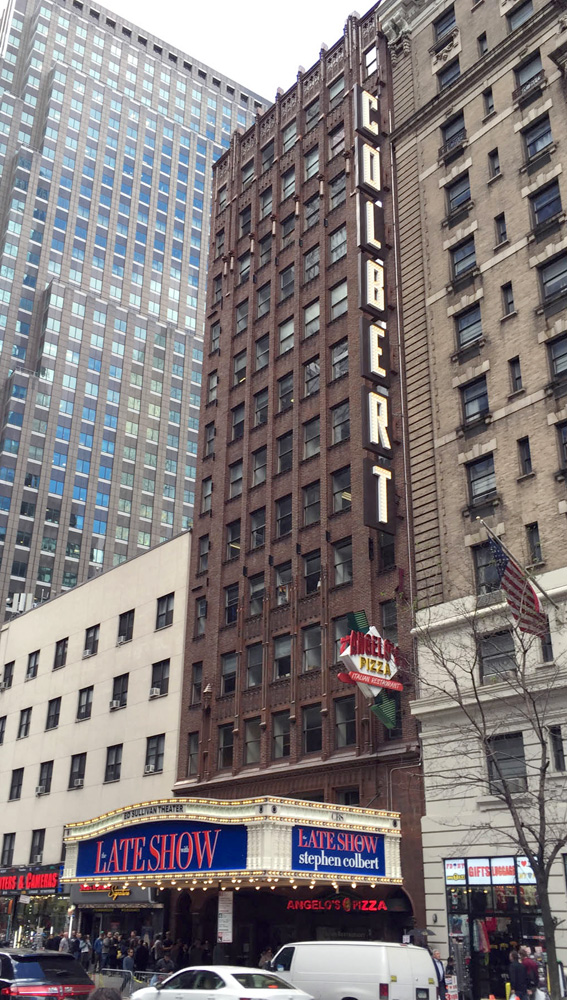
Ed Sullivan and CBS Studio 50
On June 28, 2016

Before all the live shots below were made on a Sunday night in December of 1958, there was a rehearsal. Here, from earlier in the day, is Ed checking the script of his live GE spot against the script on a paper roll teleprompter mounted on a TK30.
Photo courtesy Life Magazine.

Above is ventriloquist Rickey Layne live on The Ed Sullivan Show. Interestingly, one of CBS’s new TK 11/31s is being used as a prop. Too bad it has a homemade cardboard “helper” on the viewfinder hood. In my humble opinion, the best viewfinder hood style ever developed came on the TK60s, 42s and 44s; it was nice and deep, but the bottom was open and made it easy to see the viewfinder…but, I digress. Notice a TK30 in the foreground for stage level shots.
Photo courtesy of Life Magazine

Look closely and you can count six cameras in this picture. The picture just below helps confirm models. There are two TK30s and four TK11/31s on the stage Studio 50. Two TK11/31s are in the upper right, and in the group of three shooting Ed, there’s an 11/31 on the crane, an 11/31 on the camera ramp and a TK30 on the audience floor just below the monitor. There is a TK30 stage right as well, as can be seen below. This facility has had an incredible history and if you want to know all about it, just keep reading this page…it’s all below.
Photo courtesy Life Magazine.

This great shot from the back of the theatre shows a couple of the new TK11/31s together. One is on a Houston Fearless crane and one is on a pedestal, with one of the TK30s in the wings and one on the floor for a stage level shot (just under the crane cameraman’s seat). There are two more TK11/31s on stage left, ready for live spots, as you can see area for commercials on the far left. One of those cameras on stage left is probably only used for shooting title cards.
Photo courtesy of Life Magazine

Here is a great shot from the control room.
Photo courtesy of Life Magazine

The pictures above and this one from the balcony give us a really great view of how the stage was laid out, and this shows how the balcony audience got to see the show. The round black object in the right foreground is the head of an RCA front screen video projection unit. In the right hand corner, just above the balcony’s rim, you can see a few members of the Ray Bloch Orchestra. On that same side, under the balcony and at the end of the orchestra section, is the audio booth where Art Shine made every singer and band shine for the entire 23-year run of The Ed Sullivan Show. Art also worked the Jackie Gleason program and the Dorsey Brothers’ Stage Show that originated here on Saturday nights.
Photo courtesy Life Magazine.
Below is a history of the show and below that, a history of this still vibrant television landmark. Both are from the official Ed Sullivan web site. It is excellent and brimming with details of every aspect of the show. You can go there by clicking here.
HISTORY OF THE ED SULLIVAN SHOW
The Ed Sullivan Show aired from 1948 until 1971 and changed the landscape of American television. Sullivan’s stage was home to iconic performances by groundbreaking artists from rock ‘n’ roll, comedy, novelty, pop music, politics, sports, opera and more.
There were historic rock ‘n’ roll performances by The Beatles, Elvis Presley, Rolling Stones and The Doors; sensational Motown acts by The Jackson 5, Supremes and Temptations; hilarious stand-up comedy acts by Richard Pryor, Rodney Dangerfield, George Carlin and Carol Burnett; unforgettable Broadway performances by the stars of musicals like My Fair Lady and West Side Story. This list of who stepped on The Ed Sullivan Show stage goes on and on.
You might be wondering – how did The Ed Sullivan Show become the home to the top talent and historical performances of its era?
Often, talk show hosts are charming and competent on camera, yet maybe not the most business-savvy off-screen. Ed Sullivan was just the opposite-pasty in the bright lights, shifty in his stance, and notorious for bungling introductions and monologues.
Ironically, that high discomfort factor helped develop the cult of Ed. There was just something novel about an awkward host, and like a fender bender on the side of the highway, people just couldn’t avert their gaze.
Off camera, Sullivan was a brilliant tracker and arranger of talent. A variety show always has variety, but nothing was as eclectic as the mish-mash that Sullivan put together, from puppet shows to opera, the show had it all.
There were countless acts and performers who made their debuts-or their most famous TV outings-on his show. Ed Sullivan had his finger right on the pulse of what was hot and intriguing in the way of talent, even if he himself didn’t have a discernable pulse onstage. Ed knew how to book ’em better than anyone.
In 1948, CBS hired Sullivan to host its first variety show endeavor, a new format that combined vaudeville with television and was nicknamed “vaudeo.” The show was called The Toast of the Town.
For his inaugural program, Sullivan assembled Dean Martin and Jerry Lewis, Rodgers and Hammerstein, a pianist, a ballerina, a troupe of crooning firemen and a boxing referee whose next gig was the Joe Louis-Jersey Joe Wolcott match. If you wanted to see the phrase “something for everyone” incarnate, there it was.
The critics were rough on Sullivan-they lambasted him for his wooden hosting style and the scattershot tone of his guest menageries. But the show did well anyway.
In 1955, its name changed to The Ed Sullivan Show, and the following year, it broke all of TV’s single night ratings counts when a young Elvis Presley swiveled that famous pelvis on Sullivan’s stage.
June Taylor provided her six dancing “Toastettes,” Ray Bloch led his orchestra, and Sullivan was a Sunday night institution soon enough. Producer Marlo Lewis decided during rehearsals how long each act would last, what order the acts would appear in, and what, out of each performer’s cache of material, should be performed.
A sampling of the people who made their American TV debuts on Sullivan’s show includes: Bob Hope, Lena Horne, Martin and Lewis, Dinah Shore, Albert Schweitzer, Irving Berlin, Fred Astaire and Jane Powell, Eddie Fisher, and most famously, The Beatles.
Most Americans got their first exposure to The Beatles from the historic Ed Sullivan Show broadcast on February 9, 1964. That episode remains one of the most highly watched single shows in TV history. Following which, the “Beatlemania” phenomenon commenced, and the floodgates for other British bands coming to America were opened.
Since hip, cutting-edge musical acts were clearly treating him right, Sullivan responded by booking The Rolling Stones, The Doors, Janis Joplin, Marvin Gaye and Bob Dylan, though Dylan jumped ship when the network wouldn’t let him sing “Talkin’ John Birch Society Blues,” a song about an over-zealous Communist seeker. Not that this was Sullivan’s only problem with emerging rockers: The Stones were banned (temporarily, it turned out) after their rowdy first appearance, and the show’s director asked The Doors to leave out the line “girl we couldn’t get much higher” from “Light My Fire” (they agreed, sang it anyway, and likewise got banned).
Sullivan’s celebrity guests sat in the audience, not backstage in a fancily-catered green room, and sometimes when the acts were introduced, they came right from the audience to the stage. Once in a while, with no prior planning, he’d invite them back up for additional performance.
His interplay with mechanical Italian mouse Topo Gigio, and Senor Wences and his talking box (“S-all right? S-all right!”) showed a soft side on camera, but once again, since the man was a dichotomy, don’t ever think he was all softie.
The Ed Sullivan Show was the quintessential variety show. Whether it was Broadway for the parents, rock ‘n’ roll for the teenagers or Topo Gigio for the kids, the show had something for everyone. From 1948 to 1971, The Ed Sullivan Show was special in that it brought people and families together every Sunday evening. The Ed Sullivan Show was the longest-running variety show in TV history, and an undisputed institution. Towards the end of that long run, with the country divided by Vietnam and shifting value systems, Sullivan’s catchall format didn’t cross the demographic lines like it used to. Time slot rivals The Walt Disney Show and The F.B.I. were gaining momentum, and CBS, eager for youth-oriented programming and fearful that Sullivan was a vestige of older generations, canceled the show.
No matter. Guts and diversity like that, which goes for the show and the man, tend to stick around in a person’s (and a country’s) consciousness.
The Studio 50/Ed Sullivan Theatre history and Time Line
The Ed Sullivan Theater is located at 1697-1699 Broadway between West 53rd and West 54th, in Manhattan, New York. The theater is a 13-story brick building that was designed by architect Herbert Krapp and built by Arthur Hammerstein. Arthur Hammerstein named the theater in honor of his father, Oscar Hammerstein.
Hammerstein’s Theater opened its doors on November 30, 1927 with a three-hour musical play called “The Golden Dawn.” One of the stars of the show that evening was Archie Leach, who later became better known as the famous actor Cary Grant.
In 1931, Arthur Hammerstein, who was facing financial troubles, lost ownership of the building. Over the next five years the theater underwent numerous name changes until in 1935, when CBS secured a long-term contract on the building and began using the theater for radio broadcasts. In 1950, with the growing popularity of a new medium, CBS converted the theater into a television studio named CBS-TV Studio 50.
Ed Sullivan, who had been hosting his variety show “Toast of the Town” out of CBS’s Maxine Elliott Theater (also known as CBS Studio 51), moved into Studio 50 in 1953. The studio went on to become the home of The Ed Sullivan Show for the rest of the variety show’s 23-year run.
On December 10, 1967, to mark The Ed Sullivan Show‘s 20th year, the studio was named The Ed Sullivan Theater in honor of the great host. Like its namesake, The Ed Sullivan Theater has withstood the test of time and to this day remains the studio’s name.

A Timeline of The Ed Sullivan Theater
- 1925-1927 – Arthur Hammerstein builds Hammerstein’s Theater in honor of his father, Oscar Hammerstein I.
- November 30, 1927 – Hammerstein’s Theater opens its doors with a three-hour musical play called The Golden Dawn featuring Archie Leach, who later became known as Cary Grant.
- 1931 – Hammerstein’s Theater is renamed Manhattan Theater.
- 1934 – Manhattan Theater is renamed Billy Rose’s Music Hall and becomes a nightclub.
- 1936 – Billy Rose’s Music Hall is renamed the WPA Theater.
- 1936 – CBS takes over the theater and converts it to a radio theater using various names, including Radio Theater #3 and CBS Radio Playhouse.
- 1950 – With the advent of television, the theater is converted to a television studio named Studio 50.
- 1953 – Studio 50 becomes the home of The Ed Sullivan Show.
- 1960s – Studio 50 also becomes the home of The Honeymooners, The Merv Griffin Show, To Tell The Truth, What’s My Line and Password.
- 1965 – The studio is converted to a color studio for the beginning of the television season.
- December 10, 1967 – Studio 50 receives its latest name, The Ed Sullivan Theater, to honor its host’s twentieth year. Some people say it was the proudest moment of Ed’s life.
- 1970s – The $10,000 Pyramid and a few other game shows call The Ed Sullivan Theater home.
- 1981 – CBS’s lease expires and the theater is taken over by Reeves Entertainment.
- 1980s – The sitcom Kate and Allie is taped in the theater from 1984 to 1989.
- 1993 – David Letterman leaves NBC to join CBS. CBS buys the theater for $4 million and redesigns the space to hold a 400-seat audience.
- July 15, 2009 – Sir Paul McCartney returns to play on the roof of The Ed Sullivan Theater more than 45 years after The Beatles’ Ed Sullivan Show performance on February 9th, 1964.
- 2015 – David Letterman retires after hosting The Late Show for nearly 22 years. CBS has the theater renovated again during the summer months to prepare it for Stephen Colbert’s tenure as host, which begins that fall.

Marconi Cameras
On June 20, 2016
There is no mistaking the fame of the name. Guglielmo Marconi was known worldwide as the father of radio, and started his company, Wireless Telegraph and Signal Company, in 1897. In 1920 RCA acquired the assets of Marconi’s business in America, which was their radio division. In 1946, English Electric bought the company to complement their broadcasting division and began development of the Marconi-branded 3-inch image orthicon cameras. In 1948 the Mark I was introduced, the Mark II in ’50 and the Mark III in ’53.
The cameras were known and used widely in the UK and Europe, but it was not until the 1958 introduction of the Mark IV with its 4 ½ inch image orthicon tube that the Americas warmed up to Marconis. CBS loved the Marconi Mark IV because, like when the Norelco color cameras debuted in ’65, there was finally something to buy other than RCA. Canadians and some South American counties bought a lot of them too.
The next major camera from Marconi was the Mark VII color camera and CBS began to buy these too around 1967 to augment their huge stock of Norelco PC 60s and 70s. By ’69, The Ed Sullivan Theatre and a few other CBS broadcast centers were all using Marconi Mark VIIs. For the complete line up of Marconi, and many other makes and models, visit Brian Summers’ excellent UK site at https://www.tvcameramuseum.org/marconi/marconithumb.htm
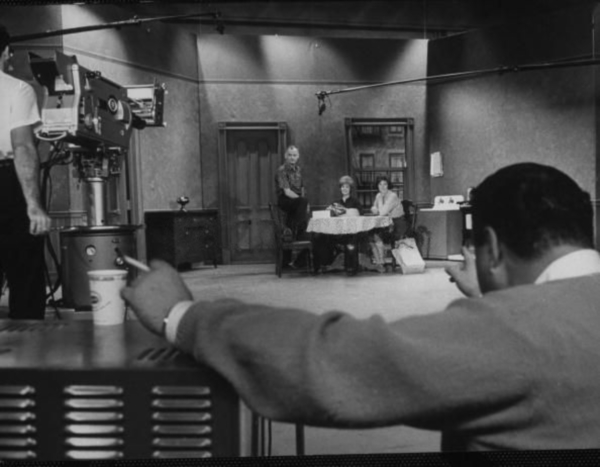 Photo courtesy CBS Broadcasting Inc. All rights reserved. Credit: CBS Photo Archive. This image cannot be archived, sold, leased or shared.
Photo courtesy CBS Broadcasting Inc. All rights reserved. Credit: CBS Photo Archive. This image cannot be archived, sold, leased or shared.
On this page and this site, there is a lot of mention of CBS Studio 50 (also known as The Ed Sullivan Theater), and for good reason. It is hallowed ground. In case you did not know, one of the other famous shows that originated there was The Honeymooners with Jackie Gleason and, later, The Jackie Gleason Show before the show moved to Miami. Above, “The Great One” directs a Honeymooners rehearsal with a Marconi Mark IV on the set.
If you saw the Beatles on Ed Sullivan live, like I did, you saw them through a Marconi Mark IV.
In these two historic shots above, we see the Marconi Mark IVs at CBS Studio 50 bringing America the Beatles on Ed Sullivan for the first time. Below, on a different appearance, we see the a Houston Fearless crane-mounted Mark IV getting such a close shot of Ringo that there are shadows on John’s face. If you would like to know where the cameras that were in the Ed Sullivan Theater wound up, please visit the GALLERY and see the “Marconi Surprise” feature. In the final photo (bottom) from this sequence, here is a Beatles rehearsal image taken from the balcony. In the foreground is the unmanned crane camera and under it, a ped-mounted Mark IV that seems to be taping a promo, perhaps.
Mickey Rooney with Judy on the June 24, 1963 broadcast of The Judy Garland Show. A Marconi Mark IV mounted on a Chapman crane takes the shot at Television City even though from its inception, the show had been planned to produce in New York. Up against powerhouse Bonanza, the show only lasted one season with 26 episodes.
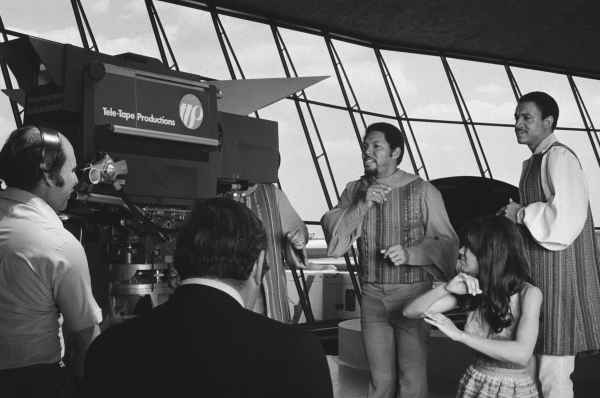 Photo courtesy NBCU Photo Bank.com. All rights reserved. This image may not be archived, leased, copied or shared.
Photo courtesy NBCU Photo Bank.com. All rights reserved. This image may not be archived, leased, copied or shared.
Shot for insertion into the 12th Annual Grammy Awards in 1970, The Fifth Dimension tapes “Aquarius/Let the Sunshine In” at J.F.K. Airport…it was the Song Of The Year. From left to right: a new Marconi Mark VII color camera from New York’s famous Tele Tape Productions, Billy Davis Jr., Marilyn McCoo, and Lamonte McLemore.
![Intel(R) JPEG Library, version [1.51.12.44]](http://eyesofageneration.com/wp-content/uploads/2016/06/xxx.jpg)
Tele Tape Productions Mark VIIs again in use on the Sesame Street set for this crew shot sometime before the 1973 switch to RCA TK44s. One of the cameras in this photo is now in my collection, and can be seen by clicking here.
Photo courtesy Joe LaRe’
On my birthday in 1965, The Ed Sullivan Show broadcast live in color for the first time from Studio 50, now known as The Ed Sullivan Theatre. That was October 31, 1965 and Norelco PC60s were the cameras, but just three short years later, in 1968, they switched from Norelco to Marconi, and here from 1969 is a Marconi Mark VII shooting The Band on Sullivan. This and the two photos below are the only pictures I’ve ever seen of Mark VIIs at CBS.
Photo courtesy CBS Photo Archives. All Rights Reserved. This image cannot be archived, sold, leased or shared.
I had originally thought the photo above was taken at Television City, but now know that it, and the one below, are from the Ed Sullivan Theatre. In the summer of 1971, just after the final Sullivan show aired on June 6th of that year, CBS taped a summer special there called “Model Of The Year,” hosted by Hugh O’Brien. Thanks to Bob Franklin at ABC for setting me straight on this and for letting me know that the Mark VIIs came to Studio 50 in 1968. Also, thanks to Gady Reinhold for the pictures and his recollections of his days there.
Photos courtesy CBS Retirees Website. All Rights Reserved. This image cannot be archived, sold, leased or shared.
Above is a Marconi Mark IV black and white camera at work for ABC at the 1964 Winter Olympics in Innsbruck, Austria with a Varotal Mark III lens.
Photo courtesy of Marvin Parker.
Bob Dylan on Ed Sullivan in 1963.
Photo courtesy of CBS Photo Archives. All Rights Reserved. This image cannot be archived, sold, leased or shared.
There is something VERY, VERY, VERY special about these 3 Marconi Mark IV cameras being used at WCNY in Syracuse, New York. To find out what, visit The Gallery section and look for the WCNY Surprise Story, but here is your first clue: Studio 50. Photo courtesy of Mike Clark.
In the these three photos (one above, two below), you’ll see these WCNY Marconi cameras at work on Christmas and PBS fund raising specials. You won’t believe the history these cameras have, but here is another clue….Beatles. Photos courtesy of Mike Clark.
Mark IV in use at CBS circa 1964
Courtesy Life Magazine
These are yet two more very special Marconi Mark IV cameras, or, one in the same. On November 24, 1963, this WFAA (ABC) camera was one of only 3 that were in the garage of Dallas police headquarters. Soon after this image was snapped, the world saw Jack Ruby shoot Lee Harvey Oswald. KRLD/CBS had a GE PC 12 there operated by John English, and WBAP/NBC had a TK30 there operated by Homer Venso. When the shooting occurred, only the WBAP camera was feeding live to a network (NBC), as the other two cameras images were going to tape. In videos of the incident, you may remember that one of the cameras racked (changed lenses to a medium shot) just seconds before Ruby shot Oswald…that camera was the WBAP TK30 shot. Homer Venso told me that his director told him to change lenses, even though they were feeding NBC live. Homer managed to rack and focus just in time. Above is the WFAA Marconi on that fateful Sunday in Dallas. Below we see either this exact camera today, or one of its two sisters from the WFAA mobile unit. This historic camera and the WFAA Telecruiser are part of the Chuck Conrad Collection and can be seen here. https://texasbroadcastmuseum.com/
Why are half these men are sitting down? The “sitters” were probably the ones that put these 18 Marconi Mark VIII cameras on this three-level platform…quite a job at over 400 pounds per camera and ped. In the early 1970s, the CBC moved to a new 8-studio building in Montreal, and the two cameras considered were the RCA TK44 and the Mark VIII. The ones standing were probably “supervisors.”
Photo courtesy of Serge Bordeleau.
THE EARLY MARCONI COLOR CAMERAS
The photos and facts below are from email messages shared with me by my flesh friend Paul Beck, and my virtual friend Dicky Howett in the UK. Both know more about television than almost anyone else I know. They are discussing these exchanged images of the early Marconi color camera, the BD-848, also called “the British version of the TK41.” To be clear, these are all BD 848 cameras, the difference being…the camera body stayed the same but the viewfinder configurations changed. The early versions had the TK41 rounded viewfinders, but were later made (and modified) with a newer style tilting viewfinder version.
This is the early (circa 1961) version of the Marconi BD 848.
Above and below, two great shots from front and rear of the BD 848s at the BBC. The camera below is from an experimental BBC color show in 1965 at Studio H, Lime Grove and is mounted on a 1956 vintage Vinten HP 419 ped, steered by a tiller. Bet that was a heavy going!
TeleTales #57…A Two Bird, One Stone Surprise
On February 6, 2015
- TV History
TeleTales #57…A Two Bird, One Stone Surprise
https://www.youtube.com/watch?v=d0vggMCiJfs&ab_channel=vaimusic
First, at the link is a song that many people think was a Beatles original, but it’s not…it’s from “The Music Man”. The performance is by opera star Barbra Cook on “The Bell Telephone Hour” which began April 29, 1940 on NBC Radio and was heard there until June 30, 1958 when it moved to television for a nine year run.
Below is nice shot of Barbara Cook from one one of her many appearances on the Bell Hour which originated at NBC Brooklyn. The Bell hour was one of the first shows to be broadcast exclusively in color. I think “The Howdy Doody Show” was the first daily color broadcast starting September 12, 1955. To make sure you are seeing all the stories, please visit the main page by clicking on the blue text at the top of this post -Bobby Ellerbee
Ever See One Of These? This Is The GE PE 25 Color Camera
On September 20, 2014
- TV History
Ever See One Of These? This Is The GE PE 25 Color Camera
There are not many photos of this camera, but thanks to David Crosthwait at DC Video, we have a new black and white photo taken at KCOP in Los Angeles. The color photo (the only one we know of) shows our friend Mike Clark with a PE 25 at WCNY Syracuse NY. By the way, the Marconi Mark IVs in the background are from ‘The Ed Sullivan Show’….those are The Beatles cameras.
GE had a camera called the PE 15 that looked almost like this but it’s handles were at the top of the doors instead of underneath. This camera debuted in 1965 and as usual for GE cameras, were mostly used in west and southwest markets. If anyone know if one of these cameras survives, please let me know. Enjoy and share! -Bobby Ellerbee


September 13, 1966…’The Monkees’ Debuts On NBC
On September 13, 2014
- TV History
September 13, 1966…’The Monkees’ Debuts On NBC
Before the background, a note on the video. At the start is some of the screen test shots of the guys and this is followed by the series pilot which never aired. The theme song is a demo by Boyce and Hart. Don Kirshner was in charge of the music for the show. Enjoy and share! -Bobby Ellerbee
Although the series only ran from ’66 till ’68, it was indeed the start of something big. Aspiring filmmaker Bob Rafelson developed the initial idea for The Monkees in 1962, but was unsuccessful in selling the series, but then came The Beatles ‘A Hard Days Night’ and everything changed.
The show was sold to Screen Gems Television on April 16, 1965. Rafelson’s original idea was to cast an existing New York based group, The Lovin’ Spoonful, which was not widely known at the time, but the canny John Sebastian had already signed the Spoonful to a record company, which would have denied Screen Gems the right to market music from the show on record.
On July 14, 1965, The Hollywood Reporter stated that future band member Davy Jones was expected to return to the United States in September 1965 after a trip to England “to prepare for a TV pilot for Bert Schneider and Bob Rafelson.”
Jones had previously starred as the Artful Dodger in the Broadway show ‘Oliver!’, which began on December 17, 1962, and his performance was later seen on The Ed Sullivan Show the same night as The Beatles’ first appearance on that show, February 9, 1964. He was Tony-nominated for best supporting actor in a musical in 1963.
In September 1964, he was signed to a long-term contract to appear in TV programs for Screen Gems, make feature films for Columbia Pictures and to record music for the Colpix label. Hence, Rafelson and Schneider already had him in mind for their project after their plans for the Lovin’ Spoonful fell through; when they chose him, he was essentially a proto-star looking for his lucky break.
On September 8–10, 1965, Daily Variety and The Hollywood Reporter ran an ad to cast the remainder of the band/cast members for the TV show: “Madness!! Auditions. Folk & Roll Musicians-Singers for acting roles in new TV series. Running Parts for 4 insane boys, age 17-21. Want spirited Ben Frank’s types. Have courage to work. Must come down for interview.”
Out of 437 applicants, the other three chosen for the band/cast of the TV show were Michael Nesmith, Peter Tork and Micky Dolenz. Nesmith had been working as a musician since early 1963, and had been recording and releasing music under various names, including Michael Blessing and “Mike & John & Bill” and had studied drama in college; contrary to popular belief, of the final four, Nesmith was the one member who actually saw the ad in the Daily Variety and The Hollywood Reporter.
Tork, the last to be chosen, had been working the Greenwich Village scene as a musician, and had shared the stage with Pete Seeger; he learned of The Monkees from Stephen Stills, whom Rafelson and Schneider had rejected.
Dolenz was an actor who had starred in the TV series ‘Circus Boy’ as a child, using the stage name Mickey Braddock, and he had also played guitar and sung in a band called “The Missing Links” before the Monkees, which had recorded and released a very minor single, “Don’t Do It.” By that time, he was again using his real name of Micky Dolenz; he found out about The Monkees through his agent.
Classic! The Marconi Mark IV
On July 8, 2014
- TV History
Classic! The Marconi Mark IV
Here is another of the beautiful portraits Parker Smith took of my camera collection. This is one of my favorites. In the US, there are only 6 of the Marconi Mark IVs known to have survived…this is one of them. Please click to enlarge for a clearer image.
Unfortunately, none of the Ed Sullivan Mark IV cameras which shot The Beatles survived. That I know of, none of the CBS New York or Television City Mark IVs made it either. I repainted this camera and dressed it to honor the Sullivan, Beatle cameras.
This was Marconi’s answer to the RCA TK60 and both made great pictures with their 4 1/2 inch Image Orthicon tubes. Enjoy and share.
